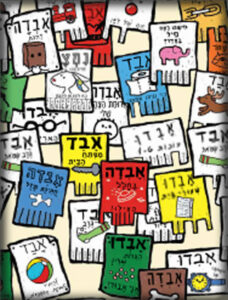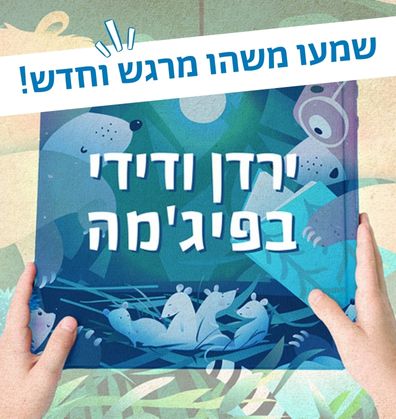כִּשּׁוּרֵי חַיִּים
סְּפָרִים
Book-Related Family Activities

Fighting and Reconciling
Talk with your children and ask: How do you feel when you fight with a friend or family member? How do you both behave during a quarrel? Can anything help you reconcile? How can we help friends who are fighting reconcile?
QR code
Scan the code to listen to a special episode on quarreling from the podcast Yarden and Didi in Pajamas.

Making Peace
This book can inspire you to take two puppets, toy cars, or any pair of items; you can even put a pair of socks on your hands. Invite your children to imagine and make up a “real fight” – what are they fighting about? How do they reconcile? Do they reconcile on their own or do they need help doing so? Now you are ready to put on a show.

Exploring and Discovering
Hyraxes and ibexes are desert animals that live in Israel. This book provides a wonderful opportunity to explore and discover! What do they look like in real life? What characterizes them? What do they enjoy eating? What other interesting facts would you like to know about them?

Arts & crafts, songs, and other activities can be found on the Sifriyat Pijama Pinterest page.

Tip for Family Reading
After reading this book, you should discuss how the characters felt and coped with the situations in the story. You can discuss how you were inspired by them. Children identify with the characters, will be exposed to different perspectives, and will learn from them about emotions and behaviors that are familiar to them from their own lives.

It was a good idea to let him go first
After reading the story, you can discuss, share, and ask: How do we feel when we wait in line? Have we ever felt that our turn was more urgent than the others’? In your opinion, how did Dog feel when the others were considerate toward him? How did Monkey and the others who were waiting in line feel after giving up their turn? Try to recall an incident together in which you were considerate toward others, or others were considerate toward you.

Who is next in line?
Monkey, Giraffe, Elephant, and Alligator try to establish a principle that would determine the order among those waiting in line. They can inspire you to play an amusing game with your whole family, during which you can form a line while following a different order each time. For instance, you can stand according to your age from youngest to oldest, or by the color of your shirts from the lightest to the darkest, or by how much you love ice cream. You can come up with different, amusing characteristics together and find out who is next in line this time?

Waiting around and having fun
How does Monkey end up passing the time while waiting in line? He chats with those who are waiting alongside him, coming up with ideas on how to determine the order, and meeting new friends. You can also think together and raise ideas that would help you pass the time while you are waiting for something. You can come up with a funny song to sing while you wait, or a game involving moving your fingers, or even prepare aids that will help you pass the time – a storybook, coloring book, puzzle, or squishy ball, or any other amusing idea with which you can come up.
QR Code
Would you like to find out what Monkey sounds like? Or what Dr. Tzviya sounds like? Scan the code and listen to the story.

Family reading advice
Illustrations are an integral part of books, completing details that are not always found in the text itself. For instance, the building blocks Taylor uses only appear in the illustrations. Did you discover any other details through the illustrations? Sometimes, it’s worth trying to read a story “over again” using the illustrations and seeing what else we can discover about.

Discussion – When things fall apart
Sometimes, things we put a lot of time and effort into fall apart or fail. We can discuss that by asking – Has anything similar to what happened to Taylor ever happened to you? How did you feel? When you’re upset or frustrated – what helpscheer you up? Which of the animals in the book would you have called out to for help?


Listening exercises
Listening exercises can help us sharpen our senses and notice new things: Try speaking to one another while sitting back-to-back, and then face-to-face. How did you feel each time? Another exercise is: Close your eyes for one minute, be completely silent and still, and try only to listen to the sounds around you. When the time is up, tell the others what you heard.

Animal mimicking
What does the ostrich look like when it buries its head in the sand? What does the elephant do with its trunk when it remembers? And what does the bear look like when it is angry? Try mimicking each of the animals in the book by copying its movements, sounds and suggested solutions.

Family reading advice
Books that describe familiar experiences in children’s lives are an opportunity for a glimpse into their world. While reading, you should pay attention to what the children notice most, the questions they ask, and the characters with which they identify. Sometimes, books make it easier to discuss things that happen in real life.

Discussion – Joining the game
Discuss with and ask the children: how do you think Birt felt when Shu joined their game? Have you ever played with a friend and had another person ask to join in? Have you ever asked to join other children?
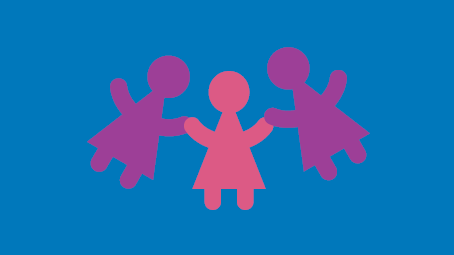
Arts & crafts with friends
Good friends can make a simple box into a palace, boat, or spaceship. You can suggest inviting one or several friends over for some joint arts & crafts time. Perhaps they will discover what else a box can turn into – with a little imagination, a pair of scissors, some markers, but most importantly – lots of togetherness.

Now Birt, then Shu, then Etho
Playacting is a great way of learning about the experience of others while expressing feelings and sensations. You can act this story out with the help of various family members or toys. Take turns playing each role, so that you can experience the story from the different characters’ perspectives.
Tip for Family Reading
Books featuring characters who are imperfect and make mistakes generate empathy, and enable a discussion on subjects that are not easy to directly address. Use this book to spark a discussion and ask questions about the characters’ actions and feelings to encourage your children to express their own inner thoughts and feelings.
Asking for Forgiveness
You may want to ask your children: “What did you think about what Chico said to Pilchas?” “Which situations may lead to a hurtful exchange?”. You can also discuss similar situations they had to deal with, and ask: “Have you ever said something you later regretted?”, “Did you say you were sorry?” “How did you feel afterwards?”
Watch & Learn!
What is the speed of sound that the rabbit was trying to achieve? This Davidson Institute of Science video will teach you all about it using a fun experiment with a sound pipe.

There are many ways to say I’m sorry
You can help Chico ask for Pilchas’ forgiveness in various ways – a letter, drawing, poem, or dance. “Helping” Chico will enable children to develop their own forgiveness-asking skills, and help fix situations even when they seem too hard.

Becoming Marksmen
You can be inspired by this book to have your own marksmanship competition. You can make a bow and arrow using sticks and elastic bands, or take turns shooting balls into a bucket. Don’t forget to decide which of the forest animals you are!

By which to remember where you came from
After reading this book, you can discuss the importance of family. Share memories of intimate and special moments shared with grandparents. You can discuss your family’s roots, cuisine, and culture, as well as any heirlooms and items that are passed in your family.
My Own Special Reminder
Do you also want to have an item to remember things by and help you overcome difficulty and loss? You can use beads to make a necklace or bracelet, paint a pebble, or any other good idea, and then decide what to do with this it to be reminded of something or cheer up: Twist it? Squeeze it? Stroke it? Move it to your other hand?

Homemade Cookies
Which cookies remind you – the parents – of your childhood home? This book can inspire you to bake cookies together, or prepare any other dish that connects you to your roots, family, and home.
Listen to the Story
Listen to Yarden and Didi tell the story of Shoham’s Bangle on the Sifriyat Pijama podcast.

Arts & crafts, songs, and other activities can be found on the Sifriyat Pijama Pinterest page.

Tips for family reading
This is a special book that delicately addresses coping with a friend’s complex physical or emotional state. We recommend that parents read this book before reading it together with their child in order to adjust the reading and discussion to the book’s unique content, and the child’s unique world.

“And I found a way”
David’s friend immediately notices when David’s behavior changes. You can discuss and share: Have you ever noticed when someone you have been close began to act differently? What did you do? What do you think about what Davd’s friend did?

Paper flowers – a kind gesture and a good word
Invite your child to make a colorful floral crown that would bring joy to your family. Suggest that your child cut out paper flowers and decorate them, and then write a kind word about each .family member

A “just in case” box
What comforts and cheers you up during difficult times? A kind word? A touching book? Perhaps a toy? You can make a box filled with “just in case” ideas: Items that cheer you up, encouraging messages, and kind words.

A hug in a letter
Does your child have a friend or family member who is coping with a complex physical or emotional condition? You can suggest that your child write that friend or relative a letter of encouragement. Use supportive words, such as: I’m here for you; you’re strong; we’re your friends; and we love you. You can add a drawing that will put a smile on their face too.

Holes in the Boat
At home, much like the Schlofnoche’s boat, there are problems, or ‘malfunctions’ at times, that require a joint effort to solve. After reading the story, you can discuss and think together: In what situations does our family need to come up with an idea or solution? When is a joint effort needed? When do we realize there is a problem but only discuss it without trying to resolve it? And which ‘bird’ can ‘save’ us in such instances?

Family challenge
At the end of the story, in the absence of an appropriate solution, “Four Schlofnoche huddled on top of one small cabinet”.
You can also have fun finding out: How many family members can huddle together on one small carpet? Or a hammock? Or anywhere else you choose. Try coming up with creative ideas and solutions together to help with this challenge.

Creating creatures with funny names
What sort of funny name is Schlofnoche? Do you have any more ideas for similarlyfunny names? The whimsicalinos? Or sillynillies? You can come up with imaginary and amusing creatures of your own. Imagine them, draw them, color them, and then decide on a long and funny name for them.
Listen to the Schlofnoche’s Story
You can listen to the Schlofnoche’s story by watching this video.

Family reading advice
After reading, you should go back and spend time looking at the illustrations. Notice the small details that are not directly related to the text, and share your discoveries with one another.

Being considerate
At home, we also need to get along in the same “railroad car”. You can discuss and think together with your child: Which home situations require us to be considerate? Why is it important to speak up and discuss things that make us uncomfortable or that we find inconsiderate? How should we go about it?

Animals and attributes
The tortoise is slow, the owl is wise, and the rabbit is fast. You can go back to the book and check – what other animals appear in it? What are their special attributes and characteristics? Do they have the same characteristics in real life too?

Roleplay
You can dramatize this book – sit together on a “train” – parents can be the crocodile, taking up the entire railroad car, and children can be chicks. How will you go about asking the crocodile to make some room for you? Will you end up messing around and having some friendly fun together? Now, you can switch roles.

Family reading advice
Children enjoy looking at illustrations and noticing details that do not necessarily appear in the story itself. While reading, you should join them, look at the book together, and discover how the illustrations add fun and amusement to the written text and shared reading experience.

Enjoying the sunset
The characters in this book are friends who enjoy watching the sunset on the beach together. You can also go to the beach, park or even the street to enjoy the beauty of the sky as the sun disappears. You should also take some paper and crayons along to draw a sunset of your own, or any other beautiful thing that can be admired simply by taking a look around you.

Family reading advice – Recurring phrases
Many books written for toddlers have a recurring phrase that helps their target audience follow the story and join in the reading. The recurring phrase can be emphasized while reading using a special voice, body movement, or a change of reading pace. For example, when you read bo itanu (“come with us”), you can add an inviting hand gesture, or make the end of the phrase longer – veyesh etzlenu m-a-k-o-m (“and we have r-o-o-m”).

Hosting friends
The girl in this book invites the children to join her under her umbrella and “hosts” them. You can ask the children whether they like to host at home, and who they would like to host.
Sometimes toddlers find it hard to share their games when they host others at their homes. You can discuss that and explain that, just as the umbrella in the book is still the girl’s umbrella, even when she allows others to take cover under it, so do their personal belongings remain theirs when sharing.

Listen to the Song
You can listen to the song as sung on Kan Kids’ children’s show Parpar Nechmad, and join in the singing as well as the dance movements.
Lyrics and music: Datia Ben Dor
Performing Artists: Ester Rada, Uri Banai, Meital Raz, Ami Weinberg.

A family with an umbrella
How many family members can fit under a single umbrella? And how many can fit under a blanket? Or the dining-room table? This book can inspire you to find out how well you can all squeeze into various places in amusing and fun ways.

A walk in the rain
On a rainy day, you can pull on some boots, put on a coat, take an umbrella and go out for a walk in the rain! You can step into puddles and observe the special things that change around us when it’s raining – How many people are outside now? What do the skies look like? What happens when the rain falls on soil or the sidewalk? What kind of smell is in the air?

Family reading advice
This is a special book about a special family, in which one brother is visually impaired or blind. The narrating brother is well aware of the challenges in his family and the restrictions required of him at home, yet chooses to see the world in a positive light. We suggest that you, parents, read the book before reading it together to adapt the reading and discussion to this book’s unique contents.
Discussion
Do you think the child in this story is lucky? Why? What makes you lucky? You can share with one another, parents and children, the good things in your shared life as a family. You can create a regular ritual during which, once a week, family members share the positive things that they experienced that past week.
What can you see…?
How do blind children experience life? Scan the code to watch an episode of “I’m sorry for asking” about blind children. Following the video, you can discuss what makes our lives similar to or different from that of the children depicted in the video.

What do we discover when we reread?
Rereading can reveal new and surprising things. We recommend reading the book twice, looking at the illustrations and searching for clues about Hagay’s visual disability: What about the words and illustrations hints at this family’s challenge? Did you notice it the first time you read the book?

Make believe
Hagay knows how to tell made-up stories. You can try it too! How about choosing two items and using them to tell a made-up story: a brush and a rug, a bottle and a stuffed cat, a hat and a window – what can happen to them in the made-up story you will come up with together?

More arts & crafts and activities can be found on the Sifriyat Pijama Pinterest page.

Here we go!
It feels good to successfully do something for the first time – reading, writing, and what else? You could discuss memories of “firsts” – theirs or yours – together with your child: scoring a goal, riding a bike, swimming, or solving a riddle. And what else?

Words in illustrations
This book can be read using the illustrations too. You could look for words in them, and try to read them with your child while identifying letters and discovering interesting details added by the illustrator.

Words words
The world is full of words – perhaps you can choose a definition from the book and make a list of words for it: funny words, dancing words, mischievous words, or blossoming words. Words as long as a giraffe, or short ones. Or you may want to make a list of your favorite words.
Family reading advice
While you read, you can use different voices and invite the children to do the same: What does a person sound like when s/he bursts out crying? What does a hole being drilled into the wall sound like? Even if you’re not professional actors or actresses, your active participation in the story will enhance your shared experience and delight.

Children’s wisdom
The judge learns from the girl how to resolve the case brought before him. Following this book, you can discuss your children’s knowledge and strengths with them: It can be a hobby, insight or shared memory from an incident in which they contributed their experience and wisdom. You, parents, should also share: What have you learned from your child?

What floats in water?
Do oil droplets indeed float in water? You can see for yourselves by adding a few drops of oil into a bowl filled with water. You can later check what else floats: What happens to a piece of paper in water? Or a paper boat? A fork? Or a leaf? And how about a small plastic toy?

Resolving disputes
Just as they do in this book, you too can try to resolve a disagreement on some issue: Each party presents their case, everyone listens, and suggests how to resolve the dispute.
You can also swap roles and explore together – is only one of you right? Or can you, perhaps, reach some other kind of understanding?

More arts & crafts and activities can be found on the Sifriyat Pijama Pinterest page

Family reading advice
Books containing very few words allow us to tell an emotional and experiential story as we follow the main character in the book: What is he feeling? What is he thinking about? When is he sad and when does he get a new idea? You can look at the illustrations, get to know the main character and his experiences, link them to your own lives and, most of all, add something of yours to this experience that is being described in so few words and in heartwarming illustrations.

A gift of something
Did Mooch only give Earl an empty box for a gift? You can discuss gifts that cannot be put into boxes: Which free gifts can you give one another? A hug? A drawing? How about warm loving words?

A box of nothing
You can also have your own box of nothing. Take a box or paper bag, decorate it with paper, drawings, stickers and decorations. Whenever you are bored, open the box and use your imagination to decide what is in it: Maybe it contains an imaginary ball that you can pretend to toss between you, or an imaginary story that you have made up together, or any other invention with which you can come up.

Our books
Have you tried reading a book using a bird’s voice? Perhaps you happen to own a red book? Scan the code and you can play a game that encourages reading using the books you have at home. You can even get a certificate at the end of it!

Doing nothing
What happens when we do nothing? You should take a few minutes to sit quietly and listen. What can you hear? What can you see? What can you feel with your body? You can share your experience with your family and think together: Does nothing really happen when we do nothing?

Family reading advice
Books can help to prepare for a special occasion or collect memories from a recent event. For example, before a holiday, you can choose a book that speaks about it and discuss: Which events did you plan for the holiday? How can both parents and children prepare for it? In preparation for Purim, you can make a costume or mishloach manot together, and after the holiday, you can read the book again to help you remember the beautiful moments you have just experienced together.

The costume game
Walk around the house and pick an item: a spoon, a plant, a ball or… a rug. Take turns describing a costume that includes the chosen item: Is the rug part of a rug seller’s costume? Or is it a flying carpet? Is the ball part of an athlete costume? Or a clown’s nose?

תחפושות ופורים
This book provides an opportunity to share Purim memories: Do you like dressing up, and if so, do you only do so on Purim? Did you, parents, enjoy dressing up while you were growing up? Which costume brings back good memories? You can find out who likes to dress up and who prefers not to, look at photos from the past and be reminded of special Purim moments.

What it means to be different
We are all different in some way. Scan the QR code to meet Uffnik and friends for a discussion on the word “different”.

Illustrated costumes
Where in the book can you find an astronaut’s costume? And what about a Queen Esther, firefighters, police officers or Albert Einstein? You can look for the costumes in the illustrations. Which one is your favorite?
Who was Albert Einstein?
Albert Einstein [1879-1955] was a Jewish German scientist. The relativity theory he developed and other studies he conducted made a big impact on the world of science and on how the laws of nature, time and the universe are perceived. Einstein had a sense of humor and imagination, promoted peace and fraternity, and loved corresponding with children from all over the world. Einstein supported the establishment of the Hebrew University in Jerusalem, and the State of Israel in general.
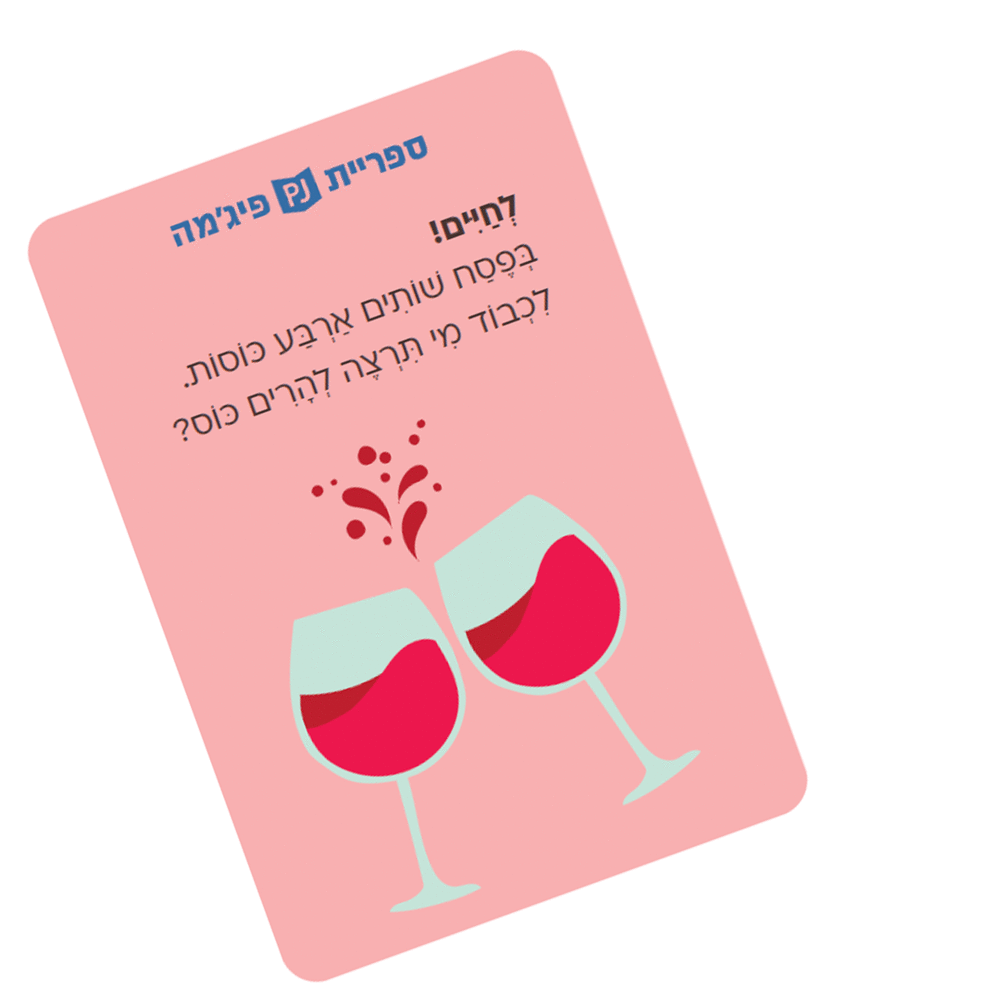
Pesach trivia
What are the three things you would have taken with you when leaving Egypt? And who can leap like a frog from the second plague? Scan the code and you will be able to print out an amusing card game that will enhance your Seder Night experience.
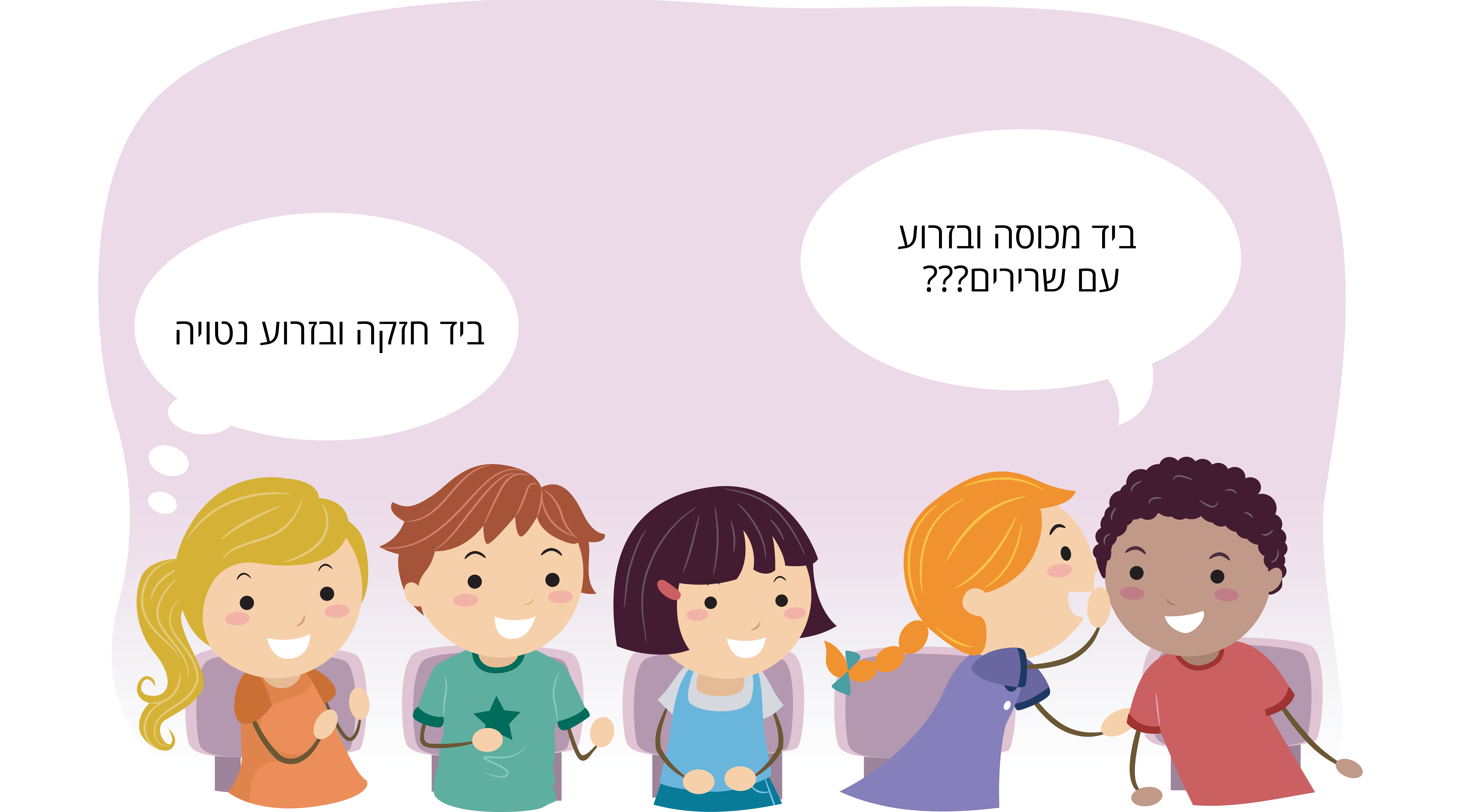
Hide and Seek
You can hide the afikomen or any small item and ask family members to look for it. Is it in the kitchen? Under the couch? Perhaps in the closet? In the next round, the one who found the item will hide an item of his or her choice, while the others go looking for it… Good luck!
Pesach activities
This book offers parents the opportunity to tell their children about their childhood Seder Night experiences: Did you hide the afikomen? And who found it? What did you like about Pesach as children? And what do you like about it now – parents and children?
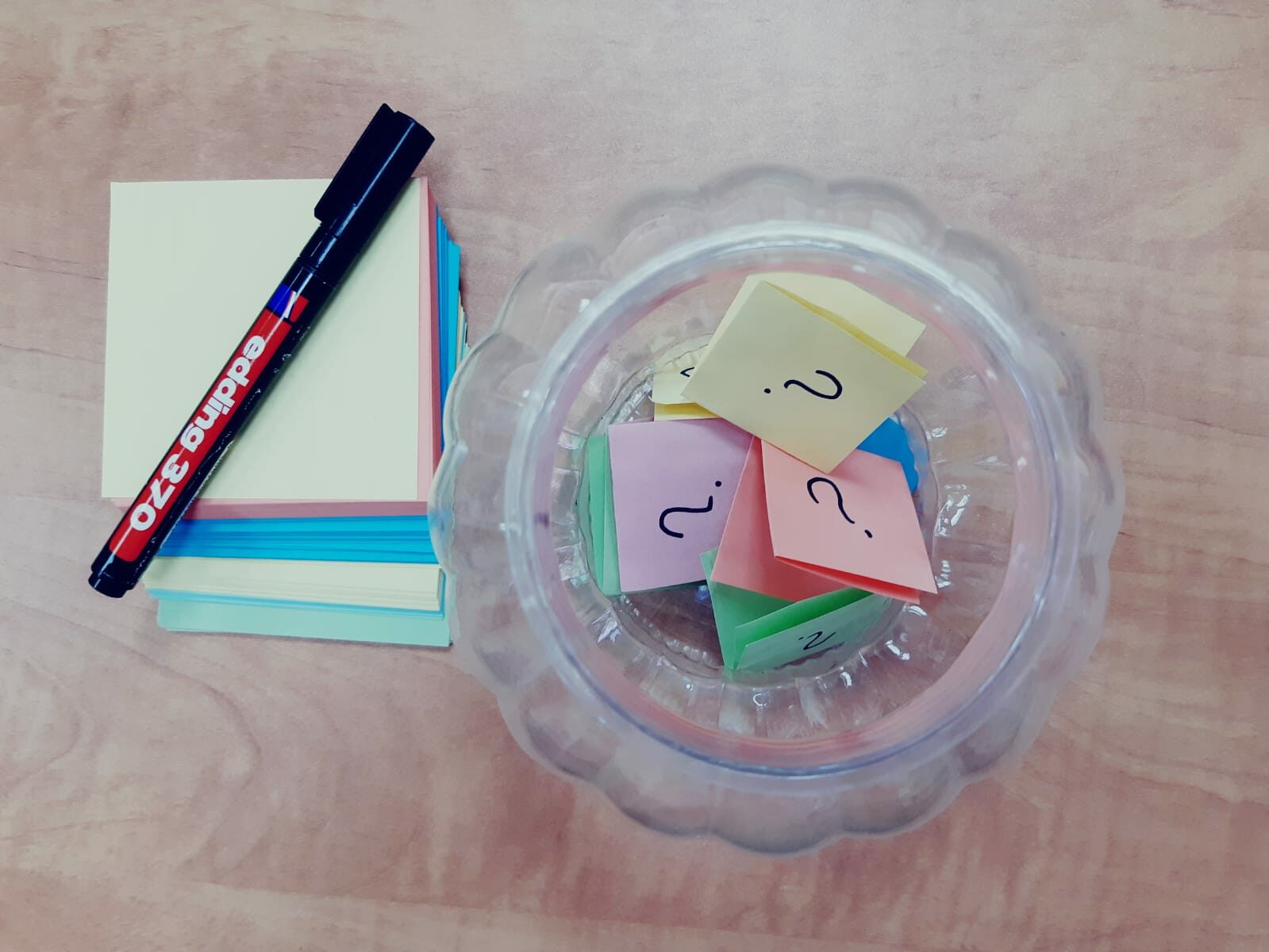
Where is the frog?
A small frog is visiting for Seder Night wearing an ancient Egyptian headdress. Can you look through the illustrations and find it? Why does it appear in the illustrations, in your opinion?
Family reading advice
Books help children recognize feelings, name them, identify and empathize with the characters, and, subsequently, do the same with friends and people in general. While reading, you can look at the characters’ facial expressions and discuss: How do you think they feel? Are they angry? Sad? Perhaps happy and relaxed?
Fighting and making up
Sometimes we fight with friends, and sometimes with our siblings. You can discuss and share an argument you had: What caused it? How did you feel? Who helped you to calm down? Did you make up, and how?
A play with a broom
The child in the story fights with everyone, but how can you fight a broom or a faucet? Try picking an inanimate object and acting out an amusing interaction with it – how about a game for two with a stuffed animal, a conversation with a toy car, or an argument with a coat?
Singing with a broom – QR code
Would you like to sing and dance with a broom and perhaps clean the room while you’re at it? Scan the code and join Oded Burla’s song about a broom.
Moving like…
You can open the book to a random page and move like the things described on it: You can fly like the wind, drip like a faucet, open and close like a door, or soar like an airplane.
Family reading advice – From book to life
Books can help us cope with challenging situations: Toddlers identify with book characters and, as a result, learn about emotions, behaviors and challenges that exist both in books and in real life. In situations that are similar to those presented in the book, you can remind your toddlers of the book characters, and suggest that they be inspired by them and behave in a similar way: “Do you think we can maybe shift a little on the bench, and make room for our friends, just like the bears in the book did?”
מה קורה בסיפור?
You can discuss what is happening in the book with your toddlers – which problem did the bears encounter? Why didn’t the bear have anywhere to sit? What did the other bears do? You can also address the feelings that emerge from the book: How did the bear feel when he had nowhere to sit? Was he happy, sad, or perhaps surprised or confused?
Reading the illustrations
You can learn, play, and have fun using the illustrations. You can look for a different detail in them every time – can you spot the pink bear? Where’s the spotted bear? Where is the big bear and where is the little bear?
You can swap roles, and let your toddlers beckon you to search for details in the illustrations.
Like a bear
You can turn the pages of this book and pause at a different page each time to look at the bears and try to copy their movement, sitting posture, and facial expressions so that yours are exactly like the ones depicted in the illustration.
You can find more activities and special ideas on the Sifriyat Pijama for Toddlers Pinterest page.

Reading-assisting touch
Toddlers need physical contact. That is why you should sit close to one another while reading, hug, touch, and look into each other’s eyes every once in a while. That way your toddlers will experience story time as a warm and relaxing activity that makes them feel loved and safe.

Tickles and games
You can ask your toddlers – do you like tickling games? Which of the games that we play together do you enjoy? What would you have liked us to play? In relation to the mother’s telephone call in this book, you can also ask – how did Gan-Yah feel when her mother went to answer her phone? How do you feel when you have to wait?
There’s a hill in this house
You can play the same game they play in the book: Your toddler or another family member can hide under a blanket and become a hill. You can tickle the hill, feel it and search – where’s the hill’s foot? Where is its head?
*Some children are hypersensitive to touch or tickles, and therefore, it is important to remind players before the game that one can say “stop” at any point, just like they do in the book.

Moving together
There are many body movements in this book. You too can jump, dance, roll or lift your legs up in the air just like the hill does. You can look at the illustrations and copy Gan-Yah’s movements too.

For more ideas for activities, check out our Instagram page and discover more surprises.

Family reading advice
Toddlers enjoy reading books together, and when they focus on the story, they use their learning, concentration and imagination abilities. To “get into” the story and allow them to concentrate, you should disconnect from the world for a few minutes, sit somewhere calm, with no background noises, screens or mobile phones, and fly together on the story’s wings.

פעם אני החתול ופעם אני החתולה
This short book is full of experiences from toddlers’ day-to-day lives: They want to take part, sometimes they experience rejection, they strive to be independent and are busy finding solutions. You can discuss such moments in the story with your toddlers and link them to their world: What did the girl cat want? How did she feel when the boy cat didn’t want her to join him? What did she decide to do? Do you also enjoy going out for a walk? And what do you like doing all by yourself?
Let’s go for a walk!
You can suggest packing a small bag and going for a walk with your toddler, just like the girl cat, in your home or neighborhood. Together, you can think of all the things you need to take with you on your walk – a bottle of water? A hat? How about a toy?

What do the illustrations tell us?
When you look at the illustrations together, you could focus your attention on different things each time – Where is the boy cat? And where is the girl cat? What are they doing? Which items can you identify in the picture?

Family reading advice – Sharing experiences
Many books describe toddlers’ daily challenges: difficulty sharing, difficulty parting, the challenging transition from daytime to nighttime, and many more. When identifying a challenge with which your toddler is struggling, choosing a book on the subject and reading it together can be a good idea. Books invite us to share our feelings and experiences, and can offer empathy, encouragement and coping ideas.
Lea Naor was born in 1935 in Herzliya. She has written books, plays, screenplays and children’s poetry, and has also translated many books into English, such as the Dr. Seuss series. Her books and translations have won her many awards.

What is mine and what is ours?
You can discuss the things that are shared by all family members as opposed to those that belong to each of you separately. For instance: “We each have our own toothbrush – what does your toothbrush look like?”, “We all share this house together, who lives in our house?”

Dramatizing and swapping
You can dramatize this book using stuffed animals and have fun together: Swap the toys between you along with the song, and in the refrain az tekhef nihye shutafim bekhol hadvarim hayafim (“so soon we will share all the beautiful things”), you can hold the toy together, and demonstrate sharing.
Illustrations and animals
A cat, a dove, a turtle, a puppy and a young bird – all in one book! You can look at the illustrations, choose an animal together, imitate the sound it makes and act just like it according to the description found in this book. For example, if you choose the turtle “with its entire house on its back” – you can place a cushion on your back and walk on all fours. And how does the puppy with the spot wag its tail?

With an open heart
Following Yonatan, you can discuss and share: What can be the meaning of the phrase: “to open up your heart”? Is there an image or item that reminds you of loved ones, and make you feel like your heart is opening up and your feelings are welling up?
QR code
Would you like to listen to The Key to My Heart? Scan the code and you can listen to this book together

Where have I been and what have I been up to?
Thanks to the lost keys, Yonatan gets a glimpse into his father’s daily routine. And what did you do today? You can play charades, miming to one another a place you have visited or something you have done. Take turns acting out a place or action, while the rest of your family tries to guess where you have been and what you have been up to.

Details in the illustrations
Yossi Abulafia’s illustrations are full of details. You may want to stop and look: Which animals can you find in the illustrations? Do they appear more than once? What are the people on the street up to? And now, look at the illustrations again: Have you discovered anything that you did not seen the first time?

Connections
You can talk about older people you know or knew in the past: Who are they? What is your connection to them? What do you like doing with them now? What memories do you, the parents, have of older figures from your childhood?
Story time
Want to listen to the story? Scan the QR code and you can listen to the story together while turning the pages, at home, in the car or whenever you have time.

Hello Your Majesty
Amira suggests playing a game she played as a child – so can you! How do you play? One participant is the king and the rest are his children coming for a visit. They greet him with “Hello, Your Majesty”. The king replies: “Hello my dear children? Where have you been and what have you been doing?”
The children must explain where they were and what they did in mime, and the king must guess correctly. Then they switch roles.

Party time
Alma is planning a magic party with a magic hat and a magic potion, and invites witches and wizards to join. You can plan a magic party as well, with your own magical ideas. And maybe it will be a “resting” party? Or a game party? Or another themed party of your choice?
A discussion: What if I were… Mom
Which roles does each member of your household have? Who would you want to take over from? This book could inspire you to imagine switching roles within your home: What would your child do if they were to take over from Grandpa? What would Grandpa do if he took over from Mom? And how would you be able to help one another?
Listening to the story
What do you play in a parade? And what do musical instruments in a band sound like? You can find out all the answers to these questions and more if you listen to this book by scanning the code.
A game of “my occupation”
Am I a physician or a clown? Can you guess my occupation? Take turns choosing a profession and acting it out for the other players to guess. If a player’s profession is a little hard to guess, you could give them a clue.
Going into the illustrations
Which character in this book would you like to take over from? You may enjoy looking through it, choosing a character you would like to replace, and share your thoughts with one another: Would you want to take over from the baker? Or play in the parade?
Real or imaginary?
Telling and listening to stories is great fun. The shared experience makes everyone feel good. Discuss and think together – when is the right time for story-telling and letting your imagination run wild. When is it best to tell the story like it is — without adding or leaving out any details? Who would you feel comfortable confiding in when you face dilemmas?
What happened to me yesterday
Who can remember what happened yesterday? Can you tell it like a story? You can use this opportunity to share experiences. You can also play: One of the participants will tell a story, while the others try to figure out what is true and which parts are made up.

Here is where we listen
Whenever Shahar wants to share or consult, she sits on the bench with Herzl, the security guard, and he always listens. Choose a spot at home where you can always speak and be heard. Whenever you need to share, sit there, tell your story, and seek advice.
Let me tell you a story
Do you want to listen to Shahar’s stories too? Scan the QR code and listen away.
A tip for family reading
You can find something to like in every book: The drama, the characters, or maybe the illustrations or interesting words. After reading the book, try asking the children what they liked about the story, and share what you, the parents, enjoyed. You can even tell each other which books you especially like and why.

Friends and us
Peetz and Morchella are spending time together. She’s growing vegetables and he’s nurturing them. In the meantime, they are chatting, singing, and simply enjoying their time together. You can ask the children what they like doing with friends. What do they do together? As parents, this is a good opportunity to reminisce with your children and share your experiences and memories with childhood friends.

Vegetables and drawings
Cabbage? Kohlrabi? – Thirteen types of edible vegetables appear in the book. Can you find them all? You may want to eat your favorite vegetables or try new vegetables.
Nice to meet you: the morchella
So, who are you, Morchella? If you scan the code, you’ll learn about the morchellas that sprout up in Israel each winter. Do you want to learn more? Go to the library together or surf the internet and look for information on morchellas and other mushrooms.
Growing vegetables
You can grow vegetables, even if you don’t have a plot of land. Try taking a cut carrot top, cloves of garlic, or the bottoms of lettuce or celery, and soak them in a transparent container with water. Wait patiently, add more water if needed, and little by little, you will see leaves and roots sprout. You can cut them off and eat them, or plant them in a flowerpot, and wait for new vegetables to grow. Don’t forget to water them!

Family reading advice
Children identify with the characters in the book, and acquire a better understanding of others who are different from them, thereby developing empathy and adaptability to new situations. While reading, you can focus on the characters’ facial expressions and ask: How do you think they feel? And why?

Discussion
You can discuss and ask: With whom and what do you like to play? In your opinion, what should we do when we each want to play a different game? What solutions can we suggest?
Annoying but also fun
Libby wants to join Pupik on his visit to the fire station, but he is annoyed – can a solution be found? Watch the video to find out!

Moving with the illustrations
Sitting, jumping, or perhaps bending down? Take turns choosing a page in the book, and showing the others a movement or posture similar to that of the characters depicted in the book. The other players can then imitate the movement, and look for it in the right page in the book. Did you find it? Then it is now time for the next player to choose a page.

The game of games
On separate notes, write down the games you like to play together: Hide-and-seek or maybe catch? Put all the notes in a box and choose one at random each day. What does it say? Would you like to play this game together? If not, you can always take another note out of the box or add a new note suggesting a new game.

Family reading advice
Illustrations allow young readers to be exposed to art, and get to know new worlds that enhance the written story. At times illustrations tell another or different story than the one told in words. While reading this book, we recommend looking at the illustrations together, take a break in the reading, take another look at the illustrations, and allow the children to find special details that speak to them.

Caring and trying
Bear is trying to help his plant. He wants to take care of it. You can discuss and share – who is it that you care about? And who do you take care of? A pet? A toy? A beloved plant or perhaps a younger sibling? – How do you care for them? Have you ever tried to care for someone or something that didn’t work as planned, but things worked out in a way that you did not expect?

What illustrations tell us
What is happening to the bunnies? The amusing illustrations in this book describe an entire underground world. Together, you can look at the illustrations and tell one another what the bunnies are doing. When are they happy, sad, full or busy?

What can we see from here? And from there?
What can we see when we are sitting on the couch? And when we are standing in the center of the room? Or crawling under the table? Take turns as each family member picks a location from which to look at the room: What has caught their attention? Do they see details that others don’t see?

QR code – What can we do with a carrot?
Would you like to prepare a carrot for planting and eating? Scan the QR code to discover what can become of a small piece of carrot.
Playing Hide and Seek
Let’s play hide and seek! We can hide our fingers in the palm of our hands, cover our nose and reveal it, hole up under a blanket, conceal ourselves behind the couch, or hide a toy behind our backs.
Who wants to go first?
Seek Out the Cat
Meow! The grey kitten has joined our game of hide and seek. You can search for it every illustration, just be careful not to step on its tail…
Some Reading Advice: How to Turn Books into Friends?
Reading from an early age plays a key role in toddler development; however, like anything new, the question is – how do we find the way? We suggest getting acquainted slowly and gradually; let the toddler connect to the book in their own way: Touching, opening and closing, and even “tasting” it with their mouths. Afterwards, you can read: A little each day, patiently and with pleasure. At first you could even read a single page, introducing it and getting accustomed to it, and hey presto – you have turned a book into a friend!
Sifriyat Pijama an opportunity to read together, at any age
A bit of advice when reading as a family
Toddlers like to be part of the story: Repeating words and sounds found in the book, or dramatizing the actions taken by the different characters. It is their way of identifying with the story, enriching their emotional worlds, and acquiring vocabulary and concepts. That is why, when reading together, you could “play” the trumpet, “beat” on a drum using your hands, and pretend you’re a choir conductor.
Playing music together
Almost any item can become a musical instrument: You could clap together to the rhythm of the song, or collect any instruments, rattles, and utensils you can find. A pot with spoons can be a drum, a used roll of paper towels can be a trumpet. You could even try to tap various materials to find out what kinds sounds tapping wood makes? And what about tapping the floor? Or metal? You may enjoy picking one of your favorite songs and playing it together.
A discussion on being together and apart
Gali and Gaya love doing stuff together, but also separately. You may want to discuss and discover what your toddlers like to do together with a sibling, friend or you, their parents, and what they prefer doing on their own.
Gali and Gaya come visit
Would you like to play with Gali and Gaya, and dramatize the story? Please scan the QR code, print out two adorable ducks, cut them out, and act the story out with them…!
Follow me! A motion game
Like Gali and Gaya, you too could walk together. How about making a trail at home, and marking it with a piece of rope or various items. Next, walk along it in single file, one behind the other, or perhaps together, side by side. You can also take turns being in the lead and exclaiming: “Follow me!”
Animals & illustrations
A sheep, frog or butterfly? You may enjoy looking at the illustrations in this book together, and discovering the various animals. You could make the sound that each oft them makes, or move like them: Flying like a butterfly, buzzing like a bee, or… What else?
A piece of advice when reading to toddlers
We recommend reading the book alone first, before reading it as a family. Prior familiarity with the book helps to read it seamlessly later, at a pace suitable for toddlers. Enjoy reading this book!
A discussion on who can help
We can all help others, even toddlers. You may want to ask your toddlers how they can help others, or tell them that they are helping when it happens: “Remember when you helped me set the table?” “Look at you helping me put away the toys!”
Listening to the story
Would you like to listen to the book Noni and his Mom Walk Homefrom Kindergarten? Please scan the QR code to find a recording of this book. You could listen to it while traveling, playing, or sitting together while turning the pages of the book.
A story in illustrations
The illustrations are part of the story, and using them, toddlers identify and recognize the plot and some of its details. You may enjoy looking at the illustrations together, and searching for the items that Nomi gives his mother: ‘Where do you see an illustration of a bag?’ and ‘Where can you find an illustration of a coat?’
Playing a game of ‘An items tower’
Inspired by the items piling on top of mom in this book, you may want to take turns building a tower out of various items: Very carefully, one on top of the other, you can place building blocks, toys, hats, bags, and anything else you might want to add.
A discussion on things that are wonderful and free
What gives you pleasure for free? – You may want to take a look at the illustration in which the wise man presents all the good things in our world that are given to us for free, and share your opinion of them with one another – Do you also enjoy them? And which other things that are given for free do you like?
Listening to a story
The story of the baker, peddler, and wise man is yours to listen to by scanning the code.
Illustrations – A girl and boy
A girl and boy appear in many of the illustrations in this book. You may enjoy looking for them as you leaf through it, and thinking of reasons why the illustrator chose to add them to the illustrations together.
Challah and a pleasant smell
Would you like to make challah? A recipe is waiting for you on the final pages of this book. Bon Appetit and enjoy the wonderful aroma that will fill your home.
Reading poems
The poems in this book present small moments in life. Every time you read together, we recommend selecting one poem, and reading it together. Does the poem remind you of something that once happened? This may be a good opportunity for you, parents, to share a childhood experience with your child, creating closeness and intimacy with them.
Pleased to meet you – Hagit Benziman
When did Hagit Benziman start writing? What does she write about, and why? You may want to scan this QR code to find out more about this author and her work.
Looking through the family album
You may enjoy looking at parents’ family photo albums together, searching for special childhood moments. You could also look at early childhood photographs of the children, and share information about the moments captured. Which memories do they evoke in you?
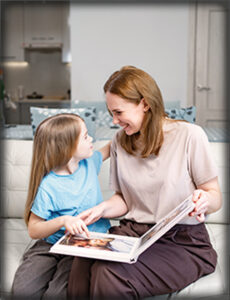
Dramatizing together
Do you have a favorite poem among those included in this book? If so, how about acting it out together, with the grownups playing the parts of the children, and vice versa.
A discussion on our house
All houses consist of walls, a roof, doors and windows: What’s special about your house? What makes it your home? You may want to discuss special objects and items found in your home, or the things you do there together.
A video – House of boxes
What can you do in a house made of boxes? Scan to QR code to get ideas for a house that’s both real and imaginary.
Arts & crafts – Home building
How about making a house out of blankets, cardboard boxes, sticks and clothespins? And what else would you need? Decide on a location and workplan, gather the necessary items and accessories, and off you go!
A game of house catch
Take turns announcing a topic and having all the other players try to work together to find a suitable item. For instance, when “red” is announced, all players must search the house for a red item. In the next round, another player might call out “big”, “small”, “cute”, “old”, “multicolored”, “annoying” or “wheel”, sending the other players to look for an item matching their announced topic.
פינטרסט
Pinterest
Arts & crafts, songs and other activities are available on the Sifriyat Pijama Pinterest
Family reading advice
Reading a book together can evoke thoughts, feelings and emotions in children: Like the young bird, they can feel small and fragile; like Efrat, they can feel misunderstood, or determined to go on doing what they believe is right. We recommend sitting close together, and accompanying the reading with a soothing stroke: Touch brings parents and children closer together, and strengthens children’s faith that they have someone who supports them, and is attentive to the feelings that the book evokes in them.

Getting bigger
Little Peanut is getting bigger, and Efrat, who is discovering independence and responsibility, is getting bigger too. You can discuss and ask your children what makes them bigger and more responsible than they were before – are they taking care of a pet, for example? Doing things on their own? Helping their friends and around the house? We recommend always reminding children about the areas in which you, as parents, see that they have made progress and grown. Doing so makes children feel good, and bolsters their self-confidence.

Helping animals
You can also help the animals in your surroundings: You can make a feeding station for birds containing crumbs; place a water bowl for cats; make a sign protecting an anthill, or think of your own ways of helping the animals in your surroundings.

Where are the animals?
The illustrations in this book depict various animals – some are stuffed, drawn or playthings, some are real, while others appear in the children’s thoughts. Can you find them?

Jumping, skipping, flying
Do you like to move? Look at the page on which Little Peanut learns how to fly, and try to move along with the story: You can grow wings, hop, skip, or even try to pretend to fly.
A discussion on fear and encouragement
As our children grow up, they experience various fears, but discussing them helps them to cope with them, while instilling in them a sense of security. Together you can choose to discuss what they find scary, and what helps them overcome their fears.
Listening to a story
Would you like to hear Maayan and listen to everyone cheering her on? Scan the code and listen to the story together.
הַסִּפּוּר לְהַאֲזָנָה – עַכְשָׁו בָּפּוֹדְקַאסְט שֶׁל סִפְרִיַּת פִּיגָ’מָה!
בגן At the playground
After reading this book, you may enjoy going to the playground together, and trying out the equipment together as well as separately. Perhaps you would like to invent a special course from the slide to the swing and so on that would bring joy to all of you.
Family encouragement
“Hooray, Maayan!” Everyone calls out when Maayan is scared. How do you cheer one another on? Perhaps you could come up with family words of encouragement, find a motivating song, or a chant you all agree on that cheers you up and gives you strength.
A discussion on what has been lost
Have you ever lost anything you found important? How did you feel and what did you do? Perhaps you’ve found someone else’s lost item… This book invites children as well as parents to share their childhood experiences of losing and finding lost items.
A video about a lost and found stand
A video about a lost and found stand
Shabi and Uzza from the Israeli children’s television show Parpar Nechmad are also returning lost items to their owners. Scan the code to watch the video.
A game of “Find me!”
The main characters in this book are a hedgehog, rabbit and mouse. But other animals also appear in the illustrations –
Can you find them?
How many animals have you found?
“Did you find me in the illustrations?”
A discussion on searching and finding
Following this book, you may want to embark on searches together with your parents, grandparents, or other relatives: What have you found? Were you surprised? Do you enjoy searching and finding?
A game of Search Cootie Catcher
A game for both seekers and finders.
Scan the QR code
Print out, cut out and fold according to the instructions.
Have you searched? Have you found? Would you like to play again?
Illustrations
This book contains both colorful and black and white illustrations. Can you figure out when the illustrations are in black and white, and when they are multicolored?
A game of “what’s missing?”
A game of “what’s missing?”
Place several items in a row and look closely.
Take turns hiding one of the items while the rest of your family members have their eyes closed. Once it has been removed and hidden, the other players can open their eyes and start searching – Which item is now missing? Where was it hidden?
Pleased to meet you, I’m Hyla!
I’m similar to a frog but smaller. I can be found in Israel, mostly on trees, eating insects and laying eggs in the water. I’m a protected species and therefore cannot be kept in a jar, only in nature.
Reading Together
You can encourage the toddlers to actively join in reading the story. They can complete rhyming words, accompany the conversation between the animals with facial expressions and proper hand gestures, and make the sounds of the animals appearing in the story.
Towards welcoming Shabbat
You can ask the toddlers: What do you like to do on Shabbat? If the family has special preparations for Shabbat, it is worthwhile to tell and share them with the toddler
Where Are The Animals?
The book features a bee, a turtle, an ant, a chicken, a cow and a rabbit. Ask the toddlers to identify the various animals in the illustrations in the book and accompany each animal with its unique voice or add other characteristic detail: the bee hums, the rabbit bounces, the turtle crawls slowly, and the cow is mooing.
And Now - A Turtle!
How to make a turtle with the palm of your hand? Close the palm to a fist and hide the thumb inside. Call the turtle out, take out the thumb and wave it hello. You can create a bunch of turtles with all the palms present at home You can also be a turtle yourself and walk slowly on all fours. Are you tired? Get inside to rest in your “home”.
Pinterest – Crafts, songs and other activities on the “Elik Belik” book page in Sifriyat Pijama on Pinterest
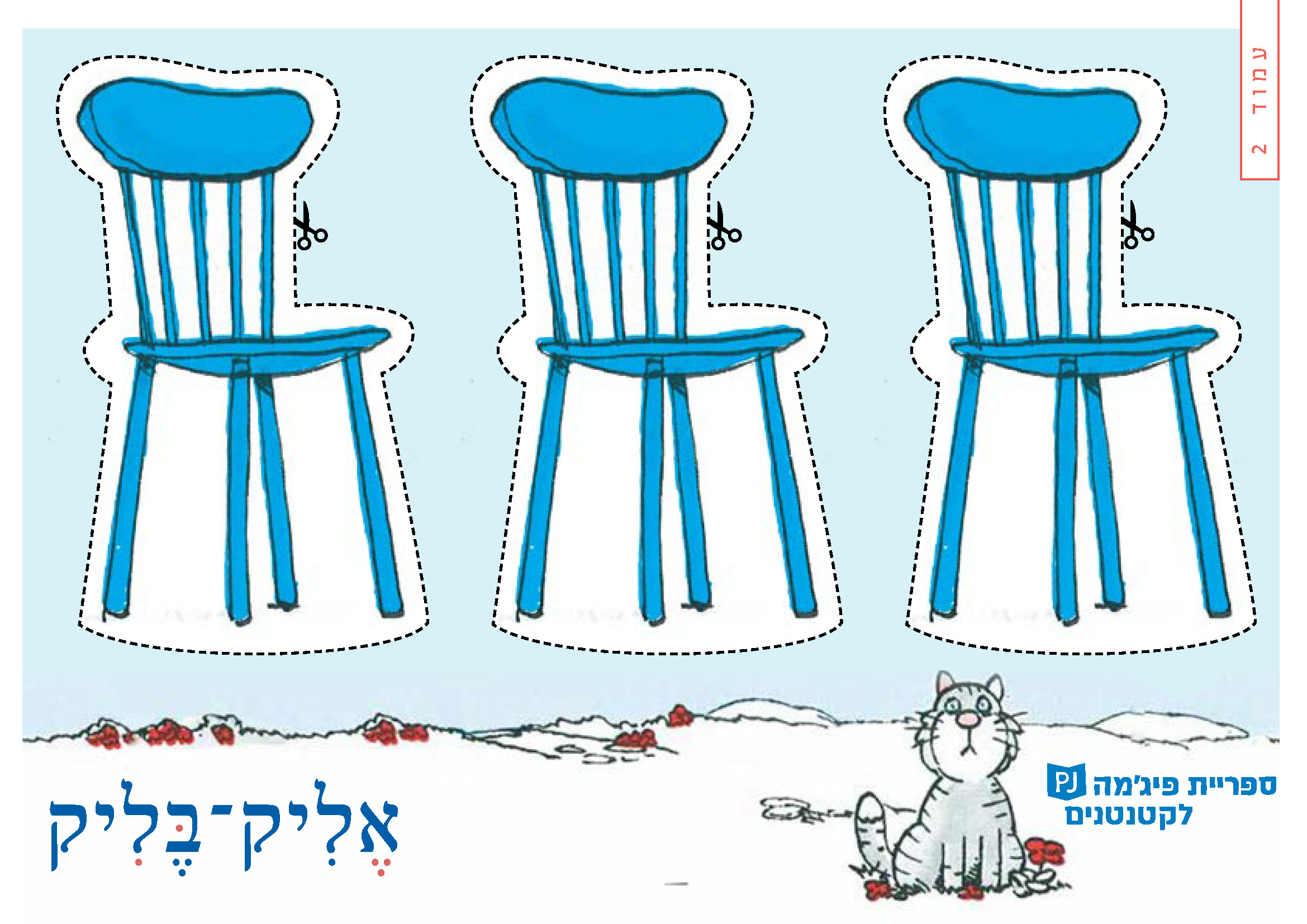
Reading Together
Do you also have little friends visiting your home? Are they imaginary friends, or maybe a beloved doll? It is worthwhile to talk about it with the toddlers and hear what do they like doing with the little friend. You can “bring in” the little friend to join and read the story.

How to Read the Story?
The story is slightly longer than usual, and in order to arouse interest and curiosity it is recommended telling it in a variety of voices: a voice for Dad, a voice for Yaeli and a different voice for Mom and for Elik Belik. You can look together at the illustrations and invite the toddlers to participate in the identification of details and repeat the words “Elik Belik”.

Hide and Seek
Where’s the doll? On the table? maybe underneath it? And where’s the ball? You can hide various objects, look for them and then say: “The ball is on the chair”, “The ball is under the bed”. You can also hide yourselves and look for each other.

From Small to Big
Dad has big shoes, Mom’s shoes – they are less big, Yaeli has little shoes, and Elik Belik’s? Tiny shoes! Go on a journey throughout the house, collect items of the same type and arrange them from the smallest to the biggest.
We can help too!
What can toddlers do at home? Many things! They can put glasses on the dining table, sweep with a small broom, feed the pets, and… offer cookies. It is worthwhile to talk and show what the toddler is helping with at home, and what else they want and can participate in.
Who is in the family?
The child in the story hands out cookies to other family members: grandmother, uncle, sister, cousin. Who are your family members? You can talk about family members, say their names and thier roles, such as: “Grandma Braha,” “Uncle Baruch,” use family photo, and use family photos.
Let’s make some refreshments together!
You too can prepare refreshments together, such as chocolate balls, a plate of fruit, or a sliced cucumber. You can prepare “pretend” refreshments using play dough and offer to the dolls at home.
Game: Grandma had cookies…
Do you know the game “Grandma made porridge”? “The child had cookies” can be played in a similar way, in which the toddler opens her, or his hand, and the parent begins to count: “The little boy/girl had cookies and gave one to Grandma (holding the thumb), and one to Uncle (holding the forefinger) etc. And so you count the fingers by allocating a family member to each one. Who will you give the last cookie to?
Reading and hugging
While reading a story, you can hug each time a new animal joins the group. You can also play the hugging game: move away from each other, count “three, four,” and then run to each other, and hug!
It’s crowded but that doesn’t matter!
Invite the rest of the family to sit together with you on the couch, on the carpet or on a mattress. You can also include dolls or pets. Sit close together, then further away, and check: how pleasant is the closeness?
What sound do I make?
How does a dog bark? How does a cat meow? and how does a cow moo? – Toddlers can join can join in to the animals in the story.
Would you like to bring another animal in? And what sound would that animal make?
Sing about cabbage
“I sat on a cabbage” is a song that you can sing, add movements to, dance to and clap your hands to.
The song will upload when you scan the code:
QR – I Sat On a Cabbage – Scan the code and sing together!
Discussion
Parents may want to share the stories they liked while growing up: Was there a particular story you enjoyed hearing over and over again? Who was your favorite protagonist? You could ask your child which stories they like. Are they fictional or true stories?
Dual role illustrations
When do the illustrations tell the story of Leo and Mr. Zinger, and when do they complement the story the two of them made up? You may enjoy taking a look at the illustrations together, noticing the various styles, and thinking of ways of discerning what the illustrations refer to, and what they are telling us.
The story in the hat
Which stories are hidden in the hats you own? how about choosing one of your favorite hats and telling the story that is hiding in it: one player looks into the hat and starts inventing a story. After one or two sentences, they pause, and the next player picks up the story, and so on, until all players have added their part to it. Bashevis Singer could serve as a source of inspiration for telling a family story that has been passed down in your family.
A game – Who am I?
Would you like to play a game? Perhaps you would enjoy writing the names of your favorite characters from books on pieces of paper, and taking turns wearing a hat bearing the name of the character. Whoever wears the hat does not see the name written on the piece of paper attached to it, and must guess who it is using questions, such as: Is it a fictional character? Is it an animal?
Words of emotion
The letters in the story describe feelings: missing someone, loving someone, feeling happy…
How about making some cards with words of emotion, as well as phrases that describe these emotions, and connecting each word with the sentence describing it?
Missing someone: I wish we could see each other again
Loving someone: It feels good when we’re together
Feeling happy: This tune makes me want to jump up and dance
Feeling thankful: I’m so glad we met! Thank you for coming round!
Having a party
Would you like to party like Rosalinda and Aaron? You could use the invitation they made to write an invitation of your own, prepare one of the dishes they had at their party, play some party music, and dance together.
You could even take some photos during your party, and save them in an envelope inside the book you’ve received.
Discussion
Which perfect gift would you like to get for your birthday? How would you feel if you did not get it? Have you ever wanted something very badly but did not receive it? This book prompts us to discuss our expectations – why this specific gift? Do we really need it or are we simply jealous because we saw someone else has it? You may also want to discuss disappointments, and the things that help us cope with them.
Perfect gifts
How well do you know members of your own family, and what do you think would be the perfect gift for them – would it be something you buy or an experiential gift, such as time spent together, or perhaps a trip somewhere? How about playing a game and finding out? In each round, all participants try to guess what one participant would really like to get as a gift. Those whose guesses are the closest win… the perfect family hug.
A human car game
Whoever said only cars drive round and round with a cord attached? People could too! Two of you could hold the two ends of a long cord, leading one another left, right, backwards and forwards. If you get tired, make a pit stop, and start again.
Time together
“A car with Dad is the perfect gift”. And what would you consider to be the perfect gift? What would you like to do with your father or other family members? You could fix broken items, build or assemble something, or perhaps draw, bake, plant, or dance together. In fact, you can do whatever you want, as long as you get to spend time together.
Discussion
Unpleasant things happen to all of us – but do they only ever happen to us? You may want to discuss the feelings that emerge when something unpleasant happens, and help each other think of people who can help, as well as how to cheer each other and ourselves up.
Illustrations tell a story
The illustrations in this book tell us what happened to Winston’s friends without using words. Only Winston doesn’t notice. Pick one illustration, look closely at Winston’s friend, and tell their story as if you were them: What are they feeling? What are they thinking? What about this particular illustration caught your attention?
Lucky it happened to me!
You may want to try looking on the bright side! At the end of each day, share something good that’s happened to you with your family – make sure that both parents and children share news about their day.
Who amuses me? And who surprises me?
Look at the illustrations together and search for details that amuse you – what did each of you find amusing? Did any of the details surprise you?
Discussion
Perhaps you could discuss and share with one another the experiences you recall of moments in which you had discovered a new ability: Writing your first name, a special drawing you had made, and what else? What other new abilities would you like to discover?
Illustrations tell their own story
The illustrations in The Gift invite readers to immerse themselves in the book, and be part of Leo’s world: Which animal accompanies Leo? Which animals appear in the illustrations? Which details are taken from the world of children, and which from that of animals? Would you like to make your own drawing following Leo’s?
What's penned up in your pen?
Which incredible things await you in your pen? You may enjoy dedicating a notebook to drawings, copying words out, or writing down your favorite ones. You could make it a family notebook, in which each member adds their own illustrations and words.
A joint painting
What sort of world is hiding in your pen? Grab a pen and paper to find out! You and your family can take turns adding detail to a shared drawing – a line, circle, character, or item – to create a joint work of art that has come out of a single pen!
Illustrations tell a story
The illustrations in this book demonstrate how Itamar and the rabbit imagined one another versus what they really look like. You may want to check and compare: Do the monsters resemble the real child and rabbit? Are there any similarities between the monsters both Itamar and the rabbit had imagined?
Discussion
Were you, parents, also afraid when you were younger? Perhaps you could tell your children what you were afraid of, and how you grappled with your fear. You could also listen to your children as they tell you what scares them, and together, think of ways to overcome the fear.
Pleased to meet you: Monster
What does a scary monster look like? How about drawing one together, and then trying to imagine: What is the monster’s name? Who are its friends? What does it enjoy doing, and what is it afraid of? Now that you’ve gotten to know the monster, it may be worth asking yourselves whether it is still as scary as it was before.
A family magic word
“Jimalaya Jim! Zuzu buzu Yam Pam Puzu!” Each of the characters in this book has a magic word it uses when something scary happens. What is your magic word? You’re welcome to chose a family magic word together, and think of times when it would be appropriate to use it.
Discussion
Have you ever wanted to do something and had someone interrupt you? how did it make you feel? What did you do and say? This book offers the opportunity to discuss these kinds of situations, as well as some good-spirited solutions.
A home response die
Someone snatched something from me, took something I wanted, interrupted me, bothered me – what do I do? You could think of positive responses together, like using the word “please”, or explaining what bothered you. How about making a paper die and writing all kinds of positive responses on each side, perhaps adding an illustration that depicts the written text? That way, whenever you come up against a problem, you could always throw the die and see what it suggests that you do in response.
A game – Which animal?
Various animals appear in this book: Which one meows? Which one lays eggs? And which one lives in the shed? Let’s find out! One of the players picks an animal, and the rest of the family has to guess which animal they picked by posing questions, and getting hints, such as “the animal I picked meows”, “the animal I picked lives in a pen”. Keep adding more clues until your family has guessed which animal was chosen.
Ladies and Gentlemen – The show!
You could act the story out using clothes, hats, accessories, or stuffed animals. You could make the sounds made by the animals, show how each one responds upon encountering the elephant, or be the elephant sleeping on the path.
Discussion
Who are your friends? What do you like doing together? You can have a conversation about this and look into these questions: Do you like sitting together with other people quietly, like the penguin? Perhaps you like running, like the tortoise? How about thinking together about how you can bring some joy to friends who need you.
What story do the pictures tell?
Through the unique drawings in the book, you can read the story together even on the pages that have no words. Look, together, at the pages with the drawings, and tell each other what those drawings are expressing. Is there an illustration that you liked in particular?
Hello, Red Balloon
Which drawings does the red balloon appear in? When does it disappear? You can look for it in the book, and play some games with balloons, too, like hitting a balloon between your hands, tossing it into the air and trying to prevent it from touching the floor, or inflating it , releasing the air, and seeing where it ends up.
Visiting the sick
Amos McGee takes care of his friends, and they take care of him when he’s sick. Think along with your children about how you can make a sick friend or relative happy (through a phone call, a hand-drawn card, a small gift, and more).
Pinterest – Arts and crafts suggestions on the book’s page in PJLibrary’s Pinterest account

Discussion
The family in this book is rushing to make the train and celebrate Grandpa Dov’s birthday, and yet its members remember to be considerate toward others, and care for animals and the environment. Perhaps you would like to try and discuss what being considerate means – how would you like others to be considerate of you? Who could you offer to help in your immediate surroundings or family? Which actions can you take to make the older members of your family happy?

Playing "fast or slow?"
You may enjoy playing a game called “fast or slow”: take turns to choose a certain action and tell the other players to perform it quickly or slowly. For instance, clap your hands… quickly, and now… slowly; sing a song extra slowly, and then super-fast! After you’ve played, you may want to discuss and discover what you enjoyed doing quickly, and what was more fun to do slowly.

Hidden illustrations
The illustrations in this book are extremely detailed. How about choosing your favorite page, and looking for the tiny details in it? Perhaps you could take turns to ask each other whether you can spot a particular detail in the drawing: Where’s Grandpa Dov’s gift? Where’s the football? Who can find the teddy bear?

Types of…
This book specifies types of plants, toys, cats, and musical instruments. Perhaps it can inspire you to take turns choosing a subject, and having the other players list as many items associated with it as they can. You could choose topics such as clothing, friends’ names, types of toys or musical instruments.
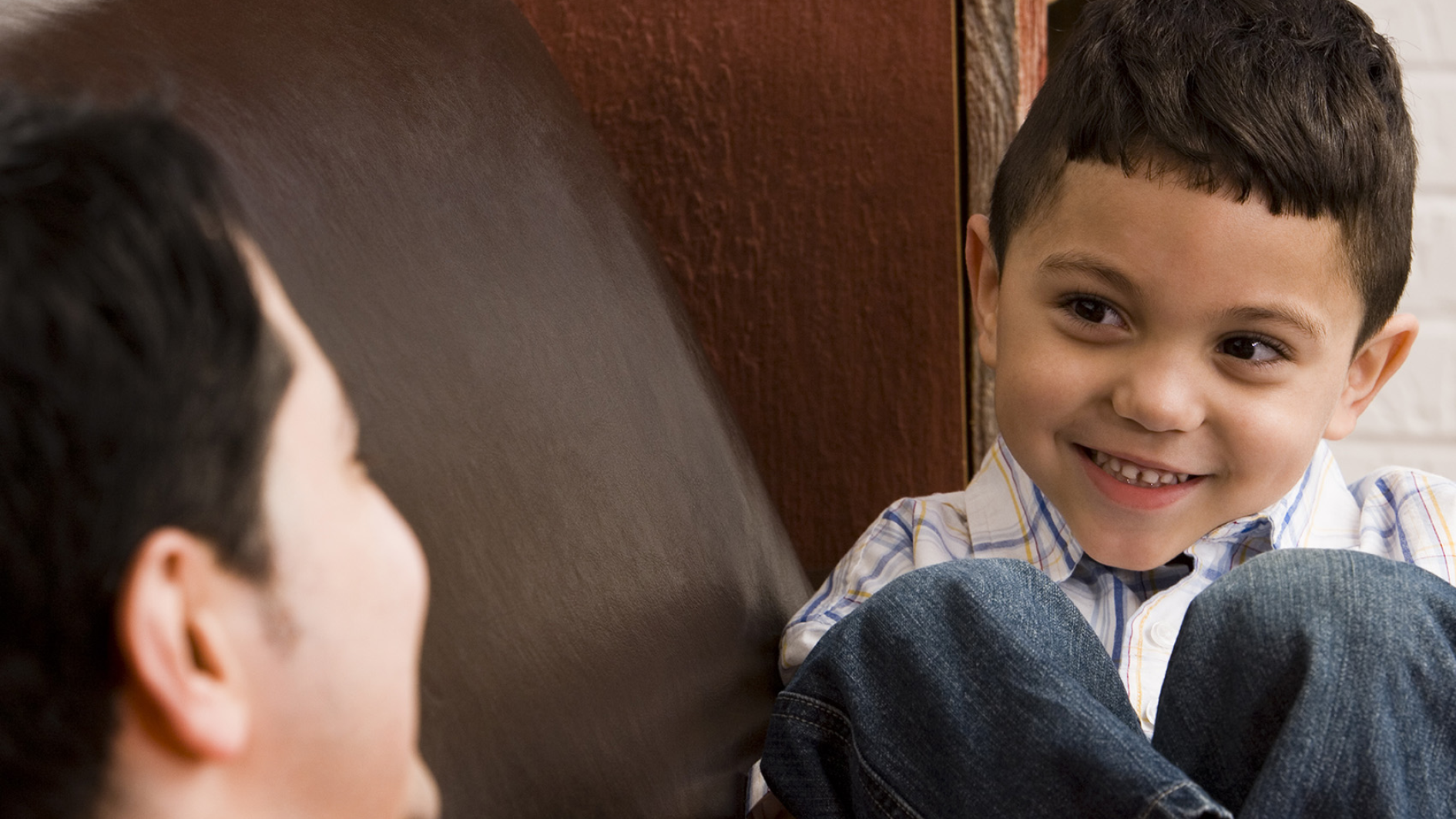
Discussion – With someone and on my own
What can we do on our own? What’s better done together? You may want to discuss the things we can do with others with your child, and then come up with the things that they can do themselves. Who do they enjoy sharing experiences with? Family members? Friends? Perhaps their pet?

A game – On one foot
Can you also stand on one foot? Let’s check!
Throw a die, stand on one foot and count to the number shown on the die: One, two, and… Are you about to fall? Reach out and allow whoever is next to you to help you stay upright.

Cooperation
You may enjoy putting a list together of all the activities that are best done together, in collaboration with someone: Tidying up your room, making dinner, or reading your favorite book. Then, take some cards, write each activity down on a separate one, and decorate it. You could keep all the cards in a special box, pick one out every day, and ask: How about cooperating today and sweeping the house? Why don’t we engage in a family game of catch? Or how about joining forces in some other activity?
Movement – On one foot or two
You may want to assemble a movement course at home, and complete it on one foot, two feet, all fours, or perhaps even three… Design a track on the floor using skipping rope, and take turns completing it in a different way each time: Hopping on one leg, while keeping a cushion balanced on top of your head, crawling, in pairs, with your arms crossed, because it’s easier to jump on one foot in pairs.

Pinterest – Movement games, collaborations, arts & crafts and songs are on the On One Foot page on the PJLibrary Pinterest.ּ
Discussion
This story prompts a discussion about neighbors and relationships: You may enjoy asking one another which neighbors you know, and come up with an activity that would help you get to know a family that lives nearby better. You, parents, are welcome to share stories about the neighbors living near your childhood home: Who were they, and what did you do together?
Pleased to meet you – Getting to know your neighbors
You could, perhaps, prepare something together to give to your neighbors: It could be something to eat, a drawing, or a letter that you could leave by the door. You could even just visit them and ask them how they are doing. And the simplest suggestion of all: Smile when you see your neighbors, and say: “Hi, how are you?” and “Have a great day!”
Fun at home
The characters in this book do lots of fun things at Yael’s house! You could look at the illustrations, choose an activity that interests you, and do it yourself, or with the rest of your family.
A home of your own
The children in this book make a building out of boxes. You can do the same! Find different-sized boxes and build a home from them for yourselves or your toys. Don’t forget to invite your neighbors over to visit!
Reading together
שחקו במשחק בעקבות הספר “מי זה היה מה זה יהיה”!
🖨️ מדפיסים
✂️ גוזרים
🎲 ומשחקים!

Reading together
Where is the solution to this riddle? – This book was designed in such a way, that one page asks the riddle, and the next, provides the answer to it. You may want to ask your child to guess the answer before turning the page: completing the rhyme could help. No idea what it could be? Let your child turn the page and find out.

One last illustration
Look at the last illustration together. Illustrator Ora Ayal hid the answers to all the riddles in it. Are you able to find them? Can you recall a riddle associated with one of the details in this picture? You may enjoy trying to come up with a story containing as many of the answers to the riddles as you can.

Making up riddles
Choose an item, and use each round of the game to describe one of its characteristics. For instance: “It rolls”. Your child must discover which item you had in mind. Now switch.
You could ask your grandparents, friends, and relatives the riddles in this book. Perhaps they could even ask you some riddles, and see whether you were able to solve them.

A game of "what's missing?"
We have prepared some cards for you, which you can print out and use in this game of riddles, called “what’s missing?”
Lay out 3 or 4 cards. Now ask one of the players to close their eyes, and remove one card. When the player whose eyes were shut opens them again, you can ask them a riddle to remind them which is the missing card.
Note – the number of cards you play with should depend on the child’s ability.
Discussing – Why? How? What?
How did Guy feel when he destroyed Omer’s circus? And how did Omer feel when he discovered what had happened? Were you ever in a situation where you or someone you cared about ruined something for the other? How did you feel, and what did you do? Were you able to fix it? Perhaps you could discuss the feelings that emerge when something is ruined, and when you discover it can be fixed.
Toy Improvement – Time to fix some toys
Is one of your games broken? Has the paint peeled off? Perhaps a nail has come loose? Then it’s time to fix it! Make a list of all the things that need to be repaired around the house, then pick an item at a time, and fix it. You could even make new things out of old ones. An old sock can become a puppet! An old box can be painted and decorated with colorful paper and stickers…
A home circus
Circuses make children’s and adults’ imaginations run wild, and can be the setting for many fascinating occurrences. You may enjoy building your own circus at home, and acting the story out using the appropriate outfits and accessories. You could even be inspired enough to write a brand-new script about what goes on in a colorful circus.
Fixing yourself some arts & crafts
Torn pieces of paper can be turned into a piece of art! Color some pages in various colors, then tear them up into small pieces. You could also use newspaper cuttings or scrap paper. Next, make a painting together on a blank piece of paper by sticking the colorful, torn pieces onto it, and creating a mosaic!

Discussing – The giving that never ends
Annabelle was a happy child. What, do you think, made her happy? How do you feel when you give to others? Can you think of something like Annabelle’s yarn – things you can give others many times over?
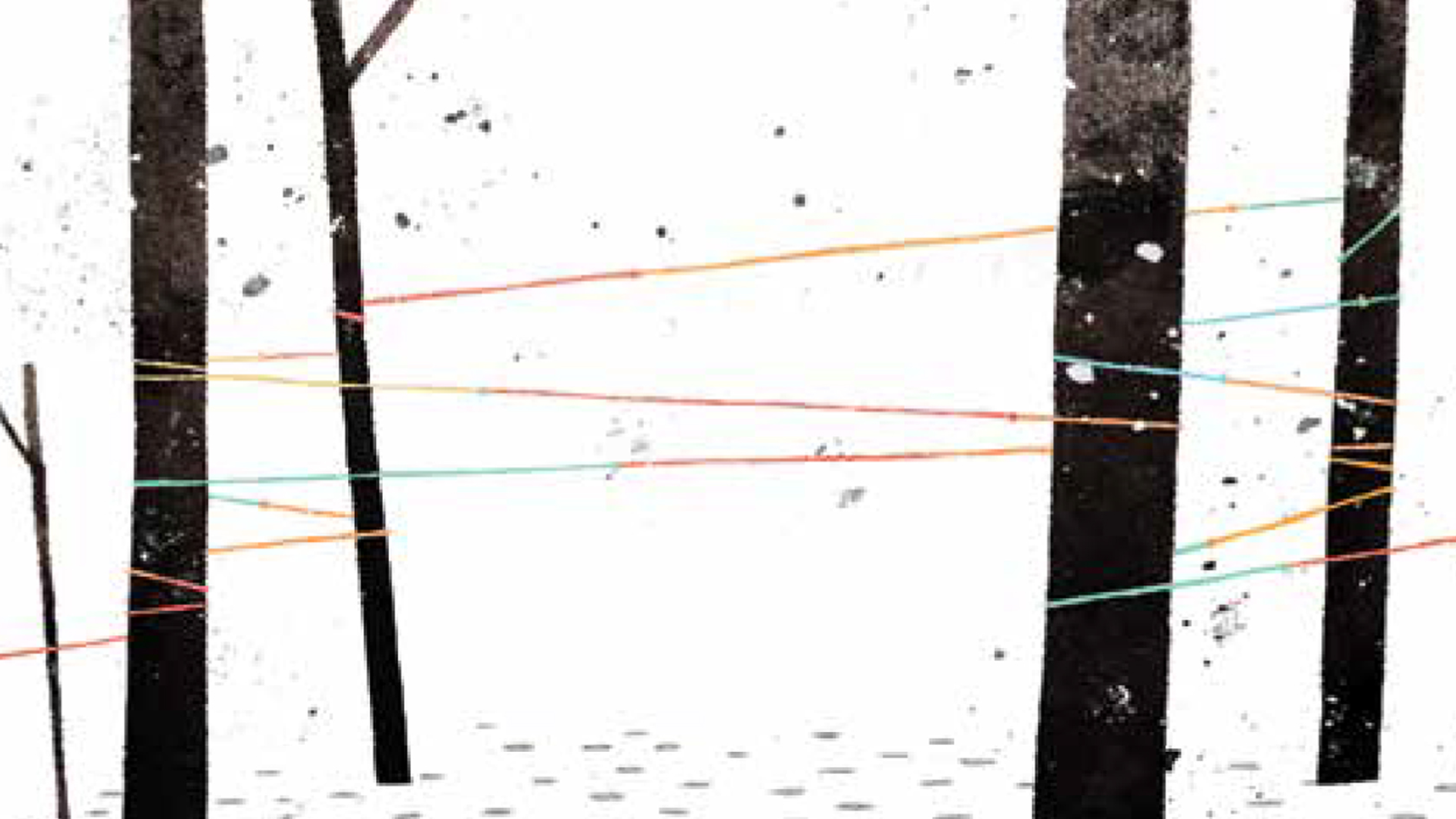
Playing – Don't touch the yarn
Yarn can be used to create a track for a single-rule game “Don’t touch the yarn!”. How do you play? Tie lots of pieces of rope, string and lace together to create long “yarn”, and wind it round the furniture and other objects in the room. Create an obstacle course that players must follow without touching the yarn: you can jump over it, crawl under it, or choose any creative way to avoid it, as long as you don’t touch it!

Doing some arts & crafts – familywear
Annabelle knit more and more colorful clothes that made all her townspeople happy. Like her, you too could create your very own attire as a family fashion statement. Think of the kind of special piece of clothing you would like to make: Should it be a certain color shirt? An interesting brooch? A bracelet, adorned hat, special socks, or other item of clothing your entire family agrees on?

Some more arts & crafts
Annabelle loves knitting. Are there any kinds of arts or crafts that both you and your child enjoy doing? Perhaps o
ne of you loves to cook, while the other is a plasticine sculptor? You may enjoy asking each family member what kind of art or craft they like to engage in, and suggest joining then to gain some hands-on experience.
Suggestions for arts & crafts activities using yarn can be found on our website and the PJLibrary Pinterest page.
Discussing – Friendship
Children yearn for friends and a sense of belonging, and the story about Arfy introduces this subject with all the complexities and heartaches that are sometimes associated with it. Yet Arfy has inner strength, and he chooses his own fate: his story allows us to hold a sensitive discussion about friendship, and the roads leading to it. You could, perhaps, ask your child what, in their opinion, is the reason for Arfy’s letters to different people. Would you have wanted to be Arfy’s frieds? Why? What would you have done in Arfy’s place?
Story-telling illustrations
Many pages in this book contain text-less illustrations demonstrating Arfy’s feelings. What do these illustrations tell us? Which of them make you smile, and why? What is Arfy feeling? What is he thinking?
Letter writing
You may be inspired by the letters in this book to write notes to one another. You could hide letters with encouraging or amusing messages under your pillow, in your bag, or anywhere else, and enjoy surprising your family members with them.
Treating animals well
Each of us can open our eyes and hearts to the animals around us – providing them with water on a hot day, setting up shelters, or anything else that would contribute to their wellbeing, and have a positive impact on the world in which we all live.
Reading and Discussing
You may want to tell one another some riddles you know, or share how you have found solutions to problems, situations and issues. Have you ever learned something by watching someone else? Perhaps you could ask other members of your family how they cope with riddle- and problem-solving. Together, you can create a collection of family suggestions to learn about and engage in problem-solving.
What do the illustrations tell us?
The illustrations in this book are extremely detailed. You may enjoy taking a close look at them, and telling one another what else they convey, beyond the text: Are any characters featured in them that are not described in the story itself? Perhaps you could follow the tiger character, and tell the story from its perspective: What is the relationship between the tiger and princess? Why does it follow her, and how does it experience the events that unfold?
Inspired by folktales
Authoress Ruth Calderon was inspired by an ancient folktale written by Rabbi Nachman of Breslov when she wrote this book. You could try it too! Think back to your favorite folktale or fairytale, and write a similar story about a contemporary boy or girl.
Comfort food
Do you also have a “ma’atzube” of your own – some kind of favorite comfort food? How about making a list of comfort foods, and then cooking or baking one together?
Problem-solving
“… Problems are just like bread – you need to slice them”: You may want to create a collection of everyday problems, and write them on pieces of paper. In each round, pick one note, and think of solutions together. They can be incremental, broken down into stages like slices of bread. Perhaps they can lead you to more suggestions.
Discussion – A story worth gold
The brave stork’s reward was… a story worth gold. Do you have such a family story? You could tell it to your children, and search for other family stories by asking your grandparents and other family members.
What did the stork say?
Imagine you were the stork – what would your thoughts be? What would you have said to the lion, and how would you have told the story? Try to tell it from the stork’s perspective. You may also enjoy drawing the story, or making costumes with which to act the story out. How about taking photos of your short play, and printing them out to create a book worth gold.
Brave as a stork or hardworking as an ant?
Animals in fables have human characteristics: the stork is brave, the lion is strong, and the ant is hardworking. Which animal best symbolizes you? Try to think and discover which animal is most similar to you, and write down sentences that characterize you, such as: “I’m as smart as a …”, “I solve problems like a …”, or “I love singing like a …”
A feast
Is the meal prepared by the lion appetizing? It’s time for a feast. You may want to prepare your family’s favorite food, draw animal characters on paper napkins, make a crown for each person sitting at the table, and eat together.

Discussing – Giving love
The Shamash understands that a flame is endless, much like love. What do you think? Can love keep growing like a flame, even after some of it has been given to others? Do we have enough love for all those we care about?

Inspiration – From one generation to another
The story of Hanukkah is passed down from one generation to the next. Do you have stories, songs, or recipes that are passed down in your family? After lighting the Hanukkah candles, you may want to tell your child how you celebrated Hanukkah when you were growing up, and add stories you heard from your own family. How about singing a good old family song, or preparing some food for all of you to enjoy?

Playing – Passing the love around
As you light the Hanukkah candles, watch how they pass the flame from one to the other. Just like the Menorah candles, you could pass the love around in your family: stand in a row, and pass round the love “flame” by giving each other hugs and kisses, or saying something nice. You could go round several times, if you wish, finding new ways of expressing love and passing it round to different family members each time.

Moving – The candle race
This game is similar to a relay race, only instead of passing a baton to the next runner, you pass a candle: each time one of your family members runs with the candle to a set point, where another family member is waiting to receive the candle and run on to the next spot. You may want to create a circular route where you play round and round, or one with a start and finish line. Did you manage to pass the candle on? Good job! Afterwards, you can pass round some cushions and drinks, and rest together.

Doing some arts & crafts – A de-light-ful greeting card
Hanukkah provides us with a wonderful opportunity to bring joy and light into our loved ones, neighbors, and family’s hearts: you may want to make a greeting card in the shape of a candle in which to write a heartwarming greeting that will light up your holiday and that of its recipient.

Reading & discussing
Reading & pausing – this story is comprised of several events, and we therefore recommend stopping every once in a while, and trying to think what will happen next: What will the children do? What secret will be revealed?
Together & separately – what is it that you do better together than you do separately? You may want to discuss this with your child, and share stories of successful collaborations you’ve had as children and adults with them.

The branches experiment
Having read this book, you may enjoy collecting some twigs or thin branches and finding out for yourselves: What happens when you try to break one as opposed to a bundle of them?

Encouraging and being encouraged
When the children in the story begin to get frustrated, their mother says: “It’s ok, don’t despair, sweethearts. We fall down, we get up, we overcome, and hold our heads up high”. What encourages us when we feel like giving up? Then how about coming up with a family cheer for when the going gets tough.
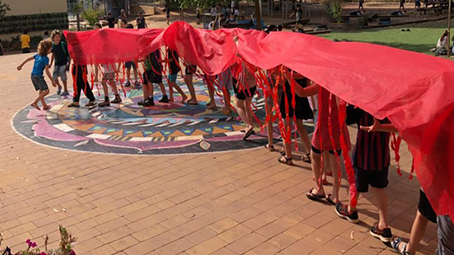
Making a dragon
To make your very own dragon, you will need a cardboard box, crayons, and some paper: you could cut out holes for your eyes and mouth, add on paper teeth and ears, as well as a cardboard tail. You could even make a family dragon, moving it in tandem – the dragon will only move if you all work together.

A childhood song – The Little Bunny [HaShafan HaKatan]
This book was inspired by the well-known children’s song The Little Bunny [HaShafan HaKatan] by Binyamin Caspi. You may want to ask your child which children’s song this story reminds them of, and then sing and dance together.
Do you have any other favorite children’s songs? You could create a family songbook, and select one to sing together from time to time. You too may be inspired to write a story about it.

Where are you in this story?
Reading both words and illustrations – You may enjoy taking turns reading this book to one another: you can read the words to your child, and then have them tell you the story using the illustrations.
Our table – draw an empty table and choose who to invite over: it can be family and friends, real or imaginary, favorite toys, or characters in books. What would you serve your guests? What do you think would happen when they all meet one another?

Inviting people round
Having a friend visit us is exciting. You may want to prepare for the visit together and discuss how to welcome this friend, how to pass the time together when they get here, and what to do if each of you prefers to do something else.

Kind words in our family
The bunny’s friends thank him, and he uses kind words when speaking to them, like “please”, “so glad you came over”, and “bon appetit!”. When you sit together for a family meal, you could take turns saying kind words to each other: the first begins by giving the one on their right a compliment; the second compliments the third, and so on. The compliment can be about something nice they had done, a good quality they have, having behaved pleasantly, or any other positive thing you can think of. If you look for it, you’ll be sure to find it…
Discussing – What can we see out of our window?
What can you see out of your window? What can you only see in your home? Can you see it through the window? What else makes you special as a family? Do you have a favorite song, or an activity you like to do together? Is there a fixed ritual on special occasions in your family, or something that will always make you all laugh? Perhaps there is a phrase or word that you have invented, or a word with a special meaning, that only your own family members understand? What is missing from your family that you wish to add? Something that would be seen through your window – a character, object, or animal? Perhaps something on which you could play a song?
Playing – it's me!
Who is this child? And who is this adult? – You may want to play a family game for boys, girls, adults, and children:
In each game round, a member of your family will think of one of the participants, and describe them indirectly. For instance: “The child I have in mind likes to play ball”, or: “The person I have in mind likes to drink coffee in the afternoon”. After the participant is described, everyone has to guess who the child or adult the player is thinking of is. You could also add friends and relatives with which all participants are familiar that are not physically present.
Reading the illustrations
Randomly open the book and look at the illustrations together:
Which character is similar to you? Which character are you different than?
What makes you similar to or different than the character you have chosen?
Which is your favorite character in the book?
Note – these questions may be asked every time the book is read. There are days, for example, when we prefer to be alone, whereas on others we choose to spend time together.
Playing – What can we see in the mirror?
The mirror game presents an opportunity to look at one another as well as ourselves, notice similarities and differences, and laugh.
Instructions:
Sit in front of the mirror with your child, look at each other, and find similarities and differences between you:
Are your eyebrows arched the same way as your child’s?
Do you both have freckles? Or curly hair?
Pulling Faces – one of you could pull a funny face, while the other tries to mimic it. Were you able to make each other laugh? Was it the same funny face that made you both laugh, or different ones?
Doing some arts & crafts – Similar but different
You could make a family picture together, and add your similarities and differences to it:
Take photographs of yourselves together or separately. If you prefer, you could draw self-portraits instead of taking pictures. Print the photos out, paste them on some cardboard, and paint them. Add drawings or newspaper scraps to your pictures with details representing the similarities and differences between you. Do you enjoy playing the same games? How about adding it, then? You could add the different games that each of you like to play. Perhaps one of you prefers quiet, while the other prefers noise. Are you fast or slow? Do you find the same jokes funny? What else would you add to your family photo?
Moving similarly – Moving differently
Would you like to be active? Here are some suggestions for physical exercises that consist of both similar and different movements.
In each round, one of your family members moves their body: eaves their hand, jumps, turns around, or touches their ears.
The person next to them then moves too: if they like the gesture made by the previous participant, they can move in a similar way. If not, they can choose a different movement they like better.
What did you enjoy? Repeating the same movement, or choosing your own?
Scan this code to download a family game we have prepared especially for you.
Discussing – What about our world?
What is your responsibility, as parents and children, for your friends, family, and environment? Which roles do you play within the family, and which additional roles would you like to assume responsibility for in order to help others and your surroundings? Perhaps you could discuss and make suggestions that would help your family in their day-to-day, such as: sweeping the porch; checking in with a sick friend; recycling bottles, paper, and bio-degradable materials; set the table for dinner, or tightly close leaking faucets.
Doing some arts & crafts – A family tree
Cut out some paper leaves. Each family member gets some leaves, and writes suggestions for actions that would be considerate of other members of the family, such as: leaving enough warm water for others to shower; feeding your pet hamsters, or saying ‘good morning’ with a smile. Make your tree in painting form or some other artform using recycled materials or tree branches you have collected, and attach all the leaves to it.
You could try to put your ideas to practice. How about deciding to try out one suggestion each day? And if it doesn’t go too well for you, don’t worry, tomorrow is another day…
Suggestions and examples can be found on the PJLibrary Pinterest page – The Juice Tree.
Playing – How can we pass leaves round?
The villagers must cooperate for the tree to grow more leaves. Games are a delightful way of working together as a family: cut out a paper leaf, and stand in a row. Ready? Here we go!
Pass the leaf round from one player to the next without touching it with your hands. If any of you struggle, help by giving them advice and cheering them on. By way of celebrating when the game is over, enjoy your favorite beverage.
Raise your glass to your cooperation, and the many collaborations still to come!
Continuing with the story
The book ends with Mr. Milly’s silence. He smiles, and helps water the tree. And then what happens? You could try to continue the story from this point: What was Mr. Milly thinking while he smiled quietly? What happened to the juice tree and the villagers? Did they keep on picking a single leaf? Or did something surprising happen down the line?
Proposed Family Activities:
- You may want to ask your child to leaf through the book and look at the illustrations. You could ask them what the sparrows are doing on each page, how they travel to their aunt, and where each of them falls asleep at night.
- Perhaps you could play the following game: take turns pointing at an illustration, while the other attempts to mimic the sparrow depicted.
- You will find many new words in this book! It may be fun to repeat the verbs used to describe the sweet sparrows’ actions. Does your child recognize the names of the musical instruments and modes of transportation?
- Do sweet sparrows fly in the vicinity of your home too? You may enjoy going for a walk around the neighborhood, looking up at the skies, and searching for birds. Can you hear them tweet too?
- Every member of the family can chip in and help run the family home. Many children find joy in the performance of simple tasks. You may want to ask them to set the table for dinner, help clear the plates away when it is over, put away their toys, and more.
- Does your child know the song Hineh mah tov uma naim? Perhaps you could sing and dance together. Or how about setting up a family band with home-made musical instruments? A rattle made of a jar full of dried beans, a guitar made of a shoebox and some elastic bands, and drums made of pots with wooden spoons for sticks will make for a fabulous family performance!
Proposed Family Activities:
- You may want to snuggle up and leaf through the illustrations together. You could ask your child to show you what Toto and La La are doing on each page. What kind of expression does Toto have on his face when La La refuses to share her bucket and spade with him? When are both friends smiling?
- Perhaps you could take some stuffed animals or puppets and act the story out together.
- At the end of the book, Toto and La La “party”. You may want to think of things that make you want to party, and how you enjoy partying with friends.
- Perhaps you would like to discuss the difference between personal items and those that belong to your entire family with your child. You could walk through the various rooms in your house, and identify those items that are “only mine”, such as a toothbrush, versus those who belong to the entire family, like the living room couch.
- Does your child enjoy playing with sand? You could do so at the beach, or even in your own garden or backyard. Use items found in every home along with your bucket and space: plastic boxes, sieves and strainers, spoons, funnels, etc.
- When friends come over, it is sometimes hard to share our toys with them. Perhaps you could decide in advance which toys to offer them, and which to keep aside. You may want to encourage your child to be kind to their friends when they come and visit, and share their games with them. You can later discuss the warm feeling you get when you make friends happy by sharing with them.
Ayin Hillel (1926–1990)
Ayin Hill (Hillel Omer) was born in Kibbutz Mishmar HaEmek in 1926. An author, poet, and landscape architect, Ayin Hillel often incorporated nature, landscapes, and animals into his poems. Many generations of Israeli children were raised on his literary gems, such as the Uncle Simcha stories, Why does the Zebra Wear Pajamas?, Yossi, Smart Child of Mine, and many others. Ayin Hillel also wrote poetry and prose for adults. He won many awards for his work, and passed away in 1990.
Proposed Family Activities:
- Rabbit’s tail appears in every illustration, but Rabbit cannot find it. You may want to ask your child to leaf through the book, and locate the tail on each page.
- You could attach a kerchief to the back of your child’s pants, and go searching for their tail around the house: Where is that tail hiding? Perhaps you could follow the route described in the book: under the bed, inside the shoes, under the pillow, in the kitchen, then the bathroom, and finally sit down. Like the rabbit in the story, your child can leap for joy when their lost tail is finally found.
- Can your child name their body parts? You may enjoy playing a game in which you ask your child: Where’s your elbow? Where’s your knee? Where’s your big toe? And have them point to each body part in turn.
- Rabbit looks in the bathroom and catches his reflection in the mirror. You may also want to stand in front of the mirror with your child, name one of the emotions felt by Rabbit throughout the book, and make the corresponding facial expression: smile to show joy, make a concerned face, get excited, and so on.
- Who has a tail? Perhaps you could take out some stuffed animals or look through a picture-book to discover what other animal has a tail. Which has long ears? What other animal can leap and jump?
delicious carrot cake
- What does Rabbit like to eat? Carrots, of course! How about making a delicious carrot cake together?
Ingredients:
2 eggs
½ a cup of sugar
1/3 cup of oil
2 medium-sized carrots, grated
1 cup self-raising flour (or 1 cup of white flour mixed with a teaspoon of baking powder)
½ a teaspoon of baking soda
1 flat teaspoon of cinnamon
Method:
- Preheat the oven to 180 degrees
- Mix all the ingredients in the order in which they appear
- Put the batter in an oiled baking pan, and bake for 20-25 minutes. Insert a toothpick into the cake, and when it comes out dry, the cake is ready
- Sit in the kitchen, eat the cake together, hug each other, and enjoy
Proposed Family Activities:
- You may want to snuggle up and look through the book together. You could follow Tani’s facial expressions and ask your child: How, do you think, Tani felt when his sister chose to give Mama a flower?
- We suggest pausing at the page on which Tani announces that he, too, needs a box for his gift, and asking your child: what will Tani’s gift for his mother be, do you think? What gift would you like your child to prepare for you?
- You could act the story out using puppets. Together, you can imagine what the puppets will do with their mother at the end of the play.
- Perhaps you could play a game called “what’s the gift?”. Each player in turn picks a toy or small object and puts it in a box. The other players try to guess what is in the box by asking questions and receiving clues. For example: Is the gift an animal? Is it something yummy? Is it made of wood?
Were you able to guess which gifts were hiding in the boxes?
- You may want to tell your child how you honored or are currently honoring your own parents, and remind one another of the ways in which your child honors you. Together you can think of an older family member you could honor – perhaps by giving them a flower or hug, or surprising them with a phone call.
- How about choosing a box and decorating it with stickers, drawings, and ribbons? Perhaps you could decide together to whom you will now give it.
Proposed Family Activities:
- You may want to leaf through the book together, and notice the combinations of words and illustrations. Is your child familiar with many of the words comprising Jim’s collection?
- Perhaps you could open a dictionary, or go to Milog at milog.co.il, to show your child just how rich the Hebrew language is. You could even create a family dictionary: decorate a special notebook, adding new and interesting words to it each time. Your child could illustrate the dictionary too.
- You may want to ask your child why they think Jim chose to empty his collection into the wind. Is there anything that makes you particularly happy that you would like to share with others?
- Like Jim, many children enjoy collecting things – pebbles, cards, special napkins from cafes. Did you have a collection as a young child? Share those memories with your child, they may inspire them to continue the family tradition, or start a collection of their own.
- Words are a great way of expressing our feelings. Perhaps you could make notes, write your feelings on them, add a drawing, and stick them on your fridge, front door, or headboard. These notes may be used when we want to express our feelings and cannot seem to find the right words to do so.
- Do you remember any words your child mispronounced when they were just learning to speak? If so, share them with your child, and write them down so that you will never forget.
Proposed Family Activities:
- You may want to look at the illustrations together, and suggest that your child describe what the chairs turn into throughout the book.
- While reading the story, you may want to pause before the children reach one of the stops, and ask your child to guess, based on the rhyming scheme – where the children will end up.
- Have you ever visited the cities mentioned in the book? Perhaps you could look at the illustrations, and use them to describe the special features in each of the locations. You could also look for more images of these sites online, and compare them with the illustrations in this book.
- Like the children in the story, you could also let your imagination run wild, and transform the chairs around your home into different things. A chair covered with a blanket could become a tent, or a secret cave.
- You could go on a trip nearby. Choose your destination with your child, pack some snacks, invite some friends, and go on an afternoon excursion. You could even have a picnic, so that “by the time you get off the cloud, lunch will be ready”.
- Where is Tel Aviv? And where is Jerusalem? Where are the mountains, the Sea of Galilee, the Mediterranean, and the Red Sea? Perhaps you could open a map together, and mark the places where you and your extended family live, places you have visited, and places you would like to visit as a family.
Who was Rabbi Akiva?
Rabbi Akiva, one of the greatest Jewish Rabbis, lived in Eretz Israel between 50 and 137 CE, from the destruction of the Second Temple to the Bar Kokhba revolt. He partook in the writing of the Mishna and in forming Halacha, and was the spiritual leader of the Bar Kokhba revolt. Many legends and stories have been written about Rabbi Akiva, and numerous sayings attributed to him. One of his most famous statements are: “Amar Rabbi Akiva: ‘Veahavta lereacha Kamocha – zeh klal gadol baTorah (And Rabbi Akiva said: ‘Love thy neighbor’ – that is a major rule of the Torah”) (Bereshit Rabba, 24:8). Rabbi Akiva started out as a shepherd, and only began to study Torah at the age of forty. His life story, like that of many leaders and sages, teaches us that Torah and knowledge are available to all of us, at any time.
Proposed Family Activities:
- You may want to ask your child to look for the illustration of the donkey with the garden on its back. If that donkey could speak, what would it say? How does it feel, and what does it think? Perhaps you could make up a dialog between Rachel and the donkey. Suggest that your child choose one of the characters, and share an imaginary conversation with each other in which Rachel and the donkey express their feelings and intentions.
- Have you ever avoided learning something in a new area because you were too embarrassed to do so? Perhaps you too have learned something at an older age, such as a new language, learning to play a musical instrument, or a new profession? You may want to share those experiences with your child. You could even ask them to teach you something that they can do well. Or how about going somewhere together and learning something new? Because the bashful cannot learn!
- Rachel plants a garden on the donkey’s back. You may enjoy finding an old pair of shoes, a teapot or an old hat, filling them with soil together with your child, and planting a garden of your own.
- Many stories have been written about Rachel and Rabbi Akiva. You may want to look for more tales about these exemplary characters at home, the library, or online, in order to become better acquainted with them. If you are familiar with the tune of this song, you could sing together: “Amar Rabbi Akiva: ‘Veahavta lereacha Kamocha – zeh klal gadol baTorah (And Rabbi Akiva said: ‘Love thy neighbor’ – that is a major rule of the Torah”).
Proposed Family Activities:
- Pepper’s nose is blocked and he has a terrible cold (or as the Hebrew original puts it “betsudad dora”). Can you understand what he says? Try blocking your nose and reading Pepper’s dialog. You could also ask your child to translate “cold” into Hebrew, and invent new “cold” words.
- The story is long and suspenseful. You may want to pause at the point where Joezer announces “We’re in trouble”, let your child guess the rest of the plot, and resume reading another day.
- You could ask your child who, in their opinion, had invented the story – Jo or Pepper? You may also enjoy making up your own story, and taking turns to do so. Start the first sentence, then ask your child to add one of their own. Keep going, taking turns, until an entire story comes together. You could even write it up, and draw some illustrations to go along with it.
- Pepper (as well as Marheshvan) is a funny name for a bunny! Does your child know that the month of Heshvan is also called Mar-Heshvan? Mar is Aramaic for drop, and during the month of Heshvan we expect rainfall. Some say the word Mar was added to the name of this month because it is the only one in which we do not mark a single Jewish holiday or fast day. Can your child name all the Hebrew months of the year? You may want to check the Hebrew birthdays of all your family members, and create a Hebrew birthday calendar for the entire family.
- Are any of your child’s classmates unwell? Perhaps someone around you is feeling a little sick? You could think of ways of making them feel better together, like making them a hand-drawn greeting card, calling them, taking over something yummy, or properly visiting them, story and all!
Proposed Family Activities:
- You may want to leaf through the book together, and look at the special illustrations. Perhaps you could ask your child to notice the different perspectives and angles from which the illustrator chose to draw Mooha and Booha: up close and from afar, from down below or high above, from the front and back. You may enjoy picking an object at home, and trying to draw or photograph it from various angles.
- How about acting the story out together using puppets? You could suggest that your child try to convince the cows to stop bickering, and enjoy their grass.
- It is often difficult to admit that we are jealous of others. Perhaps you could share an incident with your child in which you were jealous of someone else when you were growing up, and how you coped with that feeling.
- Mooha and Booha cannot enjoy their own grass, because they focus solely on what the other has. You may want to toss a ball between you, and have each of you say something good that makes them happy as you take turns catching the ball.
- Seasons change, the green grass turns yellow, and the cows cannot stop fighting. Perhaps you could make a “grass head” using old stockings, some soil, and grass seeds. Take care of the grass head together, and discover how long it takes for the grass to grow at its top.
Proposed Family Activities:
- You may want to snuggle up to each other and look at the illustrations together. What does Big Wolf do before Little Wolf comes along? Perhaps you could suggest that your child leaf through the book, and tell the story in their own words. You could also try to tell the story from Little Wolf’s perspective.
- You may want to ask your child to look for the illustrations in which Big Wolf helps Little Wolf. What does he do for his friend throughout the book? You could think of your friends together, and remember the little things you do for one another.
- You may enjoy tying two inner toilet paper rolls with some string to make binoculars. You could climb up a hill, and try to locate various objects using the binoculars you made. What is the furthest thing each of you was able to spot?
- When Big Wolf first sees Little Wolf, the latter is no more than a dot on the horizon. You may want to take a blank sheet of paper, and draw together – start off by making a small dot, then ask your child to add some detail to the picture, and keep on taking turns as you go along. What has your dot turned into?
- Big Wolf misses Little Wolf, and awaits his return. You may want to remind your child of a friend with whom they have not spent time recently, and suggest inviting them over.
Proposed Family Activities:
- You may want to act out the story using puppets, and invite each character to explain how they ended up being friends.
- There are two illustrations of the house in the final pages of the book. You may want to ask your child if they can spot the difference between them. What’s been added to the second illustration?
- Is there a teacup, piece of furniture, or photograph that’s been in your family for a long time? Perhaps there is an interesting story associated with this item. If so, you may enjoy sharing it with your child.
- Your child may like to draw your home and loved ones. Together, you can make a frame for their drawing, and hang it up on the wall.
- Have new neighbors come to your neighborhood recently? Perhaps you know new Olim who have arrived in Israel not too long ago? You may want to make a greeting card for them in the spirit of this book, and print the word “welcome!” on it.
- Where does your family originate from? Perhaps you could open an atlas, and show your child the journey made by your family on their way to Israel. You may want to tell your child about your own childhood home, and show them photographs of homes in which you have lived over the years.
בדיוק אותו דבר – דתיה בן דור – מתוך "פרפר נחמד"
בדיוק אותו דבר – דתיה בן דור – מתוך “פרפר נחמד”
A recipe for Tali's Grandma's apple pie
Ingredients
2 eggs, whisked
2 apples, peeled and diced
2 tablespoons of brown sugar
1 tablespoon of cinnamon powder
I cup of self-raising flower (or 1 cup of regular flour and a teaspoon of baking powder)
2/3 cup of white sugar
½ cup of oil
A pinch of salt
Method
Pre-heat the oven to 180 degrees.
Mix the diced apples with the cinnamon and brown sugar.
Whisk the eggs and white sugar together, and add the rest of the ingredients.
Mix the batter well.
Bake for 30-40 minutes until the pie is firm and golden.
Serve hot next to a scoop of vanilla ice cream.
Proposed Family Activities:
- You may want to look at the illustrations closely together. You could ask your child to pick a character, and tell the story from his/her perspective.
- Perhaps you could ask your child what Shira did by joining Tali under the table. You could share ideas for ways out of situations in which you feel angry, sad, or upset. You may want to share an experience in which you helped cheer someone up.
- It is not always easy to discern how others are feeling. You may enjoy standing with your child in front of the mirror, taking turns to make faces, as the other guesses which emotion those faces are designed to convey.
מה עשתה שירה
אפשר לשאול את ילדיכם מה עשתה שירה כשהיא הצטרפה לטלי מתחת לשולחן. אפשר גם לשתף זה את זה בשאלה מה עוזר לכל אחד מכם לצאת ממצבי כעס, עצב או עצבנות. תוכלו להיזכר בפעם שעזרתם למישהו ושיפרתם את מצב הרוח שלו.
לא תמיד קל לזהות את הרגשות של האחר
לא תמיד קל לזהות את הרגשות של האחר. תוכלו לעמוד עם ילדיכם מול המראה, כל אחד בתורו יעשה פרצוף מול המראה, והשני ינסה לנחש איזה רגש הוא מביע.
האזינו לסיפור "החוצה"
הימים האלו עכשיו הם ימים לא רגילים, ובימים כאלה סיפורים יכולים לשמח, לרגש, אפילו להצחיק. אנו מזמינים אתכם/ן להאזין להקלטה הקסומה של הספר “החוצה”, מאת: רינת פרימו | איורים: איתי רייכרט | ידיעות ספרים.
האם יצליח אבא ללמד את איתמר שגם המסדרון, חדר המדרגות ואפילו הרחוב הם שלו? האזינו לסיפור וגלו!
יוצרים ומגישים: ירדן בר כוכבא – הלפרין ודידי שחר
מוזיקה ונגינה: טל בלכרוביץ’
פתיח ההסכת ולחן השיר בסיפור “החוצה”: דידי שחר

Proposed Family Activities:
- You may want to lead through this book, and look at the illustrations together. You could ask your child to tell you the story in their own words based on the sequence of illustrations.
- Perhaps you could ask your child for their opinion as to why Itamar’s father tells him that the corridor, stairwell, and street belong to him too.
- Perhaps you would enjoy taking a walk in the neighborhood, and discovering the buildings, roads, and landscape near your home. Does anything in the shared spaces need improving or cleaning? Perhaps you could initiate a local activity, such as tidying up and decorating the stairwell in your building, or setting up a community garden.
- Your child can join Itamar by tidying up their room, and sorting through their toys. Perhaps you will find long-forgotten “treasures”! You may want to decide what to keep and what to throw out, or donate to others, together. You can also try to fix broken toys, or think of ways to recycle some items, and use them in a new way.
- Do you also have some broken crayons you were thinking of throwing out? They can be recycled! Sort them into similar shades, peel off their paper labels, and place them into a paper or silicone baking tray. Bake at a low heat until the crayons melt, cool the mixture, take out of the baking tray, and enjoy your new, multi-colored crayons!
Proposed Family Activities:
- You may want to leaf through the book and look for all the activities that the brothers do together. Perhaps your child can think with you about all the things around the house that are easier and more fun to do together by joining forces.
- There are many words in Hebrew that describe farming. Does your child know the names of all the different actions? You could look at the illustrations depicting farming activities in the book, and try to do the same using hand gestures.
- Each of the brothers is considerate of the other, and gives up his share without ever having been asked to do so. You may enjoy making an illustrated list together of examples of actions that show how each of you has conceded and helped members of your family.
- Like the brothers in this book, you too can make a heartwarming surprise for your child during the night, to which they will open their eyes in the morning. Afterwards, your child may surprise you too!
- The brothers in this story understand that dividing things up equally is not always the fairest method, and therefore each of them wishes to give up some of his share for his brother. You may want to discuss the different needs of your own family members, and promise your child that even when they do not get exactly the same things as their siblings, they too will always get what they need.
- “Each of us has a city called Jerusalem” (Natan Yonatan): the book informs us that the Temple in Jerusalem was built on the exact spot where the two brothers met. Having read this story, you may want to look for pictures of Jerusalem together, sing songs about the city, and tell your children about “your Jerusalem”.
Proposed Family Activities
- You may want to pause as you read and ask your child: Where do you think the cat is rushing off to? Why is Mr. Goat blocking the way? Will the vixen eat all the raspberries that she has picked herself?
- Perhaps you would enjoy taking a look at the illustrations in this book together: Have you noticed Duck’s and Porcupine’s special eyebrows? Can you discern who is angry and upset, and who is happy and relaxed judging by their eyebrows alone? You may want to sit one opposite the other and take turns to cover your face, leaving nothing but your eyebrows visible. Now, pull a face – happy, surprised, angry, or sad – and ask the other to guess which emotion you were trying to express by your eyebrows alone.
- You could make a finger theater using eyeliners and lipsticks: draw needles on the back of your finger, and a nose and mouth on the front – and you have got yourself a porcupine; paint the thumb and forefinger of your other hand red with some lipstick, so that their tips form a bill – and you have got yourself a duck. Use both hands to perform a show based on this book. Which hand is quick to judge? Which hand gives others the benefit of the doubt?
- Perhaps you could share a story with your child about a time when, like the duck in this book, you were quick to jump to conclusions about others’ actions. When something unpleasant happens, we can try to adopt the “porcupine” approach, and repeat the phrase “maybe, possibly, perhaps” together.
Proposed Family Activities:
- You may enjoy looking at the special illustrations together while reading the book. You may want to discuss whether letters can indeed have feelings, and whether you recognized the boy who received the letter at the end of the book.
- What is known and unknown in the book? Perhaps you can guess: What did Nitay’s mother, Lily, whisper in his ear at night? What did the letter say? Why was the man on the bus angry? And why were the old man and his daughter sad? Remember, there are no wrong answers – that’s the magic of the story!
- The illustrations combine photographs with drawings. You may want to print out a family photo or a picture of your child on a black and white printer, and then color in the printout using color pencils, enriching it with color and a creative imagination.
- Sometimes we keep special letters for a long time – official letters, love letters, or letters we received from friends. Have you also kept any special letter? Perhaps you could share such a letter with your child, and tell them who wrote it to you, and what it is about. Inspired by this book, you could start writing letters to one another, and keeping them in a special place.
- A letter need not be long, and does not necessarily require an envelope. You could surprise your child by sticking notes on their lunchbox or bathroom mirror, or placing them under their pillow. Whichever way you choose – spreading a good word wherever you go is the best!
- Who would love to receive a “magical letter” from you? Perhaps a member of your family, a neighbor or classmate? You can go ahead and write one together, put it into an envelope, and mail it. You would not believe how much happiness a letter can bring.
- How about writing a letter in invisible ink? Squeeze a lemon, dip a cotton swab into the lemon juice, and use it to write a note on a white sheet of paper. Your hidden message will only be seen by those who shine a flashlight under your letter.
Proposed Family Activities:
- Shulamit’s facial expressions change throughout the book. Perhaps you can look at the illustrations together, and pay close attention to those changes. When does her smile disappear? And when does it reappear?
- In the illustrations depicting the story that Shulamit tells herself, she seems very small compared to the tall buildings and her surroundings. You may want to ask your child for their opinion as to why Ora Ayal chose to draw Shulamit so small, inquire whether they ever feel small, or alternatively, when, if ever, they feel big.
- Perhaps your child could “read” the story to you, even if they cannot yet read the text. You could also act the story out together. Try switching roles: you can play Shulamit, who goes from room to room, asking members of her household to read her a book; while your child can play the other characters, explaining that they are currently unavailable.
- Many children find it difficult to keep themselves busy while waiting for their parents to spend time with them. You may want to use an alarm clock or hourglass to mark the end of your child’s “alone time”, and plan which book you will read together when it is over.
- Perhaps you could invent your own story, taking turns. One of you begins with “Many years ago in a faraway land…”, and you go on taking turns, adding characters and plotline, until you reach the end of the story. You could even write up and illustrate the story, and make a small book out of it.
- A Girl all be Herself is about experiencing both loneliness and togetherness. Having read the book, you may want to discuss feeling lonely with your child. You could tell them that we all feel that way sometimes, and think of coping methods together.
- Do you know any other books written or illustrated by Ora Ayal? You may want to look for more of her books at home or in the public library, and read them alone or together.
- Shulamit asks her household members to read her a story in the afternoon, “just like she always does”. Do you also have a certain time for reading books and storytelling? Is it the right time for everyone? Having read this book, you may want to schedule a “family story time”, starting a new family tradition.
Ora Ayal
Ora Ayal 1946–2011
Ora Ayal wrote and illustrated more than 70 children’s books. She illustrated many books written by top Israeli children’s authors, such as Miriam Roth (Tale of Five Balloons [Maʹase Ba-Chamisha Balonim], Hot Corn [Tiras Ham], and Yael’s House [HaBayit Shel Yael]), David Grossman (the book series on Itamar), and Ronit Haham (Five Witches Went for a Walk [Hamesh Mekhashefot Halkhu Letayel]). Among the books Ora Ayal both wrote and illustrated are: One Tuesday Morning [Boker Bahir Ehad]; Ugbu; and The Great War [HaMilhama HaAdira]. Her illustration style is simple and easily identified, and her well-loved books have been a source of delight for thousands of Israeli children. Ora Ayal has won many awards, among them the Andersen Children’s Literature Award, and the Ben-Yitzhak Award.
Proposed Family Activities:
- You may want to snuggle up and look through the book together. Ask your child some of the following questions: did any of the illustrations make you smile or sad? Are you familiar with all the animals in the book? Do you think they all make suitable pets? Try to imagine being able to have an unusual pet: which one would you choose?
- We suggest taking a moment at the page on which the boy and his tiny elephant reach the pet club, and reading the sign out loud. You could discuss what, in your opinion, is the reason why elephants are not allowed into the club. How does that make the boy and his tiny elephant feel? Before you go on reading, you could perhaps hazard a guess as to what the boy would do next.
- How about making a model pet club from a shoebox, and acting the story out together using some puppets. You could enhance the story by making up conversations between characters.
- “Because that’s what friends do” – you may want to share a special friendship you had during your childhood with your child. What did you enjoy doing together? Which games did you play? Who are your child’s friends, and how do they like to spend their time together? Is there a boy or girl from kindergarten who has never been round to your house? Perhaps you could have a gathering of friends of all ages – because all are welcome to the family club!
- You may enjoy making a sign for your child’s bedroom together, and writing a welcoming greeting on it, such as “all are welcome here”, or “welcome, one and all”.
Enjoy reading and discussing the book together!
You may want to snuggle up on the couch together
You may want to snuggle up on the couch together, give your child a kiss, and ask them when they like to be kissed, whether they like to be woken up with a kiss, and who they like kissing.
While reading the story
While reading the story, we suggest pausing before the kiss sprouts, and asking your child whether or not they think the kiss will indeed grow. You could let them leaf through the book, and try to discover the rest of the story for themselves.
Little Miss plants
Little Miss plants, waters, and cares for her kiss. Your child can also help you plant some flowers or grow a vegetable patch. You could also sprout beans or chickpeas, and observe the magic of growth.
You may enjoy going on a kissing spree around the house
You may enjoy going on a kissing spree around the house, giving all family members kisses, calling your grandparents, uncles, and aunts and blowing them kisses over the telephone, and feeling how pleased kisses make your entire family, and how much joy they bring.
You may want to put on some lipstick, and fill a blank sheet of paper with colorful kisses
You may want to put on some lipstick, and fill a blank sheet of paper with colorful kisses. Once your sheet of paper is full, you can cut out the kisses, and use them to decorate your child’s bedroom.
6. How about baking kisses
How about baking kisses (Hebrew for baked meringues) and giving them out to your loved ones?
Ingredients
8 egg whites
1 ¼ cups of sugar
1 teaspoon of fresh lemon juice
Method
Heat your oven to 130 degrees.
Whisk the egg whites with the sugar and lemon juice until the mixture is stiff and glossy.
Line a baking pan with parchment paper, put the mixture into a pastry bag, and pipe meringues onto the pan.
Bake for approximately two hours.
Give away your meringues (kisses) to all your friends, neighbors and family!
Enjoy reading and doing the activities together!
Leah Goldberg
Leah Goldberg (1911–1970), born in Kaunas, Lithuania, was a poetess, authoress, translator, professor, and editor, while also heading the Comparative Literature Department at the Hebrew University of Jerusalem. At the age of 23 she had completed her PhD on Semitic Linguistics in Germany, and upon immigrating to Israel in 1935, began to publish her writings, and soon became a well-loved and well-known poetess. Her publications, and among them her children’s stories and poems (Apartment to Rent [Dira Lehaskir], Magic Hat [Kova Ksamim], What do the Does do? [Ma Osot HaAyalot?], and many more) have become invaluable gems of Israeli literature. In 1970 she was awarded the Israel Prize for Literature; however, having unfortunately passed away several months prior to the ceremony, her mother received it on her behalf.
Enjoy reading and discussing the book together!
Family Activities:
- You may want to huddle together, leaf through the book, and ask your child to look for what each character received in exchange for the nuts. Pay attention to the facial expression of those receiving the nuts. Perhaps you could look in the mirror, and see what you look like when you smile with joy.
- How about looking for puppets or toys who could represent the dwarf, squirrel, lumberjacks, prince, princess, and child, and give a puppet theater rendition of the story together?
- Were you surprised by the ending? Perhaps you would like to make up your own, and illustrate it.
- The characters in this book sing when they are happy. What do you like to do when you are happy?
- Do you know any other stories or poems by Leah Goldberg? You could go over to the bookshelf at home or the local library, and look for some, such as The Scatterbrained Man from Azar’s Village (Hamefuzar miKafar Azar), Apartment to Rent (Dira Lehaskir), or The Bad Boy (HaYeled HaRa).
- The nuts in this book are magical: “whomever discovers their secret will be the happiest in the world”. You may want to share with one another what makes each of you happy. Are the same things that make you happy make your child happy too? Perhaps you can think of a family member or friend who you can surprise with something that will make them happy. How about making them some home-baked nut cookies?
Golden nut cookie recipe
Ingredients:
1.5 cups of flour
0.5 a cup of chopped nuts
150g of butter
100g of powdered sugar
1 teaspoon of vanilla extract
0.5 a teaspoon of powdered coffee
Method:
- Pre-heat your oven to 180 degrees
- Mix all the ingredients into dough and cool for an hour
- Roll the dough into nut-sized balls
- Place them on a lined baking pan and bake for 10 minutes
- Cool and store in a sealed jar
Proposed Family Activities:
- You may want to suggest that your child leaf through the book. What is Oren holding upon returning from his walk with his father? Which toys did the children bring the turtle? You could also look for Oren in the illustrations throughout the book. In which of them does he seem happy, and in which does he look sad? Can you explain why?
- Perhaps you would enjoy taking a short walk near your home. You could take turns looking up, down, to your right, and to your left, and announcing what you see. For instance: “I see an ant!”, or “I see a pinecone!”. Do you notice the same things?
- Does your child know what every animal likes to eat? And where it lives? You may want to discuss the right way to treat animals with your child. Together, you can think which animals can be suitable pets, and how to care for them. Even small children can take part in caring for a household pet.
- You may want to make a turtle shell using a pinecone, a disposable plate, or a finished toilet paper roll. Attach four legs and a head made of cardboard to it, paint it, and have fun owning a pet turtle! You can also use it to act this story out.
- At the end of the book, Oren wishes for his mother to find the turtle again. Together, you could write a sequel to this story. What do you think happened? Where did the turtle go? Did Oren run into it again while taking a walk in the woods? Do you think the turtle remembered him? Did they become friends?
Mira Meir 1932–2016
Mira Meir was born in Lodz, Poland, and relocated to Tel Aviv at the age of 5 along with her family. After completing her military service, she moved to Kibbutz Nahshon. Meir was an author and poet who wrote for both adults and children, and engaged in editing and translating as well. She won many awards for her literary work, including the Zeev Prize for Lifelong Achievement, the Minister of Culture Award, and the Hebrew Authors’ Prize. Among her well-loved children’s prose and poetry books are: Shluly [Puddley]; Maʹaseh She-Haya Kah Haya [Once Upon a Time]; and Paʹam Haya Yeled Shelo Ratzah Lishon Levado [The Boy Who Wouldn’t Sleep Alone].
Ora Ayal 1946–2011
Ora Ayal wrote and illustrated more than 70 children’s books. She illustrated many books written by top Israeli children’s authors, such as Miriam Roth (Tale of Five Balloons [Maʹase Ba-Chamisha Balonim], Hot Corn [Tiras Ham], and Yael’s House [HaBayit Shel Yael]), David Grossman (the book series on Itamar), and Ronit Haham (Five Witches Went for a Walk [Hamesh Mekhashefot Halkhu Letayel]). Among the books Ora Ayal both wrote and illustrated are: One Tuesday Morning [Boker Bahir Ehad]; Ugbu; and The Great War [HaMilhama HaAdira]. Her well-loved books have been a source of delight for Israeli children, and she has won many awards, among them the Andersen Children’s Literature Award, and the Ben-Yitzhak Award.
Proposed Family Activities:
- You may want to leaf through the book together, and look for all the animals: the hedgehog, rabbit, squirrel, and mouse. Have you discovered any other animals hiding in the woods?
- It may be advisable to read the story several times to allow your child to remember the sequence of events, and join you as you read the recurring lines: “רעבים ביער לא חסר, כדאי מאוד להסתתר” [“Many in the woods are hungry, it is best to hide”], and “התפוח גדול, אפשר גם לכבד” [“It’s a big apple, we can share it”].
- You may enjoy discussing moments in which we share with or give to others together. Remind your child how we host friends, share toys in kindergarten, or offer others some of our yummy snack.
- Each animal has a unique way of walking: the hedgehog takes small steps, the rabbit hops, the squirrel skips, and the mouse pitter patters. You could play charades together, imitating the various characters in the book: one of you does the imitation, while the other guesses which of the characters they are pretending to be.
- You may enjoy acting the story out using stuffed animals you have at home. You could also make animal costumes using old fabrics: cut various shaped ears, attach them to hair bands, and become hedgehogs, rabbits, squirrels, and mice.
- The friends in the book enjoy a meal together in which each of them gives and gets from the others. You may enjoy organizing a picnic with some friends or neighbors, in which each of you brings something from home, and shares it with the others.
- You could make a pinecone hedgehog with your child, and ask them to paint it with some paints and a paintbrush. Who will be the happy recipient of this colorful gift?
Proposed Family Activities:
- Have you noticed how the illustrator chose to depict the cat and rabbit as children in disguise? Does your child also like to play dress-up? You may want to put on some ears and tails and take a trip together.
- You may enjoy looking for the pages on which the cat and rabbit eat. What sounds do they make while eating? Try to listen to the sounds we make when we drink from a straw, have an ice-cream, or eat a crunchy apple.
- Perhaps you could act this story out using rabbit and cat puppets. You can use leftover fabrics or old socks to make your own.
- Do all of your family members like eating the same food? Which of you drink from a bottle, and which of you have hot coffee in a mug? You may want to suggest that your child try out new dishes every once in a while. Did they like them? Remember, there is no accounting for taste.
- You may enjoy inviting a new friend home, and finding an activity to do together that will make both friends happy: taking a walk, drawing, building something, or reading this book.
Proposed Family Activities:
- Perhaps you would enjoy taking a look at the illustrations together: can your child name all the shapes on every page? While reading the story, you may want to pay attention to the shapes’ facial expressions. When are they happy? And what makes them smile?
- You may enjoy using some colored paper to cut out shapes, or playing with a ready-made game of shapes. Together, you could invent other combinations of shapes, and create more things.
- Perhaps you would enjoy going on a search, and discovering the shapes that are hidden in books, toys, and various rooms of your home, such as the square floor tiles of your living room, or the round holes in your sieve.
- You may want to play with building blocks, and use the different shapes to create various artistic structures together. For although it is sometimes nice to be alone, it is so good and pleasant to play together!
- Does your child know the song Hinneh ma tov uma naim (“Behold, how good and how pleasant…”)? Perhaps you would enjoy singing it and dancing together.
- On the final page of the book, the shapes create a windmill together. Has your child ever seen a windmill? You may want to make a paper pinwheel, blow on it, and see how the rush of air moves its wings, just like a windmill.
Proposed Family Activities:
- You may want to read this story several times, and look at the special illustrations together. You could ask your child: how can you tell from the illustration that Guy is not feeling well? How does each member of his family try to help him get better? You could search for pictures of Yoyo the dog, and ask what it is doing on each page. Perhaps your child could tell you the story in their own words according to the illustrations.
- Mom, Dad, Grandma, Grandpa and Yoyo try to cheer Guy up and make him happy. Each of them does what they can and think is best for him. You may want to share a memory with your child of a time when you had gone to visit a sick person, or a time when you were sick and received a heartwarming visit.
- Often children are unable to visit the sick, but they can still help them recover, and cheer them up. Do you happen to know anyone who is unwell? You could encourage your child to draw a greeting card for them, call them up, or make something yummy for them, to try and help them get well.
- Perhaps you would enjoy opening a “toy clinic” at home in which to treat your dolls and stuffed animals. You could also play together: you could be the patient, and your child could pretend to be your doctor, or vice versa.
- Grandpa makes sweet, hot tea for Guy. You can also make delicious herbal tea, if you like, to warm up your entire family: place some herbs in a teapot (mint, rosemary, lemongrass or sage), pour boiling water over them, and sweeten the hot beverage. Enjoy!
Look Together
You may want to look at the illustrations together, and compare Gal’s home and kindergarten to the area in which Grandpa Raphael lived so many years ago. Together you may enjoy imagining what your life would have been like had you lived in another place, at another time. If you happen to have old pictures documenting the roots of your own family, you could show them to your child, and try to identify your family members together, as well as the places in which they lived back then, and now.
The Meaning of My Name
Does your child know why they were so named? Having read this book together, you may want to share the meaning of their name with them, and the story leading up to choosing it for them. You could also tell them what made your parents so name you.
Our Village Todgha
Do you know the tune to the song Our Village Todgha by Yehoshua Sobol performed by music group Habreira Hativ’it (The Natural Selection)? Perhaps you would like to sing it together with your child
Remember Together
Just like Gal, many children enjoy listening to stories about the past. Do you remember any festive occasion from your days in kindergarten and school? Perhaps you could share your learning-related childhood memories and family traditions with your child.
Fun with letters
Young children learn from enjoyable activities, such as licking honey-dripping letters. There are many ways of teaching the alphabet: you could put names and words together from various materials, cut out letters from newspapers, identify familiar letters that appear on signs and packages, play word games, and so on. The most important thing is to have fun while you learn!
Have a Great Summer!
Sweet Aleph-Bet is the last book on the PJ Library books list for this year. We hope you have enjoyed the books, and wish you an enjoyable summer, and a smooth beginning in your new kindergarten or school!
A recipe for sweet Aleph-Bet letters
Ingredients:
2/3 cup of soft butter
2/3 cup of sugar
1 egg
1 teaspoon of vanilla extract
2 cups of flour
1 teaspoon of baking powder
½ teaspoon of salt
Method:
- Whisk the butter and sugar until you get a somewhat fluffy batter. Fold in the egg and vanilla extract.
- In a separate bowl, mix the flour, baking powder and salt.
- Combine the two mixtures and knead until dough is crumbly. Knead crumbs into a ball, cover it with saran wrap, and keep refrigerated for an hour.
- Pre-heat oven to medium heat (180°C).
- Flour your worktop and use a rolling pin to flatten your doughball. Use letter-shaped cookie cutters to cut cookies out of the dough.
- Place the cookies on a baking pan, and bake in the oven for 10 to 12 minutes, until edges turn golden.
Proposed Family Activities:
- You may enjoy looking at the amusing illustrations together: does the cat really seem not to be nice? Is something bothering it? When is it happy and content? Look through the book and make up new stories about the illustrated cats.
- Which pets do you prefer, cats or dogs? Perhaps you like both. Do you think the author of this book likes cats? Now that he has shared his positive judgement of them with his readers, do you think he likes them more?
- Perhaps you could go for a cat walk in the neighborhood together. Every time you come across a cat, try to guess how it feels, and make up a story about it. When you return, you could ask your child to make an illustrated book entitled Why our Neighborhood Cats are Nice.
- You may enjoy playing the “kind eye” game together: take turns throwing a ball of yarn to each other. Whoever catches the ball has to say something kind – a good quality or kind gesture – about the one who threw it. Try passing the ball around as many times as possible, until the room is filled with positive judgment, compliments, and love.
- How can we be nice to cats? Perhaps you could take an empty crate, line it with old fabric, and create a shelter from the sun and rain for stray cats.
Proposed Family Activities
- You may want to sit close together, read the story, and enjoy the illustrations. Which amusing details and play-on-words did you discover in the illustrations? Perhaps you could ask your child to tell you the story according to the sequence of illustrations.
- At the end of the book, the animals try on each other’s tails, wings and fins. What is each new animal comprised of? You may enjoy coming up with names for them.
- Somebody is jealous of the other animals, and wants to be like them. Have you ever wished you were more similar to someone else? You may want to share those experiences with your child. Perhaps you could discuss the differences and similarities between your family members, what makes each of you unique, or unites you all. This may be a good opportunity to strengthen your child’s inner qualities, and encourage them to remain true to themselves.
- Perhaps you would enjoy acting the story out together. Using various fabrics and accessories, you could make wings, tails, whiskers and feathers. You may want to keep all the disguises and props in an easily accessible basket, and encourage your child to dress up as a different animal each time, bringing the various characters in the book to life.
- Do not judge a book by its cover: we are accustomed to describing people using their external features. Can you describe one another without referring to any external features? Was it hard?
- This book may inspire you to set up a “garage sale” with clothes, costumes, and accessories that are lying around your house. Invite family and friends over, and together you can play dress up, exchange items, and feel brand new.
- You may want to look for other books on dressing up at home, in kindergarten, or at the local library, and read them together. Books such as BrownStripe (Humpas) by Shlomit Cohen-Assif, An Egg in Disguise (HaBeitza Shehithapsa) by Dan Pagis, or A Very Honorable Coat (Tochal, Meil, Tochal) by Ronit Chacham.
What makes one a hero?
What makes one a hero? You may want to stop reading when Pat realizes he has no special powers. You could discuss Pat’s feelings with your child – what would they have told him right now? What could have comforted him? You may also wish to ask: Is not being a superhero that terrible? What sort of qualities might make one a hero? And who are your heroes?
Uniting and distinguishing:
Uniting and distinguishing: Which qualities do members of your family share, and which make each of you special? What distinguishes your family from others? You could discuss this with your child, and ask them to draw two pictures: a family portrait highlighting common traits, and another emphasizing each family member’s uniqueness.
Make believe:
Make believe: Many children enjoy playing with superhero action figures, and pretending that they too have special powers. You may want to join in on their game, taking an interest in the superpowers possessed by your child’s favorite characters, and letting your imagination run wild. If you also spent time playing superheroes as children, or reading comic books, you could tell your child about your childhood toys, books, and movies, and compare them with today’s superheroes.
Dressing up as superheroes:
Dressing up as superheroes: Perhaps you would enjoy choosing or inventing a superhero, and making a costume for your child – from head to toe, or just using a cape. What superpowers does the superhero you chose have? What are their special qualities?
Walking in the dark
Walking in the dark: Pat can find his way in the dark. Can you? You may want to turn off all the lights, and walk from one room to the other holding hands. Feel your way around, and rely on your knowledge of your surroundings. After several times, you could allow your child to lead you.
Interesting animals
Interesting animals: You may enjoy reading the fun facts about bats printed on the last page of the book together. Did your child know bats shared these characteristics? You may want to visit a petting zoo, zoo or pet store, look for information online or at the library, and prepare a similar page about a different animal.
Reading the illustrations
You may enjoy sitting comfortably, looking at the tender illustrations, and identifying the various ways in which Bear helps his friends. Perhaps you could ask your child to tell you the story by the sequence of illustrations, or imagine what story Bear was going to tell his friends before winter came along. You may also enjoy inventing another Bear story, and illustrating it together.
Acting the story out
You could act the story out using puppets and stuffed animals. Invite the rest of your family to watch the play!
Mutual help
Bear is a good friend, who realizes what his friends need, and helps them. You may want to remind one another how you have helped each other throughout the day. You could choose a family member, neighbor or kindergarten friend, and think together about something they may need a hand with, and how to lend it to them.
Oops, I forgot…
Have you ever forgotten what you wanted to say? You could play charades together. Try to remind one another of shared experiences using familiar songs, hand gestures, or drawings.
Help your toys get ready for winter
You may want to allocate a corner of your child’s bedroom to serve as a winter corner for their stuffed animals. Perhaps you would enjoy using pillows and blankets to make burrows or caves for comfy, cozy hibernation.
What's the story?
Bear turns his experience into a story to tell his friends. You may enjoy making a little book together entitled The Day we have had, and fill it with drawings of the experiences you had today. You could read the book together before bedtime.
Just one more story
Is your child always asking for one more story during bedtime? You could place a small box or basket by their bed, containing some of their favorite books, for your child to look at on their own after saying good night. You may want to go through the basket every once in a while, and select new books with which to fill it together.
Winter is coming
You may enjoy taking a walk in your neighborhood together, collecting colorful fallen leaves, and making prints out of them: place a piece of paper over a leaf, and color over it using red, orange and brown crayons. Hang your leaf prints around the house.
Proposed Family Activities:
- You may like to sit together, read the story out loud, and look at all the illustrations. Perhaps you could stop reading when Dad comes home with the box, and see if your child can guess what is moving around inside it.
- The illustrator has hidden many animals in the illustrations. Some of them are real, others are toys. You may enjoy looking through the book, and searching for the animals on each page. Have you found the green creature with the antennae? What is it doing on Dad’s hand? And what happens to it when the little boy meets Pumpkin the Kitten?
- Using an old sock, some leftover fabric and buttons, you could make a hand puppet in the shape of a cat together, and act the story out. How would you name your puppet? Is it fun to pet? What kind of sound does it make?
- Perhaps you would enjoy going for a walk in your neighborhood in search of cats. It is best not to go too near them, or try to pet them, if they are not domesticated, but you could help them a little. An empty box and some old fabrics could serve as a shelter for street cats, so they can stay warm and dry on cold nights and rainy days.
- Which animals do you like? Is there an animal that your child does not like, or that scares them? You may want to visit the zoo, or a local pet store, and see this animal from up close. You too might find that a close encounter with the animal will make you change your mind about it.
Proposed Family Activities:
- You may want to read the book over together several times. You could stop on each page and ask your child: “What will George do?”. Your child could repeat the phrase “Oh no, George!” out loud.
- Perhaps you may enjoy using a stuffed animal or making a simple puppet with which to act the story out together. You could walk around the house with it, looking for various “temptations”. What will your stuffed animal or puppet do in each room? How will it behave? Will it manage to restrain itself?
- You may like to leaf through the book together, looking for various items in the illustrations, such as the cake, cat, or flowers. How many times does each of them appear in the story?
- This story describes George’s contention with the things he is not allowed to do. But surely George does some things he is allowed to do as well! You may want to think together of some of the good things George likes to do, and invent your own story, entitled Oh yes, George!
- The book ends with the question: “What will George do?”. Perhaps you might like to tack on a different ending to the story together.
האזינו לסיפור "העופר המסכן" מהספר "סיפורי חיות"
הקשיבו, הקשיבו!!! 🎧 ילדות וילדים, הורים וצוותים חינוכיים ❤️ הימים האלו עכשיו הם ימים לא רגילים, ובימים כאלה סיפורים יכולים לשמח, לרגש, אפילו להצחיק. אנו מזמינים אתכם/ן להאזין להקלטה הקסומה של הסיפור “העופר המסכן”, מתוך “סיפורי חיות”, מאת: עודד בורלא | איורים: אסיה אייזנשטיין | הוצאת: ידיעות ספרים.
יוצרים ומגישים – ירדן בר כוכבא – הלפרין ודידי שחר מוזיקה ונגינה – טל בלכרוביץ’ פתיח ההסכת ולחן השיר בסיפור “החוצה” – דידי שחר.
מוכנים/ות? מת – חי – לים! ▶️
האזינו לסיפור "ההמצאות של קרפד"
הקשיבו, הקשיבו!!! 🎧 ילדות וילדים, הורים וצוותים חינוכיים ❤️ הימים האלו עכשיו הם ימים לא רגילים, ובימים כאלה סיפורים יכולים לשמח, לרגש, אפילו להצחיק. אנו מזמינים אתכם/ן להאזין להקלטה הקסומה של הסיפור “ההמצאות של קרפד” מתוך הספר “סיפורי חיות” מאת: עודד בורלא, איורים: אסיה אייזנשטיין.
יוצרים ומגישים: ירדן בר כוכבא – הלפרין ודידי שחר
מוזיקה ונגינה: טל בלכרוביץ’
פתיח: דידי שחר

Oded Burla (1915–2009)
Author, poet and painter Oded Burla was born in Jerusalem Sephardi family that had lived in this country for over thirteen generations. He published his first book at the age of 45, and went on to write and illustrate more than 70 children’s books, in which, he once claimed, 346 different animals were mentioned! Burla is considered the founding father of nonsense in Hebrew children’s literature; his books are filled with sophisticated humor and a use of language that is both surprising and amusing. For his work, Oded Burla has been awarded the Zeev Prize, ACUM Award, and Bialik Prize.

Proposed Family Activities:
- Animal stories have morals from which people can learn. You may enjoy reading the stories together, and trying to discover the subtle messages conveyed by them. What makes someone pitiful? Why did the tiger help the warbler? Is kindness contagious? And what can a squirrel teach us about independence?
- What about the stories did your child find amusing? The animals and their behavior? The surprising endings the author chose for his stories? Or perhaps the illustrations?
- The toad is an inventor with a great imagination. But are all his inventions necessary or useful? Perhaps you could also let your imaginations run wild, and invent new things together. Are your inventions useful?
- In the poem entitled “Noah’s chick” (HaEfroah shel Noach), almost every line rhymes with “Noah”. You may also choose a word or sound, and try to write a poem in which every line rhymes with that sound. How long was your poem?
- The story about Sakiki the Saki contains a plethora of idioms and phrases containing the Hebrew word for “eye” – ayin. You may want to make an amusing, illustrated dictionary together containing all the expressions found in this story in picture form.
- Do you also like animals and stories? Then how about going to the zoo with a notebook and pen, and drawing all the animals that remind you of certain people? Together, you can make up stories with morals about them, and write them down, to create your very own animal stories.
The feelings of others
The feelings of others. You may want to sit close to one another, enjoy the amusing illustrations, and read the story aloud together. When you first read the story, you may want to pause on the page where the passengers of the first boat leave the restaurant, enraged, and ask your child how they think the penguins felt.
The effect of others
The effect of others. One may wonder why the penguins decided not to offer their delicacy to the passengers on the second boat, and decided to eat it all themselves. Perhaps you would like to share with one another a memory of a time in which you had changed your mind following the response of others. When did it happen? How did you feel?
Waiting
Just like in the story, in some situations at home we must wait. Perhaps you could make an hourglass, to facilitate the wait. All you need are two empty plastic bottles. Use a strong adhesive to glue the two bottle caps together. Then, using a heated nail, carefully puncture a hole through the two glued-together bottle caps. Now fill one bottle with sand, recap it with the glued-together bottle caps, and attach the empty one on top of it. Turn it upside down, and see how long it takes for the sand to pass from one bottle to the other.
Tastes & preferences
Tastes & preferences. Do all the members of your household like to eat the same dishes? How do you decide what to eat when you are all sharing a meal, and who cooks? You may want to suggest that your child prepare a menu for the whole family. You could even open a restaurant: who would you invite over to dinner?
A warm scent of cinnamon
A warm scent of cinnamon. You may enjoy making a delicacy together that will spread the warm scent of cinnamon throughout your neighborhood: peel some apples and cut them into thick slices. Sprinkle an equal amount of sugar and cinnamon on them, and place them in the oven. Your nose will be sure to let you know when your delicacy is ready.
About Nurit Zarchi:
Nurit Zarchi was born in 1941 in Jerusalem, and raised in Kibbutz Geva. She has published more than 100 books of children’s literature, poetry, prose, and research.
Zarchi has received many literary awards, among them the Bialik Prize, Yehuda Amichai Prize, Lea Goldberg Prize, Andersen Award for children’s literature, and more. In 2014, she won the Devorah Omer lifetime achievement in children’s literature award.
Among her much-loved books are: Namer Bepijama shel Zahav [A Tiger in Golden Pajamas], Machalat Hagaguim shel Solly [Solly’s Homesickness], Lehitraot BeAntarktika [Goodbye, Antarctica], Doda Margalit Nafla el HaShlulit [Aunt Margalit fell into the Puddle]. You may want to look for these books at home or the library, and read them, both together and separately.
Proposed Family Activities:
The illustrations demonstrate the clutter and noise in this house. You may enjoy looking through the book together, and finding what is misplaced and funny on each page. You could also compare the picture of the house from the beginning of the book to the one after the goat had been removed. What are the similarities and differences between the two illustrations?
Shimon’s house is not only crowded, but noisy too. You could demonstrate this to your child in the following way: turn on the TV or radio, and gradually add some of the sounds mentioned in the story. One of you could moo like a cow, another could make chicken noises, or a goat’s… until you will no longer be able to hear the TV or radio. Stop making all the animal noises at the same time, and discover just how quiet the room has become.
This story is the origin of the expression Lehotzi et Haez (“to remove the goat”), meaning to cause tremendous relief by removing something unnecessary. Is your house crowded? Does your child have any unnecessary “goats” in their schoolbag or pencil case? Try to find the reason for the clutter in your home – perhaps the drawers are full of old toys, clothes, or shoes that are no longer needed? You could tidy the house up together, and donate some of the things you no longer need. How did you feel once you removed the “goats” from your home?
Shimon and his wife go to their rabbi to seek his advice. Talking is helpful. Who do we turn to when we need advice? Who helps us solve problems? You could share some unexpected advice you may have received with your child that had proven helpful.
You may enjoy discussing a change of perspective with your child. Sometimes we cannot change reality, but are capable of changing the way we view it. Together, you could think of times when a change of attitude led you to see things differently. For it is those who are content with their lot that are truly rich.
Humor and folk tales
It’s Crowded at Home is a folk tale that takes place in a Jewish shtetl. The message of the story is conveyed humorously, with no direct preaching. The amusing tale of the goat, like many other humorous stories in Jewish tradition, remind us of that valuable life lessons are best learned with a smile!
Enjoy reading and discussing this book together!
Proposed Family Activities
- Have you noticed the special combination of words and illustrations in this book? Was it easily read aloud? What about the illustrations and plot did you find amusing?
- You may enjoy searching together for the page on which Henry puts up the wanted poster for the perfect pet. What other ads can you see up there? Do these products really exist? Perhaps you would like make an ad of your own with your child, seeking something they greatly desire, even if it only imaginary.
- A dog cannot quack, and a duck cannot play catch. But if you look upon things with kindness, you can always find the good in them. You may want to make note of the unique talent each of your family members and friends possess.
- Henry knows a lot about the characteristics of frogs, dogs – and ducks! What animals does your child know? You may want to visit a farm, zoo or pet store, and get to know new animals.
- You could share a childhood experience with your child: which animals lived nearby? Did you own a pet when you were a child? If so, you could tell them about it, and show them pictures from your past.
- Perhaps you would enjoy having a costume night at home. Each of you can dress up as a different animal, and the others could guess which animal they are. You could even invent imaginary animals, mixing a horse’s tail with cat’s ears and so on. What would you name the animals you have invented, and what would their characteristics be?
Did you know where the name Sabich originated before reading this story?
What do you know about your own family members’ names? Are they biblical? Are any of you named after a relative? Perhaps, like Sabba Sabich, your name or your child’s comes from a foreign language? You may want to discuss your names, their origin and meaning together, and tell your child what made you choose their name for them. Perhaps your child would enjoy making a decorated sign with their name on it, and hang it on their bedroom door.
Sabba Sabich came to Israel from Iraq. Where did your family come from?
How long has your family been living in Israel? Which country did it come from? Perhaps you could make a world map, and draw arrows on it denoting the path travelled by your family until their arrival in Israel. You may wish to share your own immigration stories with your child, or those of their grandparents. What did you like about the country you came from? What do you like about Israel? What sort of hardships and successes did you experience? Has any member of your family changed their name upon arrival in Israel?
Sabba Sabich says each community brought with it "a language, songs, names, and traditions"
You may want to teach your child a few words in the language spoken by their grandparents. Together you could recollect special customs and songs, which you could teach and sing with your child. They could also read this book with older members of the family, such as uncles, aunts, or grandparents. Perhaps by doing so they will be told more family stories they had not heard before.
Do you make Sabich for breakfast?
Pizza, falafel, kreplach, Jahnun... Which dishes are typical of your community? You may enjoy preparing a special meal together consisting of dishes typical to your family’s place of origin. You could teach your child how to make traditional food, and even create a family cookbook.
Keren and Or in making Sabich together!
Ingredients for home-made Sabich
- Hard-boiled eggs
- Sliced, fried eggplant
- Finely chopped salad
- Pitta bread
- Hot sauce (Schug), Amchur (Amba) (optional)
- Hummus
- Tahini
Method:
Peel the eggs (ask your child to look for the description in the book!), place one pitta bread on a plate and put hummus on it, with or without hot sauce (schug) or amchur (amba). Add the eggplant, sliced egg, and salad.
Season with salt and pepper, and put a spoonful of tahini on top.
Bon Appetit!
Enjoy reading and discussing the book together!
Elisheva's friends come to her aid
Elisheva’s friends come to her aid – they travel, endanger themselves, and are even willing to make an effort and take risks to help her get well. Perhaps you would enjoy remembering a time of need when you were helped by a family member or friend, or else share a memory of a time when you helped a fried in need.
Following the story, you may want to discuss
Following the story, you may want to discuss reality and make-believe, friendship and compassion, breaking and fixing.
Do you have any dolls or toys that need fixing
Do you have any dolls or toys that need fixing? You could look for “injured” games together, and try to fix them.
This book was first published in 1944, and the language used in it is in keeping with the times.
This book was first published in 1944, and the language used in it is in keeping with the times. Did you come across any words or phrases with which your child was not familiar? You may want to ask them who is telling the story, in their opinion – who is the feminine voice that expresses an opinion every once in a while – and what they think of this character.
You may enjoy leafing through the book and looking at the beautiful illustrations
You may enjoy leafing through the book and looking at the beautiful illustrations by illustrator Batia Kolton. You could pick your favorite excerpt of the story, and draw it.
Miriam Yalan Shtekelis wrote many other poems and stories
Miriam Yalan Shtekelis wrote many other poems and stories: Flower for Nurit, The Running Dwarves, Brave Little Danny, and more. You may want to look for them at home or the library.
This is the last PJ Library book you will be receiving. We hope you have enjoyed the books throughout your time at kindergarten and school, and may you read a whole lot more!
Miriam Yalan Shtekelis
Miriam Yalan Shtekelis (1900–1984)
Poet and author Miriam Yalan Shtekelis was born in the Ukraine in 1900. Her father, Dr. Yehuda Leib Wilensky, was a Zionist leader (her last name, Yalan, consists of his initials). Miriam was given a Jewish Zionist education, and immigrated to Israel at the age of 20. She settled in Jerusalem and worked at the Jewish National and University Library (JNUL) for many years. She wrote and translated dozens of children’s poems and stories, and some of her poetry was put to music. Among her well-loved songs are Flower for Nurit, The Soap Cried, Zehava the Doll, and The Rabbit has made a Home. Miriam Yalan Shtekelis was greatly appreciated in life for her writing for children, and was an Israel Prize laureate for children’s literature.
Family reading tips
Adrianus (Hadrian) was a Roman emperor from 117 to 138. The Roman empire thrived under his reign. Adrianus suppressed the Bar Kokhba revolt and enacted regulations against the Jewish people. In the Talmudic legends (Midrashim) he is described as a wise and well-educated emperor, but also as being cruel. He is often cited as the main cause of the destruction of Judea.
Basket full of gifts
Special gifts are passed through generations: a family story, a tasty recipe or a unique holiday tradition. What important gift did you receive from your parents, grandparents or other family members?

Past to future
Take a look around the house: What items can you find that were made in the past? Can you find things that were created recently which can be used by future generations? Maybe a new building being built, a playground, a school or a grove?

Make a family album
The old man in the story left figs for future generations, and we are left with the story. Why not create a family album with family photos and stories. You can add photos from trips or special occasions, and share stories of things you experienced.

Find more arts and craft projects, songs and other activities on Sifriyat Sifriyat Pijama Library’s Pinterest page.
Proposed Family Activities
- You may want to look closely at the illustrations. Were you able to find all the people and objects that went missing on their way to the nameless street? Was there anything about the illustrations that you found particularly funny?
- Does your street have a name? Do your children know it? Who or what is it named after? Sometimes streets are named after typically Israeli flowers, leaders, or historical events. You may want to research the source of your street, and adjacent streets’, names together.
- You may want to look for street signs in the illustrations. What do the street signs in your neighborhood look like? On many street signs, the name of the street appears in three languages. Can you read all the names? You could make signs for various rooms in your house, and design them in the form of street signs.
- Perhaps you would enjoy strolling around the neighborhood, and getting to know the names of the streets and their meanings. You may want to look for different things, such as: are there lampposts, benches, nice-looking trees? Is there a bus stop on your street? Where are the crosswalks? Maybe you could draw a map of the neighborhood and its streets together.
- It is very difficult to explain how to get from one place to another without using street names. Try describing how you would get from your house to school without using street names, only landmarks. You could then draw a map of the route and walk/drive according to it. Did you get lost along the way?
- We can all change things for the better – even in our own homes or neighborhood. You could hold a family discussion, or share your thoughts with your neighbors, about anything that might require improvement or repair. You could even take a vote, choose one issue to take care of, and go ahead and fix it.
- And perhaps there are some problems you cannot solve, and you would like to contact your mayor about? You could find the e-mail address for public petitions, and send an e-mail containing your request or suggestion. Maybe the mayor will pay you a visit too!
- You may want to think about how streets get their names. Think about the discussions, selection, and decisions reached. What is your opinion on the way the decision was made? Is that how all decisions are made? When is it a suitable way, and when is it not?
Activities
- In the story, Nivi’s emotions are depicted as bumper cars in an amusement park. On a repeated reading of the book try to follow with your child when the bumper cars crash into each other. When do the bumper cars stop bothering her? Why?
- A chain of bad deeds versus a chain of good deeds. Talk to your child: What is Nivi’s first mistake? What are the consequences? In what way does one bad deed lead to another? What is the first step she takes to correcting her mistake? What does that lead to? In what way does one good deed lead to another?
Tikun, Tshuva ve Slicha (Rectification, Repentance, Forgiveness)
The turning point in the story is when Nivi acknowledges her mistakes. The process she undergoes is one of correction, repentance and forgiveness. The notion of Tikkun (rectification or correction) is a basic concept in Judaism. Judaism assumes that every one of us sometimes makes mistaken choices but that we all have the power to rectify ourselves, and change course for the better. There are many Jewish sources that guide a person and his surroundings on how to rectify wrongdoing. The great 12th century Jewish sage, Maimonides, guides a person to first acknowledge a wrongdoing, to repent genuinely, and to resolve not to repeat the action. He also teaches that the person who was wronged must forgive the wrongdoer who asks for forgiveness.
Activities
- Look together at the pictures in the book and suggest that your child tell the story in his/her own words. Look for the pictures depicting the moments of asking for forgiveness and giving forgiveness in the encounters among the characters (Nivi, Mother and the teacher). (You may well discover new ways to understand the story through what your child tells you. Pay attention to what details your child considers important and which ones he/she does not think are important).
- Tell your children if you sometimes did things that were not allowed when you were a child. Did you correct the wrongdoing? How? Try to create a story dealing with asking and receiving forgiveness. Consider drawing it and creating your own little book.
- Talk with your child about whether he/she has ever experienced a similar situation.
You are welcome to leaf through the book
You are welcome to leaf through the book, and look at Lena Guberman’s unique illustrations closely. Make sure you read the words and signs in the illustrations too! Has anything about the illustrations made you laugh? They are all made of colorful fabrics, thread, and wool. Perhaps you would also like to look for a piece of cloth or an old sock, cut it up, glue or sew it together, to make your own special artwork.
You may want to discuss the Haruvis' demand for quiet, and their neighbors' responses with your child
You may want to discuss the Haruvis’ demand for quiet, and their neighbors’ responses with your child. Have you ever been asked to change your habits in order to be more considerate of others, such as family members or neighbors? Did that request seem reasonable or over the top? Having read the story together, you may be reminded of your own neighbors. Who have you not seen in a while, and would like to invite over to your house?
Perhaps you would like to take a walk around the neighborhood
Perhaps you would like to take a walk around the neighborhood. What does it look like? Who are your neighbors, and do you know them all? Do you spend time together, or help each other out? You may want to draw or make a model of your neighborhood together, and add those who live in each apartment or house.
Would you like to play "silence"?
Would you like to play “silence”? You’re welcome to whisper to one another, play in silence, walk on tiptoes, eat quietly, and even try to laugh without making a sound. Would you have passed the Haruvis’ “quiet neighbor test”?
You may enjoy discussing the following with your family or sharing it with your neighbors:
You may enjoy discussing the following with your family or sharing it with your neighbors: Does anything require improvement or repair in your shared space? You could initiate some neighborhood activities, such as decorating the shared stairwell, planting a community garden, or helping one another in your community. Put together an action plan, and get started.
Laughter is an easy and fun way of coping, it makes you happy, and can even be contagious
Laughter is an easy and fun way of coping, it makes you happy, and can even be contagious. Perhaps you would like to try laughing while making every possible sound: Hoo hoo hoo, Ho ho ho, Ha ha ha, He he he, Hee hee hee. Start laughing and change sounds each time. Did your laughter “roll and tickle”? Did it lift your mood?
Proposed Family Activities:
- You may want to sit and leaf through the book together. Perhaps you would like to ask your child to look for the ten sailors in the illustrations, and try to identify each one using their description. Did you find any of the illustrations funny? You may want to ask your child to tell the story in their own words, according to the order of the illustrations.
- You may want to stop reading at the point where the fisherman sailor chooses to drill a hole in his cabin, and ask your child what they think will happen next. You could suggest that your child draw a picture of the ship filling up with water and fish.
- In the first few pages of the book, the sailors are depicted with a rope connecting them. What do you think binds the sailors together? What connects you to your family? You may want to tell your children about the expression “All the People of Israel are responsible for one another”, and think about how we each contribute to the wellbeing of others.
- Each sailor on the ship has a role to play, and each depends upon the others. You could take a large sheet of paper and draw a family drawing together in which each family member chooses just one color. In order to create a colorful drawing, the entire family must cooperate, each member using one color and coordinating their actions with all the others.
- What sort of story is created when the entire family writes it together, one part after the next? Probably a very amusing one. You may enjoy starting to write a story, stopping after one line, and letting other family members write the rest in turn, adding more directions, and letting the plot evolve.
- Perhaps you might like to put a jigsaw puzzle together as a family. Once you are done, take one piece out. What does the puzzle look like with one piece missing?
- Each of us can contribute to the growth or collapse of a building. You may enjoy playing with blocks, wooden bricks, or magnets, and building a tall tower together. Once it is up, try removing pieces from it without letting it collapse.
Enjoy reading and discussing the book together!
The following story was inspired by the Midrash in Leviticus Rabba 4:6:
The breathtaking illustrations add another level to the story
The breathtaking illustrations add another level to the story, and you may want to take a closer look at them. What is the fox doing on each page? How do the children’s facial expressions alter throughout the story? Have you also noticed how the pond changes as pages are turned? Perhaps you would like to select your favorite part of the book, and draw it whichever way you like.
pretending to be one of the children's parents
You may enjoy role-playing, pretending to be one of the children’s parents. It’s night-time, and the children return from the orchard in high spirits. Perhaps you could ask them how their day at the orchard had been, and let them describe their experiences in their own words.
Anything's possible when you use your imagination
Anything’s possible when you use your imagination: carobs become swords, olives turn into delicious salads, and half a pomegranate serves as a royal crown! You may want to play the following game: pick an item and pretend to do something with it using nothing but gestures, no speaking allowed. Your child should try to guess what the item has become, and think up other uses for it when they have. Take turns picking items and guessing.
Fighting and making up
Fighting and making up: after reading the story, you may want to discuss quarrels among friends, and share stories of fights and make-ups you have experienced. After fighting, each of the children in the book played on their own. You may wish to speak with your child about times when being alone is pleasant and desirable, and other times, when it is more fun to play together.
Do you have an orchard, vineyard or forest nearby?
Do you have an orchard, vineyard or forest nearby? You could take a walk in them together! Just like the children in the book, you could also pick olives, and squeeze oil out of them, play with carobs, or hide behind trees. You may also enjoy collecting leaves of all colors, and crushing them onto a sheet of paper when you return home. Discover the different color liquids that come out of them, and use them to paint naturally colored paintings.
Who dressed up as whom?
You may want to look at the illustrations together, and look for the disguised animals mentioned in the story. Can your child recognize them all? Who, in your opinion, has the best costume? To whom would you have awarded the prize?
A stuffed animal masquerade
Make costumes and masks for your stuffed toys, set a table with fine food, and sing Purim songs together. Who will win the costume competition, and what will the jackpot be?
Competition and fair play
You may want to stop reading for a moment at the point where the animals argue, each one thinking it had the best costume, and ask your child to describe the decision-making process for which they would have opted. You could use this book as a platform for discussing achievements, competition, and the feelings associated with winning and losing.
The crafty fox
You may want to discuss the fox’s behavior with your child. Did he deserve to win the costume competition? The fox is portrayed as cunning in many stories. Do you know any other books on foxes, such as The Fox and the Grapes, The Chickens and the Fox, or Fox Fables? You could search for them and read them together.
Purim of the past
Do you remember a special childhood costume? You may enjoy sharing childhood experiences related to Purim and dressing up with your child. You could also look at family photo albums, and be reminded of parents’, siblings’, and children’s past costumes.
Oded Burla
is the author and illustrator of many children’s books, among them: A Smile on every Corner, The Melody, and Oded Burla’s Big Book. You may want to look for more of his books at the library, and enjoy them together.
Family Activities
- Perhaps you would like to look at Daniella Dekel London’s amusing illustrations, and use them to follow the plot. What do the animals like doing together? Did you find the three ants running away? Have you managed to identify the various animals concealed in Good Mood Bear?
- You may enjoy acting this story out together. Who can be the bear, and how will you disguise yourselves? And who will play the part of the other animals? At the end of the show, you could make some sandwiches and eat them together in a special friendly picnic.
- Many things can put you in a good mood: playing with friends, singing and dancing, or hugging. Perhaps you would like to discuss the various things that make you happy, and choose one that fills your heart with delight – like singing and dancing together, going for a walk in the neighborhood, or reading your favorite books together!
- The bear in the book makes new friends, and the group has a great time together. Following this story, you may want to invite a new friend home, and try out new things together. Have you made a new friend? Did spending time together put you in a good mood?
- “I’m bored and have no one to play with!” Just like the bear, we have all felt sad or bored at times, and do not always have friends around. You may enjoy preparing a “good mood kit” together: decorate a shoebox, and put little prizes in it, such as stickers, crayons, or small games. Keep the box hidden, and take it out when you’re lonely or bored.
- Perhaps you could make little bears from various items. What could you use for round ears? And how will you give it a chubby belly?
- You and your child can also dress up as bears, other animals, and even various family members. You may want to create a costume and prop basket, filled with various materials, hats, glasses, and household items. Dress up, guess each other’s costumes, and get in a good mood!
"I will save the soup!"
“I will save the soup!” You may want to read the story together, pause each time the giant is about to say “I will save the soup!”, and ask your child to shout out the phrase. You may also enjoy looking at the illustrations together, and discover details that do not appear in the text. What do you see in the giant’s kitchen? Have you noticed the bird? You could imagine together what the rest of the rooms in the giant’s big house might be like.
Acting the story out
Acting the story out: You could act out the story using cooking utensils. Take out pots of different sizes, a spoon and ladle, and prepare imaginary soup. Your child can act the story out, telling it in their own words. You could continue past the end of the text, and imagine what happened once the guests had left the giant with a pile of dirty dishes and more ingredients for a soup.
Sweet or savory?
Sweet or savory? You may want to experiment with flavors together. Take two identical plates, pour some sugar into one, and salt into the other. Ask your child to taste from each plate, and guess whether it is sweet or salty. Could they figure it out? You could later discuss your family’s preferences, and prepare a family dinner consisting of one savory dish, a sweet dessert, something spicy, and something sour.
Fixing is possible
Fixing is possible: What is hard to fix or needs fixing in your house? Together you could try to find solutions. Is your room crowded, and filled with items you find little use for? You could ask your child to choose some toys they no longer play with, and give them to a child younger than them. Is one of their games broken? Perhaps it can be glued together again. Are they bored and looking for a new book to read? You could get a group of friends together, and have them swap books among them. You could consult your child about identifying the difficulties, and commend them for finding creative solutions to them.
Soup stories
Soup stories: Do you know any other stories about soup? You may want to look for books such as Nira Harel’s Grandpa Cooked a Soup, or Aubrey Davis’ Bone Button Borscht at home or the public library, and read them together. Both these books were given as part of PJ Library in previous years.
A soup fest
A soup fest: You could also make soup together. Who would you invite to eat it with you?
Ingredients:
2 large onions, chopped
3–4 cloves of garlic, crushed
4 carrots, diced
3 zucchinis, diced
3 potatoes, diced
2 cups of pumpkin, diced
A packet of celery
Some parsley or coriander
Salt, pepper, turmeric
Method:
Fry the onions and garlic in some oil until golden.
Add the vegetables, chopped herbs and spices, and stir.
Keep stirring until all the vegetables have been fried and somewhat softened.
Add boiling water, and cook until all vegetables have thoroughly softened.
Taste, adjust seasoning if necessary, and serve.
Bon Appetit!
Where is the Heart?
You may want to look at the illustrations in the book together. What grows on each tree? Has your child noticed that the story begins with a small heart on Hannan’s pocket, and ends in five heart-shaped trees? Leaf through the pages and try to find the bird on each page.
A Bell and Song
You may enjoy reading the story several times. Your child may want to join in for the refrain: “דין דין דון בפעמון”. Once you have read the story through several times, your child may be familiar enough with the story to tell it using the illustrations.
The Five Sense Game
Perhaps you would like to play a fruit guessing game together. Cover your child’s eyes with a kerchief, and hand them some fruit. Can they recognize it? You may want to guide them to use their sense of touch and smell. They can also bite the fruit, and try to identify it through their sense of taste.
One Book Leads to Another
Do you know any other books written and illustrated by Rinat Hoffer (such as Ayelet Metayelet and Purple Monster)? You may want to look for them at home or the library, and read them together.
The Trees around Us
Perhaps you would like to take a walk together, and look for trees growing in the area: are they bearing fruit like the trees planted by Hannan the Gardener?
A Surprise in the Avocado
Would you also like to grow a treasure? You may want to take an avocado pit, stich four toothpicks through it and place it in a jar, with the sharp point pointing upwards, and the wider section dipped in water. You could follow it as it sprouts: is your avocado pit growing into a tree?
Where's the Treasure?
You may enjoy going on a treasure hunt. You could prepare notes with clues, and lead your child closer to the hidden treasure with each note.
Fruit Salad
How about making fruit salad? You may want to take a tangerine, orange, apples, dates, and other fruit, and make a healthy, yummy fruit salad together.
Tickling our imagination
Imagine how Iddo must have felt when the ladybird tickled his hand, and how the little ladybird felt. You may want to ask your child to hold their hand out like a small bowl, and tickle it. You can pretend the ladybird is strolling across their belly, and pleasantly tickle one another.
Hiding out from the rain
The ladybird found shelter in Iddo’s hand. You may want to discuss ways of hiding out from the rain with your child. You could search for umbrellas at home, woolly hats, or any other object used to protect us from the rain. You could also step outside and point to buildings, bus stations, and stores on your way to kindergarten. Can they, too, provide some shelter from the rain?
What did the ant say?
You may want to look at the illustrations together and look through the book for the ladybird’s encounters with each of the other animals: the ants, spider, and cat. Perhaps you could ask your child to tell the story in their own words, and discuss the difference between Iddo’s reaction, and the other animals’ responses.
What do ladybirds do?
Perhaps you would enjoy stepping out to the park or playground, and look for ladybirds (ladybugs). Will you find one among the leaves, or in the sandbox, just like Iddo did in the book? You could place it gently on your hand. Does it tickle? Does it rest, or immediately spread its wings and fly off? It is of course very important to return the ladybirds to nature.
חיפושיות Little stone ladybirdsמאבנים קטנות
You may enjoy collecting smooth, round stones of various sizes, painting them red, and, once the paint dries, marking a black line across them from top to bottom, and adding white spots. And there you have it – a ladybird family!
Perhaps you would like to observe the cats on your street.
Perhaps you would like to observe the cats on your street. How do they walk? What sounds do they make? What do they eat? Are they domesticated cats or street cats? You could place an empty cardboard box in the yard. Maybe a cat would use it to sleep in?
Activities You Can Do at Home
- Flip through the book, paying particular attention to the illustrations by Shai Charka. How did the illustrator choose to depict the behavior of the people of Chelm? You might ask your children to suggest other ways that the people of Chelm could have conveyed honor and esteem for their
- What makes you laugh? The Chelm stories paint human behavior in a ridiculous and amusing light. Similar tales — about Jucha, Hershele, and Chusham — appear in different cultures. Do you know any stories about these characters? You can look at home or at the library for more collections of humorous folktales and share them with your
- Spread a towel or rag on the floor, to symbolize the mud in Chelm’s streets, and use simple costumes and props (shoes, hats, scarves) to act out the
- The people of Chelm look for a way to distinguish the king from the rest of the townspeople, because it’s important that he “be honored at his full value.” After you read the story, discuss the value of deeds vs. status and honor. Ask your children what they think makes someone worthy of being honored?
- After reading the story, your children could try being “King for a Day.” A pretty scarf or shawl can be made into a robe; they can borrow mom’s or dad’s shoes; you could work together to make a crown. How does it feel to be like the king in the story? How do the onlookers (you–their parents!) honor him?
Family Activities
- Jack Kent wrote and illustrated this story. If you pay attention you’ll notice that the illustrations don’t always match the text of the story. When reading the words, “There’s no such thing as a dragon”, ask your children to check to see if “There’s no such thing as a dragon” also appears in the drawings. You may want to discuss with the children: What describes the reality better – the words of the story or the pictures?
- The pictures in the story present details beyond the plot that is described in the text. It would be fun to go over the illustrations with your children and point out the dragon’s actions in each
- Billy sees something that his parents don’t see. Is it possible to see something that nobody else sees? You may want to play “What’s Hiding in the Scribble?”: Each person in turn draws an abstract picture and the next person tries to identify in it a familiar image or object, add missing details to it and color
- Take this opportunity to discuss the feelings of the various characters in the story with your children. You may consider together: Why didn’t the mother want to relate seriously to what Billy had to say? How, in your opinion, did Billy feel when his mother didn’t believe him? You can expand the discussion to include something that happened to you or your children. Did any of you ever experience an incident in which someone didn’t believe you?
- You are invited to invent your own “dragon” or scary creature. Billy’s dragon mostly likes to eat and to sleep, and he calms down whenever someone pats him. What does your creature like?
- How is it possible to cope with scary dragons? Many tales have been written about heroes who fight with dragons and overcome them. Do you know any other stories about dragons? Following the reading and activities with this story you can tell them to your
- Concerns in a person’s heart – should we ignore them, or deal with them directly? How do you tend to cope with things that concern you? Use this opportunity to share something that worried you when you were a child, and tell your children how you overcame your
האזינו לסיפור המדינה של ילדי הגן
אנו מזמינים אתכם/ן להאזין לסיפור “המדינה של ילדי הגן”, מאת: אמונה אלון | איורים: מנחם הלברשטט | הוצאת: ידיעות ספרים (גנים)
יוצרים ומגישים – ירדן בר כוכבא – הלפרין ודידי שחר
מוזיקה ונגינה – טל בלכרוביץ’
פתיח – דידי שחר
מגישים – יובל סגל, אפרת אביב ותומר שרון.
אקורדיון וחלילים – סלעית להב
מוכנים/ות? מת – חי – לים!

Family Activities
Menachem Halberstadt’s wonderful illustrations speak to the adults reading the story as well as the children, and hint at well-known historical personae and experiences. Even the teddy bear is wearing a hat from the days of the Palmach! Look closely at the illustrations together with your child and share the country’s history with them. See if you can find pictures depicting Theodore Herzl, David Ben Gurion, and dancing the hora in the streets of Tel Aviv.
Adi points to some pictures of famous photographs depicting stories of immigrants. Ask your child to show you these pictures and try to guess from which countries the different immigrants came. You can take out an atlas or map of the world, and look for the places where your family lived throughout the generations and where you have relatives outside Israel today.
The children in the story act out an imaginary version of “building the country”, which initiated in the make-believe corner of the kindergarten. Your child can also dress up in costume and choose a task in building the country.
You too can “build a country”. Let your imagination run wild: How will you call your country? Who will live in it? Which buildings are needed? Will it have a flag? You are invited to send us a photograph of the country you created, and we’ll post the picture on the Sifriyat Pijama website pj.crunchcart.com .
It is not always easy to join in to an existing group and find your role in it. The story can provide an opportunity for you and your child to discuss the emotions of the characters in the book, and for you to share with them your own life experiences – in your personal life, and on the national level.
The building of the State of Israel is a process that has not come to an end, and more new immigrants are likely to join the country in the future. David, the new oleh in the story, brings a toy plane with him to the game. What would you propose new immigrants bring with them to continue building and improving the state?
A number of well-known songs greet new olim as they arrive in Israel. You can organize a sing-along one evening in your home and sing such favorites as “Heveinu shalom aleichem”, “Am Yisrael Chai”, and “Hineh ma tov u ma na’im”.
Family Activities
“… the tiger understood that a smile would appear on his face each time he felt happy”
Take your child for a walk outdoors and enjoy the nature that surrounds you. Like the tiger, you too can play with crushed leaves, listen to birds chirping and climb up hills.
What makes you and your child smile? You can play “the smiling game” together: Pass a ball between you. Each time one of you tosses or rolls the ball to the other, mention something that makes you happy. Don’t forget to smile throughout the game!
Where is our child and his or her smile? You can play hide-and-go-seek throughout the house, looking for each other’s smile.
The tiger looked into a puddle and discovered his smile right under his nose. In our homes we don’t have puddles but we do have mirrors! Your child can discover his or her smile in the mirror, and make funny faces at his reflection.
Song and dance are natural ways of expressing our happiness. You can sing and dance with your child, even without a special reason. Think of songs that are especially appropriate, such as “If you’re happy and you know it…”.
At the end of the story the tiger jumps with joy. If the story had continued, he might have even burst into laughter. Do you want to laugh? Here’s a funny way to start: Everyone in the family lies down on the carpet, with one person’s head resting on another’s belly. One member of the family starts to giggle, his or her tummy trembles, and soon you’ll all see how contagious the laughter becomes!
The author and illustrator Katherine Rayner loves the animals she depicts in her books. Our story is accompanied by special drawings. Go through the book with your child, noting how the tiger looks when he has lost his smile, and how he appears when he finds it in the puddle.
“Augustus and his Smile” is the first Sifriyat Pijama book of the year. Reading books together as a family is one way to bring joy and happiness into the home, and can put a smile on everyone’s faces. Enjoy!
Activities You Can Do at Home
- Flip through the pages of the book together and ask your children to tell you the story in their own words, using the illustrations as guides.You may also choose dolls or stuffed animals to represent Aliza and her friends, and enact the story together.
- Everyone feels lazy at times. You can discuss this together: when do we find it hard to do things? Maybe it’s when we first get out of bed in the morning, or when we have to do chores we don’t like?
- Sometimes young children are actually mature enough to perform certain tasks by themselves, but they don’t do sobecause they’reaccustomed to getting help. You and your children could brainstorm about which tasks you tend to do for them—and then choose one task that they can now do all by themselves. Be sure to give them positive feedback when they show you how independent they can be!
- Who are Aliza the duck’s friends? Who are your children’s friends? And who are your friends? Think of the things that Aliza and her friends enjoy doing together, and then share how you spend time with your friends, and have your children tell you what they like to do with their own friends.
- You could bake a cake together and invite friends over for a tea party, just as Aliza the duck and her friends do at the end of the story.
- If you know the fable: “The Grasshopper and the Ant,” you could tell it to your children.
We hope you enjoy reading and discussing together this book!
Activities You Can Do at Home
- Your children can “read” the illustrations and tell you the story, using the pictures as a guide. You could ask them: Why do you think the boy is the only one who notices the injured bird?
- Bob Graham added details in his illustrations that do not appear in the text of the story. Try examining the pictures together to find how Bill, and his parents, treat the injured bird. What does each one do in the pictures?
- You might compile a joint list of questions about things you want to know about birds. You can then look up the answers in books or on the Internet, or visit a pet store, an aviary, or a zoo. The people working at these sites will surely be happy to explain to your children what birds eat, how we take care of them, when we need to take them to the vet, and so on.
- Pay special attention to the page in the story where Bill lets the bird go free and fly away. Together with your children, you could imagine how Bill felt as he let the bird go. If the bird could speak, what might she have told her friends once she got better and returned to them? You could even turn this “conversation” between the bird and her friends into a little play, using puppets or stuffed animals.
- How can we help birds? It’s easy to make a bird feeder: take a big empty plastic bottle, rinse it well, and cut a large hole in one side. Devise a way to hang it from a tree branch or deck railing and fill it with cut-up fruit, seeds, and breadcrumbs. You can watch from a distance (quietly!) as the birds come and eat from it.
- It is important to encourage young children to show empathy and compassion for animals—but you should also make clear to them that we don’t always need to inter This is a chance for you to explain to your children that, if they are out walking and see a baby bird or kitten, they shouldn’t touch it as its mother may be nearby and will soon return to take care of it.
Suggested Family Activities
- Ora Ayal has illustrated many famous Israeli children’s books. Her style is simple and easy to identify, and her books have put smiles on the faces of thousands of children around the country. You can set off on a journey through the story’s charming illustrations, and follow Tali as she turns the “yellow-and-black something” into an imaginary lion.
- Take a look at the front and back covers of the book. What is portrayed on the front, what is on the back, and how are they connected?
- You can look for the illustration of Tali and the lion swinging from a branch. Notice the expressions on their faces. Now who is afraid?
- Can you discover the faces hiding in the colored illustrations? Who are they?
- What are Tali’s daddy and the other people in the waiting room doing while Tali and the lion set off on their adventure?
- The imaginary lion transforms as Tali approaches him, takes control, and eventually befriends him. You can stand together in front of a mirror and imitate the lion’s facial expressions on each page.
- Things we fear often seem large and forceful at first. As we overcome our fear they become lighter and we sense relief. After her visit to the dentist Tali was no longer afraid, and the lion returned to his bag and once again became a “yellow-and-black something”. You can look for a colorful shawl, piece of material or blanket that can be contained inside a handbag. Your children can remove the shawl or material from the bag, don it on their shoulders and pretend they are a lion.
- What did you fear when you were young? Sharing your life experiences with your children and telling them how you overcame your fears can help them expand their “tool box” for overcoming their own fears.
- “Something Yellow and Black” is the last book distributed this year through Sifriyat Pijama. The school year is coming to an end and soon your children will set off on new experiences – whether they move to a different kindergarten or start elementary school, or join the group of older children in the same setting. We hope that this story and the ensuing family discussion will help your children in their adjustment to the new circumstances. Wishing you a wonderful vacation from Sifriyat Pijama!
Suggested Family Activities
- You can flip through the illustrations with your children and identify the work that the brothers do together. In every home there are tasks that invite collaboration. Which household chores are easier and more pleasant to carry out together?
- There are many verbs that describe the work of the farmer. Do your children know them? You can act out the different actions using pantomime.
- Each of the brothers considers the other’s needs and gives up his share without being asked. Together with your children, you can make an illustrated list of examples where members of your family share and are considerate to one another.
- Like the brothers in the story, you too can prepare a surprise for your children in the middle of the night. Following your example, your children may surprise you too!
- The brothers in the story understand that fair does not always mean equal. How true this is in family life as well! You can demonstrate this principle using clothes: Gather up different pieces of clothing belonging to the members of the family and ask your children to sort them. Would it be fair to give Mommy’s blouse to a child, or Daddy’s slacks to a baby? This can lead into a discussion of the needs of members of your family, and to your assurance that their needs are met, even if they don’t always get exactly the same thing as their siblings.
- “Everyone has a city named Jerusalem” (Natan Yonatan): After reading together the tale of the Temple, you can show your children pictures of Jerusalem (or visit!), sing songs about Jerusalem, and relay to your children stories about “your Jerusalem”.
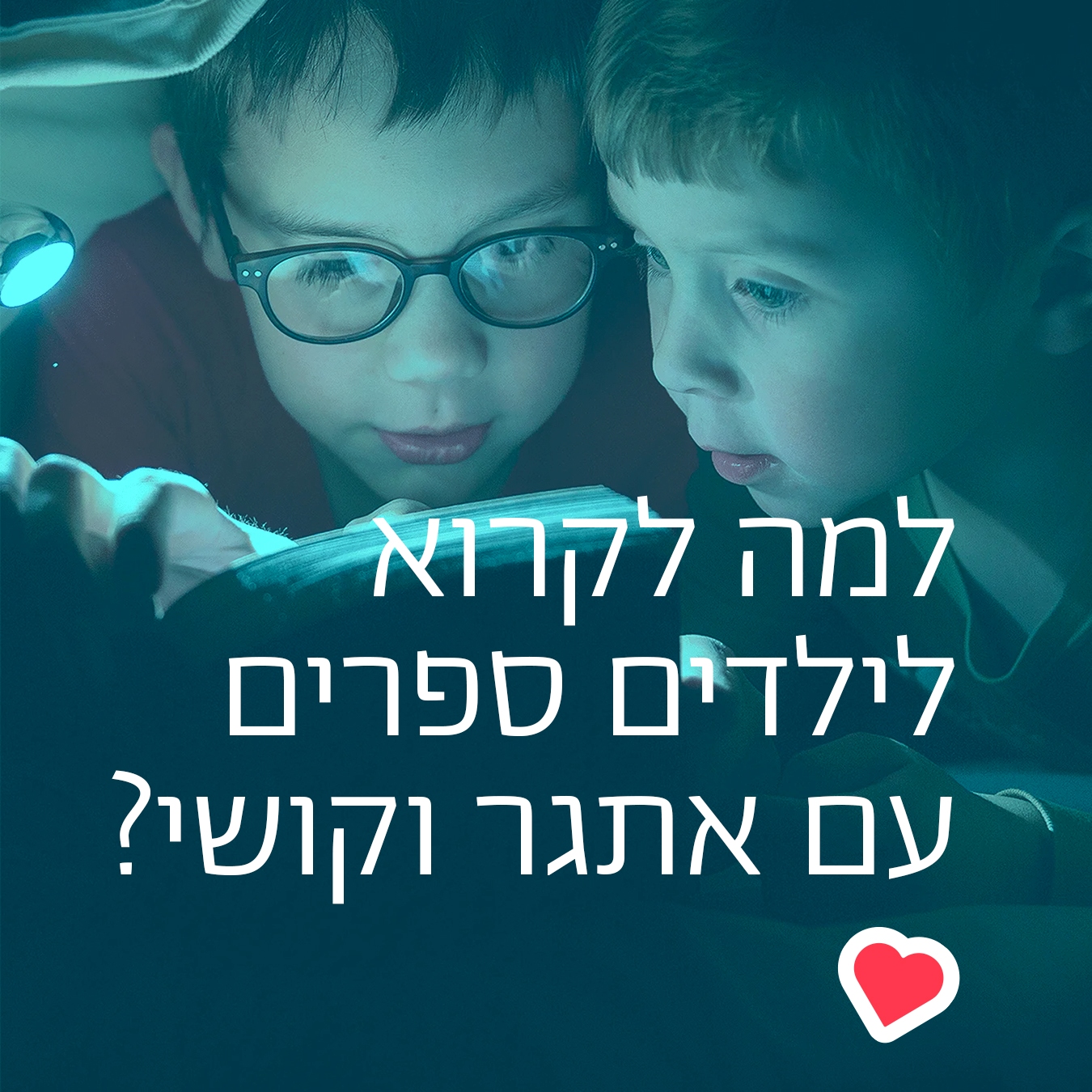
Suggested Family Activities
- It all began with a misunderstanding and hurt feelings, and then “Now you’ll see what’s going to happen!” After reading the story together you may discuss intentions and misunderstandings among friends, and share experiences with one another.
- Like Kramer the cat, we all feel big at times and small at other times. You can ask your children when they feel big and when they feel small, and talk about the advantages and disadvantages of each.
- “Scratches, bites, jumps and somersaults” – that’s how the author Meir Shalev describes cat games. You can flip through the book, select one of the animals and act out that animal’s movements.
- Kramer is very fearful of the large animals he meets in the forest. This can be an opportunity to discuss with your children caution and safety rules, fears, and ways to overcome fear.
- Kramer’s friends teach him an important lesson in friendship: A good friend is one who knows how to forgive and to apologize. You can look for the illustration where Kramer’s friends meet him in the forest, and note the expressions on their faces.
- Yossi Abulafia’s rich illustrations depict an array of animals – some domestic, others wild. You can look at the illustrations with your child and see how many of the animals you recognize. Does your child know all the animals’ names? Which of them can be found near your house? You can go for a hike. Which animals, large and small, do you meet on the way?
- You can act out the story using stuffed animals and toys. Allow your children to select the dolls to represent Kramer, his friends from the garden and the forest animals. The animals can be happy, be afraid, play together and quarrel – and, in the end, make amends and apologize.
- After reading the book together you can look at the picture of Kramer sleeping in his bed, choose a doll or stuffed animal and guide it to sleep by reading a “Sifriyat Pijama”
bedtime story.
Family Activities:
- If you carefully follow the text and illustrations of the story, you will surely note the different paths taken by the words and the pictures. Read the story again with your child. Each time you arrive at the sentence “Meanwhile, Hannah Banana rushed on her way…” ask your children to describe what they see in the picture. Is Hannah Banana really rushing? What does she do and whom does she meet along the way to Granny’s house?
- Did you notice the cat who accompanies Hannah Banana on her way to Granny’s house? You can ask your child to point out the cat on each page, and ask them how they think Granny will greet him when he arrives at her house.
- You can play the finger game “One Little Piggy” with your child. According to the story, who “had none” at the end of the rhyme?
- Hannah Banana’s Granny Cooked Porridge is actually two stories that happen at the same time. You can act out the stories with your child. First ask your child to be Hannah Banana on her way to grandmother’s house, while you pretend to be Granny. Then you can change roles. If other family members or friends are with you, they can be included in the skit as well and take on the roles of the neighbors.
- “To each his own”: At the end of the story we discover that Hannah Banana doesn’t even like porridge! You can ask your children if they believe this, and discuss which foods they like in particular and what they don’t really like.
- You can explain to your children that “Hannah Banana” is a nickname. Do your children have a nickname or a special name that only some people use when addressing them? If so, do they like their nickname?
Here is a simple recipe for delicious, sweet porridge:
Ingredients: 1 cup water, 2 cups milk, 3-4 tablespoons semolina, 3 tablespoons sugar, cinnamon, butter
Preparation: Cook the water, milk, semolina and sugar over a low flame, stirring constantly. Bring to a boil. The porridge is ready when the mixture is boiling and the semolina is cooked. Sprinkle with cinnamon and add a dab of butter. Bon Appetite!
Family Activities:
- The adults in the story are doubtful that the carrot will grow. You can discuss this with your children and share your own experiences. You may ask: Why do the adults had trouble believing that the carrot would grow? When you read the story, did your children think the carrot would grow? Did you ever have someone not believe you? How do you feel when others doubt things of which you are certain?
- The boy in the story does not speak, and we can only imagine what he is thinking and feeling as the others express their skepticism. If the boy could talk, how do you think he would respond? Together with your child you can select dolls to represent the boy, his parents and his brother. As you re-read the story, use the dolls to create a dialogue between the boy and his
- At the end of the story, the boy transports the carrot in a wheelbarrow. What do you think happens next? Where is he taking the carrot? How do the others respond when they see the giant carrot, and what does the boy do with it?
- The carrot grows under the ground, and not on the shelves of the grocery store! You can visit the supermarket or neighborhood grocery and take note of the various fruits and vegetables. What grows from a seed, like the carrot? What grows under the soil, and what blossoms on a tree? Which foods can be prepared from each fruit and vegetable, and what do we like in particular?
- Crockett Johnson’s illustrations depict the story that occurs above ground. You can suggest to your children that they draw a parallel story of the carrot, page after page, reflecting the process under the soil. In the end you will have two booklets illustrating the story “The Carrot Seed”: one of the boy and his family, and the other – the story of the
- There are many delicious foods that can be prepared with carrots: carrot juice, carrot soup, carrot salad, carrot bread and more! Here is an easy recipe for sweet and delicious carrot salad: Ask your children to help peel and grate a few carrots into a bowl. Add a bit of lemon juice, sugar and a handful of raisins and mix together. You can serve your carrot salad to the whole family. Bon Appetite!
- “The Carrot Seed” demonstrates the great amount of patience and perseverance needed to grow vegetables. These traits are necessary to achieve many goals in life. You can share a personal story with your child of something you achieved with great effort and after a long wait, and tell them about the sense of satisfaction this
Suggested Family Activities
- Do your children have a favorite doll or stuffed animal? After reading together the story about Maya and her kangaroo, you can discuss the special feelings we have toward objects, toys or stuffed
- You can take a picture of your children holding their stuffed animal, print out the photograph and decorate a frame for it. The framed photograph will serve as a memento in future years and will remind your children of the special relationship they had with the doll when they were
- The illustrations that accompany the story hint at changes in the blue kangaroo’s feelings, as more and more stuffed animals join him in Maya’s bed. You can flip through the pictures with your child and ask them to describe how they think the kangaroo feels on each
- Each night before going to sleep Maya recites “I love you, Blue Kangaroo”. Even when new dolls and toys are added, she ends her recitation with the same line. How do you get ready for bed? Do you have a special bedtime song, recitation or ceremony?
- You might want to discuss with your children why they think Maya agreed to share so many toys with her baby brother, but woulddn’t give away the blue kangaroo. Do your children have toys or dolls that are easier to share, and others they refuse to part with?
- Together with your children you can look for the pictures of Maya’s baby brother. You can tell the story through his eyes, and try to think how he feels as the story
- Maya and the blue kangaroo have a special relationship, which is not weakened as new dolls are added. Do you and your children have special relationships with family or friends? You can talk about this with your children, and reinforce their confidence in your feelings toward them.
- The gifts that Maya receives throughout the story are new and shiny, while the old kangaroo is old and worn. Sometimes we too prefer things that are new and shiny, and it can be hard to decide what to give up. The story can lead into a family discussion on loyalty, weighing considerations and making difficult
- The blue kangaroo feels crowded in Maya’s bed, but many times it is warm and cozy to lie together in bed! You can cuddle up and read books together in bed, and following this story, add more and more dolls and stuffed animals. You can also sing together fun songs like “Shovavim Bamita” by Datia Ben-Dor:
Family Activities:
1. Noa is very attached to the old doll that her grandmother made for her, but also likes new dolls and toys. You can ask your children which dolls and toys they like in particular, and remind them who gave them the gifts and under which circumstances.
2. Mr. Minasa tried to get rid of his old shoes when he arrived in the new country. You can play an imaginary game with your children: If you were leaving for a faraway place, what would you take with you and what would you leave behind?
3. Like Grandmother Agarnesh, you too can craft a hand-made doll for your child, using old socks and clothing. You are invited to send us a photograph of the doll, which we will happily post on the Sifriyat Pijama website!
4. Mr. Minasa arrived in the new country from Ethiopia. Where did your family originate? This is an opportunity to share your personal immigrant story with your children, and show them photographs of the old country. Perhaps you too have old bjects or clothing that you can search for together.
5. Mr. Minasa’s neighbors recognized his old shoes and returned them to him. Did you ever find something and return it to its owner? Was the owner happy to receive the lost object?
6. You can act out the story with your children. Each one in turn takes on the role of Mr. Minasa and looks for places around the house to hide the shoes. The other player finds them and declares, “Oh, here are Mr. Minasa’s old shoes!”
Family Activities:
- Ruthi proclaims that “there’s no other coat like this in the world!” You may ask your children what it is that makes Grandmother’s coat so special. Ask them to describe the coat in their own words. Don’t forget to note the soft material and the surprise-laden pockets! Do you have special clothes or objects that help you feel better? This is an opportunity to remind children of blankets, stuffed animals or a special cloth that help them feel calm in times of distress.
- Dressing up in costume is a wonderful way to foster one’s imagination. You can provide old clothes, hats and other props to encourage your children’s make-believe play. You may dress up in a big old coat and, adding a few other relevant props, can act out the story together.
- Many of us have childhood memories connected to touch. Do you too have a distant recollection of a special piece of clothing? You can share this childhood memory with your child and tell them about the special connection you had with the clothing, or with your grandparents, aunts or uncles.
- The “It’s Like” game: The author Miriam Roth compares the feel of Grandmother’s coat with the fur of a cat. You can make up a word game to play with your children: Place objects made from different materials – e.g., metal, plastic, cloth, etc. – into a large bag. One by one, each player removes an object from the bag and describes the object declaring “It’s soft like…”, “It’s cold like…”, “It’s coarse like…”
- Ask your child to show you the picture depicting Ruthi sick in bed. You can ask them how they feel when they’re sick. What helps us feel better? Do you have any special “family remedies” that were passed down from generation to generation? You can ask a grandparent, aunt or uncle what they recommend to overcome a sad mood or a mild cold.
-
If your child has a grandparent, aunt or adult friend who lives nearby, reading the story together could be a special treat for both of them, and lead to closer relations between the generations.
Miriam Roth
Miriam Roth (1910-2005) was a well-known children’s author and educator. In 1998 she won the UNICEF Smile Award for her book “A Tale of Five Balloons”, and in 2002 was awarded the prestigious Bialik award for literature. Roth’s books include Israeli children’s classics such as “Tiras Cham”, “Maaseh shel Hamisha Balonim”, and “Habayit shel Yael”.
Family Activities:
Open your eyes and look around… Good people can be found everywhere, but we don’t always notice them. You can discuss with your children who the “good people” are in your lives and what makes them good. You might want to prepare a booklet and ask your children to draw the good people who surround you: family, friends, neighbors, teachers etc.
Invite your children to take a close look at Yossi Abulafiya’s illustrations of the song. How many “good people” can you find on each page? What are they doing?
Are you acquainted with other songs by Naomi Shemer? Do your children know them as well? This is an opportunity for you to teach your children a new song. Together you can prepare a song book of songs you love, and organize a sing-along with family and friends.
You can create your own special rose-colored binoculars, through which the world looks positive and rosy. Take two empty toilet paper rolls,you’re your child to decorate them and attach them to one another with glue. At one end of the rolls attach pink-colored cellophane wrap, and take a good look around you!
Does your child know the way to kindergarten? Together you can draw a map of the road from your home to the classroom, adding images of “good people” along the way.
You and your children can take a walk in the neighborhood and be “good people” for others! Before setting out, try to think of things good people would do (for example, watering a dried-up plant, feeding crumbs to hungry birds, greeting people with a smile and a warm “shalom!”…)
Who are the “good people” you met today? You may want to initiate a family bedtime tradition of reflecting and remembering all the good people and things you encountered during the day. Be sure to mention ways in which you were “good people” for others as well!
A Good Eye
2000 years ago Rabbi Yochanan Ben Zakkai asked his pupils to suggest what aids a person in walking the proper, righteous path through life. His pupils looked around and saw good and righteous people of different sorts:
[Rabbi Yochanan] said to them: Go and see which is the best trait for a person to acquire. Said Rabbi Eliezer: A good eye. Said Rabbi Joshua: A good friend. Said Rabbi Yossei: A good neighbor. Said Rabbi Shimon: To see what is born [out of ones actions]. Said Rabbi Elazar: A good heart.
Rabbi Eliezer said that the good path is in the eye of the beholder. One who has a good eye sees the good and righteous in others, and acts so himself. Rabbi Joshua and Rabbi Yossei stressed the importance of those who share our path – friends and neighbors. Rabbi Shimon recommended examining one’s actions in light of their future consequences, and Rabbi Elazar said that it all begins with what is in one’s heart.
Naomi Shemer suggests that we open our eyes and see those who share the righteous path, in order to learn from them so that we too can be “good people” on the positive, righteous and pleasant path of life.
Suggested Family Activities
- Look through the illustrations accompanying the story, and note the many things Akiva the shepherd knew before he learned to read and write. Then you can remind your children of the many things they know and can do.
- Many Jewish leaders started out as shepherds. You can discuss with your children the tasks involved in shepherding and consider the attributes that characterize a good shepherd. You might ask your child what it is in the essence of the shepherd’s work that helped Rabbi Akiva become a wise teacher and great Jewish leader.
- “One who is shy does not learn” (Avot 2,5): When Akiva saw the signs on the walls of the well and did not know how they were created, he went to the beit midrash (Jewish study hall) for answers. Where do you and your children seek answers to your questions? Are there things that your children know and you don’t? Don’t be shy – ask them!
- You can prepare a clay or Play-Do model of the well with your children. Using a knife or toothpick, you can make signs in the sides of the well – just like in the story.
- Many young children have heard of Rabbi Akiva and his wife Rachel from stories and songs. You can share other tales of Rabbi Akiva with each other and, if you know the tune, sing together “Rabbi Akiva said: Love your fellow as yourself”.
Who was Rabbi Akiva?
Rabbi Akiva, one of the most important sages in Jewish tradition, lived in the land of Israel between the years 17-137 CE. He played a role in editing the Mishna and in designing Halacha, and was the spiritual leader of the Bar-Kochva uprising against the Romans. Many stories and tales were written about Rabbi Akiva, and well-known sayings are attributed to him. One of his more famous sayings is “Rabbi Akiva said: ‘Love your fellow as yourself’: This is a great principle of the Torah” (Breishit Rabba 24,8). According to tradition, Rabbi Akiva was the son of converts and did not learn Torah until he was an adult. The story of his life, like that of other leaders and wise people in Jewish tradition, emphasizes that the Torah is accessible to everyone, even those who didn’t have the opportunity to study when they were young.
The source of the tale about Rabbi Akiva can be found in Avot D’Rabbi Natan 6,2.
להציג לילדים את כריכת הספר
כדאי להציג לילדים את כריכת הספר ולשאול אותם: איזו חיה רואים בתמונה – ברווז או ארנב? האם כולם ראו אותה חיה? אפשר לבקש מהילדים לנסות להסביר לחבריהם כיצד לזהות את הברווז או הארנב. האם הצליחו לשכנע את חבריהם? אילו הייתם צריכים להכריע כקבוצה, מה הייתם קובעים: האם זה ברווז או ארנב? האם ההכרעה הקבוצתית חשובה או משמעותית?
אפשר לילדים לקרוא את הספר יחד בזוגות
כדאי לאפשר לילדים לקרוא את הספר יחד בזוגות, ללא התיווך שלך, ולהשתעשע בו. האם הספר הצחיק את הילדים? האם הוא הצחיק אותך?
מה מסתתר בקשקוש
האם אפשר לראות משהו שאחרים אינם רואים, או שאינם מפרשים כמוך? אפשר לשחק “מה מסתתר בקשקוש”: הילדים מתחלקים לזוגות. כל אחד בתורו משרבט ציור מופשט, ועל המשתתף השני לזהות בתוך התמונה דמות או עצם מוּכּרים, להוסיף פרטים חסרים ולצבוע אותם בצבע.
שיעור באיור - ברוז וארנב!
ברוז? ארנב? למדו לצייר גם ברוז וגם ארנב – יחד עם נעם נדב!
איך לצייר ברוז:
איך לצייר ארנב:
מגוון שיעורים באיור עם נעם נדב בעמוד היוטיוב שלנו, לצפייה לחצו >>
איך משכנעים מישהו להסתכל על המציאות דרך העיניים שלנו?
בסוף הסיפור מתחלפות נקודות המבט. מי שקודם לכן ראה ברווז מאמין עכשיו שזהו ארנב, ולהפך. אפשר לשוחח עם הילדים, להזכיר להם חוויות משותפות ולשתף אותך בניסיון החיים שלכם: האם פעם שיניתם את דעתכם בעקבות זווית הראייה של האחר? איך משכנעים מישהו להסתכל על המציאות דרך העיניים שלנו?
ליצור צלליות ידיים בצורה של ארנב (או ברווז!)
אפשר ליצור צלליות ידיים בצורה של ארנב (או ברווז!): מחשיכים את החדר ומאירים קיר אחד בפנס או במנורת קריאה חזקה. ממקמים את הידיים ליד מקור האור ויוצרים באמצעות האצבעות צורה של חיה. האם ניתן לזהות את החיה לפי הצלליות שעל הקיר? האם זהו ארנב או ברווז? בהמשך תוכלו ליצור חיות נוספות בעזרת כפות הידיים.
לצאת החוצה ולהביט בשמיים: מה רואים בעננים?
בכריכה הפנימית של הספר מצוירים עננים. האם הילדים מזהים צורה של חיה בתוך העננים? אפשר לצאת החוצה ולהביט בשמיים: מה רואים בעננים?
איך מרגישים כשהאחר אינו מצליח (או אינו מוכן) לראות את מה שאנחנו רואים?
איך מרגישים כשהאחר אינו מצליח (או אינו מוכן) לראות את מה שאנחנו רואים? תוכלו להציג לילדים תמונות של תעתועי ראייה או אשליות אופטיות, ולבקש מהם לספר מה הם רואים. שתי דוגמאות נודעות לתמונות “מבלבלות” הן תמונת האישה הזקנה והעלמה, והתמונה של כוס היין ושני הפרצופים.
תעתועי ראייה של חיות
הידעתם? סיפור הילדים “ברווז! ארנב!” מבוסס על תעתוע ראייה שצייר פסיכולוג אמריקני בשם ג’וסף ג’סטרו ב- 1899, ופרסם במאמר מדעי על הקשר בין המוח לבין ראייה. מאז פורסמו תמונות נוספות של ברווז-ארנב, כמו זו, וכן תעתועי ראייה של חיות אחרות כמו חמור-כלב ים, וברבור-סנאי .
איזו חיה ראיתם – ברווז או ארנב?
כשקראתם לראשונה את הספר, איזו חיה ראיתם – ברווז או ארנב? האם גם ילדיכם ראו את הדברים באותו אופן? האם הצלחתם בקלות לראות בכל פעם את בעל החיים באופן אחר? אילו הייתם צריכים להכריע, מה הייתם קובעים: האם זה ברווז או ארנב?
האם אפשר לראות משהו שאחרים אינם רואים, או שאינם מפרשים כמוך?
האם אפשר לראות משהו שאחרים אינם רואים, או שאינם מפרשים כמוך? אפשר לשחק “מה מסתתר בקשקוש”: כל אחד בתורו מצייר ציור מופשט, ועל המשתתף השני לזהות בתוך התמונה דמות או עצם מוּכּרים, להוסיף פרטים חסרים ולצבוע אותם בצבע.
להציג לילדיכם תמונות של אשליות אופטיות
איך מרגישים כשהאחר אינו מצליח (או אינו מוכן) לראות את מה שאנחנו רואים? תוכלו להציג לילדיכם תמונות של אשליות אופטיות ולבקש מהם לספר מה הם רואים. שתי דוגמאות נודעות לתמונות “מבלבלות” הן תמונת האישה הזקנה והעלמה, והתמונה של כוס היין ושני הפרצופים (ניתן למוצאן באינטרנט אם תחפשו “תעתועי ראיה”) – מה אתם רואים כשאתם מביטים בתמונות?
האם פעם שיניתם את דעתכם בעקבות זווית הראייה של האחר?
בסוף הסיפור מתחלפות נקודות המבט. מי שקודם לכן ראה ברווז מאמין עכשיו שזהו ארנב, ולהפך. האם פעם שיניתם את דעתכם בעקבות זווית הראייה של האחר? איך משכנעים מישהו להסתכל על המציאות דרך העיניים שלנו?
ליצור צלליות ידיים בצורה של ארנב (או ברווז!)
אפשר ליצור צלליות ידיים בצורה של ארנב (או ברווז!): מחשיכים את החדר ומאירים קיר אחד בפנס או במנורת קריאה חזקה. ממקמים את הידיים ליד מקור האור ויוצרים באמצעות האצבעות צורה של חיה. האם ניתן לזהות את החיה לפי הצלליות שעל הקיר? האם זהו ארנב או ברווז? בהמשך תוכלו ליצור חיות נוספות בעזרת כפות הידיים.
מה רואים בעננים?
בכריכה הפנימית של הספר מצוירים עננים. האם זיהיתם צורה של חיה בתוך העננים? אפשר לצאת החוצה ולהביט בשמיים: מה רואים בעננים?
Activities You Can Do at Home:
- “Who is respected? Those who respect their fellow creatures” (Pirkei Avot 4:1).The wedding guests learn an important lesson from Marco about treating people with respect. In keeping with the saying “Don’t judge a book by its cover,” you could talk with your children about external and internal qualities. Together, you might discuss traits and characteristics of the different members of your family, emphasizing the importance of treating every person with respect regardless of how he or she looks or is dressed.
- You might flip through the book together and compare the illustrations where Marco is simply dressed to those where he is wearing his elegant silk coat. Does “Marco remain Marco”?
- While reading the story, you could linger over the page where Marco “feeds” his coat food from the wedding feast. Does this illustration make your children laugh? Do you find it funny? You could ask your children why they think Marco decided to put food in his coat pockets.
- The story describes how the Jews of North Africa used to celebrate joyful life cycle occasions. You could talk with your children about weddings and other celebrations in your community today. How do you dress for them? What foods do you eat? Are there any special songs and dances associated with these events? Have your children ever taken part in a wedding or other life cycle celebration? See if you can find photographs from past happy occasions, and recall details from a wedding or other celebration in which you took part.
- You could dramatize the tale using puppets or stuffed animals, or put on a skit based on the story. Make sure to find appropriate costumes: some ragged outfits, dark make-up, fancy wedding clothes, an elegant coat, and so on.
- “When you eat the labor of your hands, you will be happy and it will be well with you” (Psalm 128:2). Marco works as a coal-seller—a job that barely paid enough to eat, and one that no longer exists. You could tell your children about coal, how people used to heat their homes with it, and how the job of coal-seller was regarded in society. Then you can ask your children what jobs or professions they know. If you like, you could tell them about the work that you do. What do you love about your work? What gives you satisfaction?
Family Activities
Colored words are woven into the text of the story. Show your child the colored words and try to guess why the designer chose these colors. Who do the pink words describe? Which colors depict the words for “cake” and “strawberries”? Ask your child to help “read” the story with you by joining in with the colored words that they can identify.
“How good and pleasant it is for brethren to dwell together” – Sometimes, sitting alongside strangers (on the bus, at the playground, on line at the supermarket) can turn into a pleasant example of “brethren dwelling together”. You can think back to situations when you met new people in such a setting, who helped you pass the time. For instance, perhaps someone helped you lower the stroller down a flight of stairs or offered your child a snack while waiting for the doctor. Perhaps there were children who shared the swings at the playground. All these help illustrate the positive side of “brethren dwelling together”.
The two grandmothers both love Avigail. You might suggest that your child draw a picture of Avigail, surrounded by all those who love her. They can then draw a picture of themselves and all those who love them!
Tsila and Gila’s car goes through tunnels and over bridges. Together with your child, you can create a make-believe track for the car within your home, “set out for your journey” and stop to pick up passengers along the side of the road who need help. Remember: In Tsila and Gila’s car, only the cake is not fastened in with a seat belt. Be sure all your passengers are strapped in when riding in the car!
Does your child like to travel? Ask your child about journeys he or she has taken, real or imagined: Where did they go, who joined them, what happened along the way? We invite you to send your stories and drawings to the Sifriyat Pijama website: www.pjisrael.org.
Did you ever set out for a journey, get lost, and find yourselves in a new and surprising place? This is a good opportunity to tell your children about your adventure. Be sure to describe about any disappointment or frustration your felt when you lost your way, and then the positive experience you had at the end.
“This too is for the best”: A sudden halt brings an end to the comfortable trip. All the drivers and passengers are disappointed with the traffic jam. If you go through the book, you can discover unpleasant situations that turned into happy occurrences.
Not everyone likes changes in plans. Do you have a special way to help yourselves and your child to accept changes? “Chutes and Ladders” is a board game in which surprises can cause set-backs (when going down a chute), but also be pleasing (when climbing up a ladder). You can create your own game “On the way to the birthday party”, along the lines of Chutes and Ladders. The chutes will appear whenever there is a delay in the journey, and the ladders will represent the happy surprises on the way.
One way to provide encouragement when things doing go as expected is to make a “This Too Is For The Best” sign. You can write the proverb and invite your child to decorate it. Be sure to hang the sign in a visible spot in the house, to remind you that even unexpected things can turn out for the best.
The cute puppy found a welcoming home, and Avigail received a perky gift for her birthday! You can make finger puppets of Avigail and the dog: Draw or copy the characters from the book onto a piece of paper, and attach them to your fingers by stapling together the edges of the reverse side of the paper. The puppy can share his adventures in the car with Avigail, and she can tell him how she passed the time while waiting for her grandmothers to arrive.
All’s well that ends well: The granddaughter and her two grandmothers celebrate her birthday with tea and cake (and the puppy enjoys himself too, in his own way). You too can make a small tea party and invite over friends who want to share in experiencing “how good and pleasant it is for brethren to dwell together”. Be sure to sing together in Hebrew “Hineh ma tov u-ma na’im shevet achim gam yachad”.
Leah Goldberg
Leah Goldberg (1911-1970), born in Kovno, Lithuania, was a poet, author, and translator. She studied at the universities of Berlin and Bonn, and received a PhD in Semitic Linguistics at the age of 22. Two years later (in 1935), she made aliyah to Israel and established herself as a renowned poet. She edited and wrote children books, including Where Is Pluto?, Apartment for Rent, and many others which have become classics of Israeli literature. Goldberg also headed the Comparative Literature Department at the Hebrew University of Jerusalem. In 1970, she was awarded the Israel Prize for literature, but unfortunately passed away two months before the prize ceremony. Her mother accepted the prize in her name.
Family Activity:
- Gad feels that there is a “naughty boy” inside of him that is making trouble and irritating him. Discuss together: Is there really a “naughty boy” inside of him?
Who swears at the auntie and pushes Yocheved: Gad, the “naughty boy”, or both of them together? Where is the “naughty boy” when Gad is not angry? What do you think?
- The illustrator Danny Kerman chose to represent the “naughty boy” by drawing a small shadow of Look at them both (Gad and the “naughty boy”). What is the “naughty boy” doing when someone is angry with Gad? Choose one of the illustrations and make up a “shadow conversation” between two characters, using your hands: Shine a bright light on the wall, using a lamp or flashlight. One of you will make shadows with your hands as if you were the “naughty boy”, and the other will respond as if they were Gad.
- The adults are upset with Gad: Father says he is acting like a baby, Yocheved’s mother calls him a “savage”, and Grandmother is so angry her nose turns green. What do you think about the behavior of the adults who talk to Gad?
- Discuss with your child an incident when you could not overcome your anger. What can one do in order to prevent this? If we are angry, how can we deal with the consequences of this feeling?
- Gad says: “I have tried everything… in order to make the ‘naughty boy’ go ” There are seven illustrations in the book that describe Gad’s attempts to deal with the “naughty boy”. Look at these illustrations and try to identify how he is dealing with the “naughty boy”.
- Gad asks: “What shall I do with him, with the ‘naughty boy’?” Like Gad, we all have urges and habits that we are not proud Choose a habit that you would like to overcome and in this way become a hero or heroine! Make a “Badge of Bravery” to award the heroes (e.g.: a medal, crown, sticker, etc.) and award it to the children when they overcome their urges and behave maturely.
- The “naughty boy” is often troublesome, but he also has some good characteristics: courage, independence and a strong will. Surprisingly, he even knows how to dance! Inside the book cover there are a series of illustrations of the “naughty boy”. When one looks at them in sequence, it seems as though the “naughty boy” turns his anger into dancing. You’re welcome to dance with him. Choose a few moves for the children to do and create a little dance. You can sing or drum to accompany the dancing.
Family activities:
Leaf through the pages with your child and look for instances of giving in the book. Who gives openly and who gives in secret? The title of the Hebrew version of the story is “The Hidden Circle”. Why do you think the author chose this title?
Draw your child’s attention to the items on each page that are filled in with color. Why do you think the illustrator chose to highlight these pictures?
The facial expressions depicted in the illustrations convey the characters’ emotions (e.g. – the face of the child watching the old man sleeping, or the face of the old man eating the muffin). How can we “read” others’ feelings by observing their facial expressions?
You can play the game “Identify the Feeling” with your child. Make an expression that conveys a certain emotion and let your child guess which emotion that is. Then change roles and try guessing the feelings your child is conveying.
Look at the illustration of the old man crumbling a bit of his muffin for the birds. In the Talmud the rabbinical sages say: “Even a poor man who himself survives on charity should give charity” (Gittin, pg. 7b). What is the logic of this commandment?
“A Circle of Friends” is a story about everyday actions that are familiar to all of us. In the book of Deuteronomy (chapter 30, verses 10-14) it is written: “This mitzvah… is not in the heavens… or across the ocean… Rather (it) is very, very close to you, upon your lips and in your heart to perform it”.
In other words, good deeds are within all of our reach. Even young children can perform mitzvot, or good deeds. Take the time to think together with your children about some of the good deeds they have done (and things they would like others to do for them), for example: sharing toys with a friend, helping their siblings or friends at school…
At the end of the book the boy receives a surprising gift that brings him joy. Draw a big, yellow sunflower together. On each petal draw a gift that appears in the story. In your opinion, does the cycle of giving end with the blossoming sunflower outside the boy’s window? Invent together with your child a continuation to the story and illustrate it.
Family Activities
- You may want to look through the book and enjoy the lovely illustrations. Can you spot the apple on every page? Some of the objects and animals remain constant, while others change position. Which are constant? Which are in motion?
- Have you noticed that the mouse is smiling almost throughout the book? How do you think it feels while waiting patiently?
- You may want to take puppets or stuffed animals to represent the characters in the story, and act it out to your family and friends.
- We all lose our patience at times, waiting on line at the cashier, or getting stuck in traffic. You may like to share an experience with your child in which you finally made it after having waited for something for a long time. What ‘gift’ did you get at the end of the long wait?
- Many children find it hard to wait for their parent to finish what they are doing, or for their turn to be on the computer. Perhaps you could mark the time left to wait on an analog clock. Children are often more patient when they know when their “patience time” will be over.
How about putting on your aprons and making apple confit?
Ingredients:
1 kg of green apples
1/2 kg of sugar
1 cinnamon stick
1 lemon
Peel the apples with a peeler, take out the cores and dice them. Cook the apples, sugar and cinnamon stick in a pot on a small burner for one hour (you must be patient!). Once cooked, add some squeezed lemon to your confit.
Be-teavon! Bon Appetit!
מסיבת פיג'מות בגן
כדאי לערוך מסיבת פיג’מות בגן, יחד עם ההורים אחרי שעות הגן או עם הילדים בלבד בשעות הבוקר, ולקרוא יחד את הסיפור. אפשר לקשט את הגן עם תפאורה של כוכבים וירח ולהזמין את כולם להתכרבל יחד, ליהנות מהאיורים הרכים שמלווים את הסיפור ולעקוב אחר מסלול החיבוק.
חיבוקים
אילו סוגי חיבוקים מקבלת לוסי מבני המשפחה השונים? בקבוצות קטנות אפשר לשאול את הילדים אם גם הם אוהבים לתת ולקבל חיבוקים, ממי ומתי?
להזמין את הילדים לחשוב על דרכים שונות להביע רגשות
חיבוק הוא דרך ללא מילים להביע אהבה. אפשר להזמין את הילדים לחשוב על דרכים שונות להביע רגשות כשאוהבים (חיבוק, אמירה, ציור, פרח, מתנה…), ולהכין יחד הפתעה להורים בעקבות הסיפור – ביטוי בלתי צפוי של אהבה.
להציע לילדים והורים לצייר את מסלול הפעולות הקבועות לפני שהולכים לישון
מה עושים בני המשפחה של לוסי לקראת שעת השינה? כדאי להיזכר בפעולות של כל אחד מבני המשפחה בסיפור. האם הילדים יכולים לנחש מה עושה אבא של לוסי, ומדוע הוא מרים את הידיים באוויר? מה עושים התאומים כשלוסי ניגשת אליהם? האם משהו משתנה אחרי החיבוק? אפשר להציע לילדים והורים לצייר את מסלול הפעולות הקבועות לפני שהולכים לישון (למשל: צחצוח שיניים, סיפור, חיבוק ונשיקה).
חיית מחמד בבית
הכלבה אנני מתוארת כ”שובבה”. במה מתבטאת השובבות שלה בסיפור? אפשר להמציא דברים “שובבים” נוספים שהיא עושה. האם גם לילדי הגן יש חיית מחמד בבית? אפשר להזמין אותם להביא תמונות ולספר עליהם.
האם הבית של לוסי דומה לבתים של ילדי הגן?
כדאי להסתכל על העמוד שבו רודפת לוסי אחרי אנני. נסו לנחש ולדמיין מה יש בכל חדר. האם הבית של לוסי דומה לבתים של ילדי הגן? במה הוא דומה, במה הוא שונה? בהמשך אפשר לבקש מהילדים וההורים לצייר או לצלם תמונה של פְּנים הבית שלהם. מי ישן באיזה חדר? אילו צעצועים וחפצים משותפים לסיפור ולבית שלהם?
כדאי להתכרבל יחד
כדאי להתכרבל יחד, ליהנות מהאיורים הרכים שמלווים את הסיפור ולעקוב אחר מסלול החיבוק. אילו סוגי חיבוקים מקבלת לוסי מבני המשפחה השונים? אפשר לשאול את ילדכם: האם גם החיבוקים במשפחה שלכם שונים זה מזה? האם כולם נעימים? האם ילדכם אוהב לתת ולקבל חיבוקים?
חיבוק הוא דרך ללא מילים להביע אהבה
חיבוק הוא דרך ללא מילים להביע אהבה. אפשר לחשוב יחד על דרכים שונות להביע רגשות כשאוהבים (חיבוק, אמירה, ציור, פרח, מתנה…), ולהפתיע זה את זה בביטוי בלתי צפוי של אהבה.
מה עושים בני המשפחה של לוסי לקראת שעת השינה?
מה עושים בני המשפחה של לוסי לקראת שעת השינה? כדאי להיזכר בפעולות של כל אחד מבני המשפחה בסיפור. האם ילדיכם יכולים לנחש מה עושה אבא של לוסי, ומדוע הוא מרים את הידיים באוויר? מה עושים התאומים כשלוסי ניגשת אליהם? האם משהו משתנה אחרי החיבוק?
שובבים
האם לפני שראיתם את האיור של אנני ניחשתם מי היא? אנני מתוארת כ”שובבה”. במה מתבטאת השובבות שלה בסיפור? אפשר להמציא דברים “שובבים” נוספים שהיא עושה. האם גם לכם יש חיית מחמד? האם גם היא אוהבת חיבוקים? האם לפעמים גם היא מתנהגת בשובבות?
לנחש ולדמיין מה יש בכל חדר
כדאי להסתכל על העמוד שבו רודפת לוסי אחרי אנני. נסו לנחש ולדמיין מה יש בכל חדר. בהמשך אפשר לצייר או לצלם תמונה של פְּנים הבית שלכם. מי ישן באיזה חדר? אילו צעצועים וחפצים משותפים לסיפור ולבית שלכם?
לשוחח על המשפחה שלכם
בתמונה האחרונה בספר רואים את הילדים ואת אנני ישנים, ואת אמא ואבא של לוסי יושבים יחד על הספה עם התינוקת. אפשר לשוחח על המשפחה שלכם. מי הולך לישון קודם? במה עסוקים המבוגרים אחרי שהילדים הולכים לישון?
האם למשפחה שלכם יש פעולות קבועות לפני שהולכים לישון
האם למשפחה שלכם יש פעולות קבועות לפני שהולכים לישון (למשל: צחצוח שיניים, סיפור, חיבוק ונשיקה)? האם תמיד הולכים לישון בלי ויכוחים? בעקבות הסיפור אפשר לשוחח על שעת ההשכבה אצלכם, ואם רוצים – ניתן ליזום מנהג חדש למעבר בין יום ללילה.
Family Activities
- Talk with your children about the two protagonists in the story, Balthazar and Joseph, and compare them. Balthazar has much treasure at home but doesn’t share his wealth with others, whereas the impoverished Joseph is content with his lot in life and opens his home to guests on Shabbat.
You may want to discuss the difference between being “thrifty” and being “stingy” (both terms used in the story), and talk about the kind of generosity that doesn’t depend on having money.You might also discuss the concept of envy, and ask your children why they think Balthazar was so determined that his treasure not fall into Joseph’s hands.
- Using simple props (you could make a precious “diamond” out of a crumpled ball of aluminum foil, and use a towel or scarf for a turban), you could dress up as the characters in the story and put on a family play. You could also use dolls, puppets, and stuffed animals to put on a show about this story.
- Joseph’s daughter goes with him on his trip to the market. Where do you do your shopping – at a farmers’ market, or at the supermarket? A visit to a bustling farmers’ market can be an enjoyable adventure for young children. You could work together to write and illustrate ashopping list for Shabbat, and then look for them in the farmers’ stalls at the market, or at the store.
- After reading the story, you can talk with your children about the way your own family celebrates Shabbat. What does your family do that is special? Who are your guests? You might work with your children to make an album of photos and drawings: “Our Shabbat,” featuring the people and things that make the Sabbath day special in your family.
- Do you, like Joseph and his family, enjoy hosting or being a guest on Shabbat? Many children enjoy taking part in the preparations for entertaining guests into their home. They can make a “Welcome” sign and hang it on the front door, help set the table, help with kitchen chores, or decorate the table with special drawings for each place setting.
- Many sources tell us about the unique character of Shabbat and the preparations for the day. Together, think of all the songs and stories you know about Shabbat (for example, “Who Loves Shabbat” by Ehud Manor; “Chanaleh and the Sabbath Dress” by Yitzchak Demiel; “The Missing Spice” arranged by Devorah Omer; etc.).
- Do you know a different version of the “Joseph Who Treasures Shabbat” story? If you do, you can share it with your children and compare the differing versions.
- The illustrations on the final pages of the book tell us, without words, what happens at the end of the story. Look at the illustrations together, and then use your ownwords to describe what happens after Joseph buys the big fish in honor of Shabbat. Notice the many figures that the illustrator added to the pictures throughout the story, and maybe invent a dialogue between these gossiping bystanders and Joseph.
Have fun reading and talking about this book!
Family Activities
- Have your children “read” the pictures and tell you the story, using the illustrations as their guide. You could pay particular attention to Moses’ facial expressions, and ask your children why they think he didn’t give up on one little kid, despite the fact that he had an entire large flock with plenty of goats?
- Even young children can be “big” and responsible! Help your children recall occasions when they were helpful to other children or small animals. Point out that even small, seemingly unimportant acts of kindness can be very meaningful for those in need; they also serve as a personal example for the entire “flock.” Afterwards, you could draw a picture together depicting one of the times when your children helped others.
- The story of Moses and the kid takes place in a desert. Are your children familiar with desert life – the different kinds of flora and fauna, the wells and oases, etc.? Have you ever visited a desert? Or perhaps you live in a desert area? You might go on a field trip, and compare the climate and scenery on your trip to that in the story.
- Look for the illustration that shows Moses carrying the little kid on his shoulders. Ask your children if they ever felt so tired that they asked to be picked up. Children often ask to be carried, even after they are big enough to walk on their own. You could discuss the times you carried them and the times they were able to walk independently. You could play piggy-back around the house, pretending to be Moses with the little kid.
- Many of our leaders started out as shepherds. Discuss the work that a shepherd does, and the qualities that go into making a shepherd. You could think together about how working as a shepherd helped Moses, when the time came, to lead the Israelites in the wilderness. Try to recall other shepherd-leaders in Jewish tradition (for example, King David and Rabbi Akiva).
- Moses struggles to catch up with the fleet-footed little kid. You could play “catch” together. First, you might play the role of Moses and call to the kid, “Little kid, stop. Little kid, come back!” while your children play the kid that “runs faster and faster.” Then switch roles. Who ran faster – you, or your children?
- What other stories and tales about Moses do your children know? After reading this book, you could tell the story of the Exodus from Egypt and the Israelites’ wanderings in the wilderness, and talk about the figure of Moses.
להמחיז יחד את הסיפור
אתם יכולים להמחיז יחד את הסיפור. כדאי לנסות לדמיין את ההמולה, את המראות ואת ההתרחשויות בסביבה.
להתבונן לבד באיורים של יוסי אבולעפיה
כדאי לאפשר לילדים להתבונן לבד באיורים של יוסי אבולעפיה. האם משהו הצחיק אותם באיורים? האם ילדי הגן מזהים את כל הדברים שמצאו האנשים באיורים? אפשר לחפש באיורים חפצים בלתי מוכרים (למשל: מנורת שמן, קסת ודיו, נבל), ולשאול את הילדים למה הדברים דומים ולפרש אותם לילדים.
גילויים ארכיאולוגיים
אנחנו לא באמת יודעים איך חיו האנשים לפני אלפי שנים, אך גילויים ארכיאולוגיים מסייעים לנו לדמיין את אורח חייהם. נסו להשוות את האווירה של ירושלים בתקופת בית-המקדש עם המציאות היום (כלי תחבורה, לבוש, אוכל וכדומה).
בהשארת הסיפור
בהשארת הסיפור ולקראת יום ירושלים וחג שבועות, ניתן לקשט את הגן ברוח תקופת בית-המקדש.
להזכיר לילדים חפצים שאבדו לילדים
אפשר להזכיר לילדים חפצים שאבדו לילדים, ואם מתאים – לספר להם על חפץ אהוב שפעם אבד לך. האם האבדה נמצאה? איך הרגשתם כשגיליתם שהחפץ חסר, או כשמצאתם אותו? כדאי לאפשר לילדים להעלות רעיונות שיסייעו להם לשמור על חפצים שחשובים להם, ולשתף אותם בדרכים שבהן אנו שומרים על חפצינו.
"משחק הסימנים"
המשנה מנחה את מי שאיבד דבר-מה לתאר אותו על פי סימנים מזהים ייחודיים לו כדי לקבלו חזרה. אפשר לשחק יחד את “משחק הסימנים”: בזמן שאחד הילדים עוזב את החדר, חבריו בוחרים חפץ שנמצא בגן. עם חזרתו לחדר, הילד מנסה לנחש מהו החפץ המוסתר, תוך תיאור החפץ על פי סימנים מזהים.
לשוחח עם הילדים על שמירת חפצים
כדאי לשוחח עם הילדים על שמירת חפצים, וגם ללמד אותם כי גם היום יש מקומות שאליהם מביאים אנשים דברים שמצאו (למשל, למשטרה או למחלקות אבדות ומציאות במקומות ציבוריים). אפשר להציע לילדים והורים לטייל בעיר ולחפש מודעות על חפצים או בעלי חיים שאבדו או נמצאו. האם מצוינים במודעות סימנים מזהים, פרטי קשר, תמונה? תוכלי לבקש מהם לצלם או לתאר את המודעות. בגן הילדים יכולים להכין שלטים לדוגמה, עם תיאורים של חפצים שאבדו או נמצאו.
להרחיב את הסיפור
תוכלו להרחיב את הסיפור ולספר לילדים על אבן הטוען, מעין “אגף מציאות” מתקופת הבית השני. ומה קורה אצלך בגן? האם יש לכם ארגז מציאות או דרך אחרת להשיב חפצים אבודים? אפשר להעתיק את מנהג אבן הטוען לגן, ולקבוע מקום מרכזי בו יוכלו ילדים להכריז על מציאות ולחפש חפצים אבודים.
להציע למשפחות לבקר במוזיאון או באתר ארכיאולוגי
בעקבות הסיפור על פעמון הזהב כדאי להציע למשפחות לבקר במוזיאון או באתר ארכיאולוגי. ואם מתאים, אפשר גם לבקר בירושלים ולהשוות אותה עם תיאורי העיר בסיפור.
להמחיז יחד עם הילדים את הסיפור
בעזרת תחפושות פשוטות אתם יכולים להמחיז יחד עם הילדים את הסיפור. כדאי לנסות לדמיין את ההמולה, את המראות ואת ההתרחשויות בסביבה.
להתבונן באיורים של יוסי אבולעפיה
תוכלו להתבונן באיורים של יוסי אבולעפיה וליהנות מהם יחד. האם משהו הצחיק אתכם באיורים? האם ילדיכם מזהים את כל הדברים שמצאו האנשים באיורים? אפשר לחפש באיורים חפצים בלתי מוכרים (למשל: מנורת שמן, קסת ודיו, נבל), לשאול את הילדים למה הדברים דומים ולפרש אותם לילדיכם.
תקופת בית-המקדש
אנחנו לא באמת יודעים איך חיו האנשים בתקופת בית-המקדש, אך גילויים ארכיאולוגיים מסייעים לנו לדמיין את אורח חייהם. נסו להשוות את האווירה של ירושלים בתקופת בית-המקדש עם המציאות היום (כלי תחבורה, לבוש, אוכל וכדומה).
להיזכר יחד בחפץ אהוב שאבד לילדיכם
נסו להיזכר יחד בחפץ אהוב שאבד לילדיכם ואולי גם לכם. האם האבדה נמצאה? האם אתם זוכרים מה הרגשתם כשגיליתם שהחפץ חסר, או כשמצאתם אותו? כדאי לאפשר לילדים להעלות רעיונות שיסייעו להם לשמור על חפצים שחשובים להם, ולשתף אותם בדרכים שבהן אנו שומרים על חפצינו.
לשחק יחד את "משחק הסימנים"
המשנה מנחה את מי שאיבד דבר-מה לתאר אותו על פי סימנים מזהים ייחודיים לו כדי לקבלו חזרה. אפשר לשחק יחד את “משחק הסימנים”: משתתף אחד עוצם עיניים, והמשתתף האחר בוחר חפץ קטן ומסתיר אותו. הוא מתאר את החפץ על פי סימנים מזהים, ועל המשתתף שעוצם את עיניו לנחש מהו החפץ שהוסתר.
להרחיב את הסיפור
תוכלו להרחיב את הסיפור ולספר לילדים על אבן הטוען, מעין “אגף מציאות” מתקופת הבית השני. אפשר לשוחח עם ילדיכם על שמירת חפצים, וגם ללמד אותם כי גם היום יש מקומות שאליהם מביאים אנשים דברים שמצאו (למשל, למשטרה או למחלקות אבדות ומציאות במקומות ציבוריים).
לבקר במוזיאון או באתר ארכיאולוגי
בעקבות הסיפור על פעמון הזהב כדאי לבקר במוזיאון או באתר ארכיאולוגי. גם אתם יכולים להמציא סיפורים מאחורי הגילויים השונים! אפשר גם לבקר בירושלים ולהשוות אותה עם תיאורי העיר בסיפור.
מסיבת פיג'מות בגן
כדאי לערוך מסיבת פיג’מות בגן, יחד עם ההורים אחרי שעות הגן או עם הילדים בלבד בשעות הבוקר, ולקרוא יחד את הסיפור. אפשר לקשט את הגן עם תפאורה של כוכבים וירח ולהזמין את כולם להתכרבל יחד, ליהנות מהאיורים הרכים שמלווים את הסיפור ולעקוב אחר מסע ההתבגרות של נינה.
לשוחח עם הילדים על ההבדלים בין חלום ומציאות
“עכשיו לילה, אבל נינה חושבת שהיא ערה”. אפשר לשוחח עם הילדים על ההבדלים בין חלום ומציאות: האם גם לכם קרה פעם שלא הייתם בטוחים אם אתם ערים או ישנים? מה יכול לקרות בחלום ולא במציאות? אפשר לתת דרור לדמיון ולצייר ציור שכולו חלום.
להשוות את הסיפור
אפשר להשוות את הסיפור עם להיזכר בספר אחר שחולק השנה, “אמיליה” מאת נעמה בנזימן, שגם הוא מתאר עלילה דמיונית.
חבריה הצעצועים של נינה
חבריה הצעצועים של נינה חושבים שהיא מוכנה למעבר מזחילה להליכה, אבל נינה לא בטוחה בכך. בכל רגע בחייהם הילדים עומדים בפתח הישג חדש (למשל, מעבר לגן חדש או לכיתה א’, רכיבה על אופניים, עצמאות גוברת בפעולות יומיומיות). אפשר לשוחח על כך ולשאול אלו כוחות דרושים כדי לצלוח את המעבר, האם הם חוששים?
להמציא המשך לסיפור
הסיפור מסתיים בצעדים הראשונים של נינה. תוכלו להמציא המשך לסיפור: לאן נינה הולכת? האם היא גם מועדת ונופלת? איך מגיבים בני המשפחה והחברים כשהם רואים את נינה הולכת? הציעו לילדים לצייר ולכתוב יחד עמוד המשך לספר.
לשוחח עם הילדים על דברים ש'בוגרים' עושים ו'קטנים' עדיין לא
אפשר לשוחח עם הילדים על דברים ש’בוגרים’ עושים ו’קטנים’ עדיין לא. אפשר לערוך רשימה של הישגים ויכולות: מה יודעים הילדים לעשות היום שלא יכלו לעשות בתחילת השנה, ומה הם רוצים ללמוד לעשות כשיהיו בוגרים יותר.
להביא לגן תמונות שלהם כתינוקות
בעקבות הסיפור אפשר לבקש מהילדים להביא לגן תמונות שלהם כתינוקות, ולהציג אותן על לוח יחד עם תמונות שלהם מהשנה. כך כולם יכולים להתגאות ולהתרשם ממסע ההתבגרות של הילדים – וגם להיזכר בצעדים ראשוניים שלהם.
להכין יחד עם ילדיהם אלבום של "צעדים ראשונים"
תוכלו להפנות את ההורים לאחת ההצעות בסוף הספר – להכין יחד עם ילדיהם אלבום של “צעדים ראשונים”: צילומים של הילדים כתינוקות בזרועותיהם, ובהמשך זוחלים, הולכים, מבקרים לראשונה בגן… ולהציע להשאיר דפים ריקים להמשך ההתפתחות (המעבר לכיתה א’, לימוד קרוא וכתוב ועוד הרבה!).
סיפורים ושירים לילדים
נורית זרחי כתבה עשרות סיפורים ושירים לילדים. כדאי לחפש אותם ולקרוא אותם יחד, ולערוך פינה בגן של היוצרת ויצירותיה.
לשוחח עם ילדיכם על ההבדלים בין חלום ומציאות
“עכשיו לילה, אבל נינה חושבת שהיא ערה”. אפשר לשוחח עם ילדיכם על ההבדלים בין חלום ומציאות: האם גם לכם קרה פעם שלא הייתם בטוחים אם אתם ערים או ישנים? מה יכול לקרות בחלום ולא במציאות? אפשר לתת דרור לדמיון ולצייר יחד ציור שכולו חלום.
חבריה הצעצועים של נינה
חבריה הצעצועים של נינה חושבים שהיא מוכנה למעבר מזחילה להליכה, אבל נינה לא בטוחה בכך. האם ילדיכם עומדים בפתח הישג חדש? (למשל, מעבר לגן חדש או לכיתה א’, רכיבה על אופניים…) אפשר לשוחח על כך ולשאול אלו כוחות דרושים כדי לצלוח את המעבר, האם הם חוששים?
לצייר ולכתוב יחד עמוד המשך
הסיפור מסתיים בצעדים הראשונים של נינה. תוכלו להמציא המשך לסיפור: לאן נינה הולכת? האם היא גם מועדת ונופלת? איך מגיבים בני המשפחה והחברים כשהם רואים את נינה הולכת? הציעו לילדיכם לצייר ולכתוב יחד עמוד המשך לספר.
לשוחח עם ילדיכם על דברים ש'בוגרים' עושים ו'קטנים' עדיין לא
אפשר לשוחח עם ילדיכם על דברים ש’בוגרים’ עושים ו’קטנים’ עדיין לא. אפשר לערוך רשימה של הישגים ויכולות של ילדיכם: מה הם יודעים לעשות היום שלא יכלו לעשות לפני שנה, ומה הם רוצים ללמוד לעשות כשיהיו בוגרים יותר.
להיזכר בצעדים ראשוניים של ילדיכם
ילדים רבים אוהבים לשמוע סיפורים על ילדותם המוקדמת. לאחר הקריאה אפשר להתכרבל יחד ולהיזכר בצעדים ראשוניים של ילדיכם. האם אתם זוכרים באיזה גיל הם התחילו לזחול, ללכת, אולי לעמוד על רגל אחת בלי ליפול? אפשר לחפש תמונות ישנות ולהכין יחד אלבום של “צעדים ראשונים”: צילומים של ילדיכם כתינוקות בזרועותיכם, ובהמשך זוחלים, הולכים, מבקרים לראשונה בגן… אל תשכחו להשאיר דפים ריקים להמשך ההתפתחות (המעבר לכיתה א’, לימוד קרוא וכתוב ועוד הרבה!)
לצאת ל"טיול לילה"
כמו נינה וחבריה, גם אתם יכולים לצאת ל”טיול לילה”. האם הסביבה המוכרת נראית שונה בלילה? מה אתם רואים, אלו קולות אתם שומעים? כדאי לקחת שמיכה ועותק של הספר, לשכב על הדשא ולהביט בשמים. יחד אפשר לחפש את הירח (האם הוא “ורוד ושוטף את העצים באור כסף בהיר”, כמו בסיפור?), לִספוֹר כוכבים וללחוש סודות.
לילה טוב וקריאה נעימה מספריית פיג’מה!
Family Activities
- Get some paper and cut outseven mouse shapes. Ask your children to color them in, using the same color scheme used for the mice in the story. After they’re done coloring, you can glue the mice to popsicle sticks and ask your children to use these figures to tell the story. Decide together how you are going to fashion the figure of the “creature.”
- We all reach mistaken conclusions at times, based on incomplete information. In order to illustrate this point, look through books, newspapers, or magazines to find a picture of something your children aren’t familiar with. You might even draw such a picture yourself. Then, using opaque paper, cover up most of the image. Are your children able to guess what the picture is just from the part that’s showing? Gradually slide the paper cover off, so that more and more of the picture is revealed. At what point do your children “solve” the puzzle and grasp what the picture depicts?
- The mice in the story guess, based on touch alone, what the new “Something” in the pond is. Together with your children, you can make a Touch Box. Take a large container and put several different objects inside. Ask your children to put one hand into the container and try to identify the objects based on touch alone. Afterwards, let them take a turn putting mystery objects into the container. Can you identify what they put in?
- Play a version of the “Blind Cow” game. Cover one child’s eyes with a bandana, twirl them gently about, and then move to another part of the room. Can they find you again using only voice cues?
- Ask your children why they think the white mouse was able to identify the creature, while the others couldn’t. Did your children notice that the white mouse didn’t come up with any new guesses of her own, instead discovering the truth through the information and guesses supplied by the other mice?
- After reading the story, you could work on a jigsaw puzzle. Choose a challenging puzzle with an age-appropriate number of pieces, and work on it together, with each one taking turns adding a piece. Is there a “method” that you use to solve jigsaw puzzles? How do we figure out which pieces go together, and at what point does the whole picture start to reveal itself?
- The white mouse describes the creature using comparisons: “Stable as a column, flexible as a snake.” You can play a comparisons game with your children, trying to describe familiar items in your home using these phrases: “sounds like…” “looks like…” and “smells like…”.
- The mice in the story cannot see; they are blind. Do you know anyone with a physical handicap? Discuss with your children the various assistive technologies and aids for people with limited vision, hearing, or mobility. Look for examples in your area, such as dedicated parking spaces for the disabled, close captioning and/or sign language on TV programs for the hard of hearing, and Braille signage in elevators for the blind. (Israel’s paper currency has been designed in such a way that those with limited vision can differentiate the various denominations by touch.)
Family Activities
- Stage a family play based on the story. Find simple props at home (sheets and scarves can be used to improvise costumes for Noah and his family; dolls, puppets, and stuffed animals can stand in for the various kinds of animals) and try to imagine the sights, sounds, and smells in the background. Think of ways you could represent the stormy sea, and what might serve as your ark?
- The illustrations that accompany this story add a lot of details that aren’t in the text. Examine the pictures and see if you can identify the different creatures. Can your children name them all? You could divide them up into “family groups” (birds, insects, etc.).What animals do your children know that do not appear in the story? Do your children know how to assign these animals, too, to their “family groups”?
- Noah is concerned about all the creatures on the ark and devotes himself to their care. Talk with your children about the proper way to treat animals, and discuss what “proper care” entails. Take this book with you when you visit a zoo or nature center, and see if you and your children can locate there some of the animals that appear in the book. Some zoos and nature centers let you watch while they feed the animals; others even permit you and your children to participate in the feeding. Do your children know what each type of animal eats, which animals they are allowed to feed, and what food they should be fed? After this visit, you could talk about the differences between domestic pets and wild animals, how we handle animals in captivity, and other related topics.
- “To each his own.” Noah feeds each animal the kind of food that’s appropriate for its species, and he tries very hard to figure out which food will suit the chameleons. Do all the members of your family like to eat the same things? Or do you, like Noah, prepare special foods for different family members, based on individual preferences, allergies, or ages? You could discuss food preferences with your children and see which foods everyone in the family likes, and which are enjoyed only by individual family members.
- Make a model ark out of a shoe box. Ask your children to decorate the model ark as imagination dictates; then put in dolls and either Lego or game pieces to represent Noah, his family, and the various animals.
- This story is based on a Midrash, which in turn was based on the Biblical account of Noah. You could talk about Noah’s character with your children, and retell the story of Noah and the flood. If you know any other Midrashic tales about Noah and the ark, you could share those with your children as well.
Have fun reading and talking about this story!
The Story of Noah and the Chameleon appears in Gemara, Tractate Sanhedrin 108:42
“It is written, ‘After their kinds they went forth from the ark.’ Now, how were you situated?” — He replied. ‘We had much trouble in the ark. The animals which are usually fed by day we fed by day; and those normally fed by night, we fed by night. But my father [Noah] did not know what food the chameleon ate. One day he was sitting and cutting up a pomegranate, when a worm fell out of it, which it [the chameleon] consumed. From then onward, he mashed up bran for it, and when it became wormy, the chameleon devoured it.’
Family Activities
- Look through the book together and examine the unusual illustrations that accompany the text. Notice the various perspectives the illustrator used in creating these pictures. Which pictures show the action from above—and which from the side? Talk with your children and ask them why they think the illustrator chose to portray the events on the bridge as she did.
- Sometimes, before we arrive at a good idea, we first have to try (and discard) some not-so-good ideas. Together with your children, go back over the various solutions which the bear and the giant proposed in the story. What are the upsides and downsides of each idea?
- Every child has experienced the clash of wills. Sometimes one family member wants to play music while the other wants quiet, or one wants to read in bed while the other wants to turn out the light and go to sleep. Or a child might be deep in a game when her parents inform her that it’s time to leave the house. … After reading the story with your children, talk about how all of us have differing desires at times, and recall any creative resolutions you and your family may have reached.
- Do you know the song, “The Whole World is One Narrow Bridge”? You can sing it with your children.
- Look around your neighborhood for a low wall, or a playground with ropes, slides, and ladders, and try (carefully!) to cross them at the same time from opposite sides. Do you, too, find yourselves forced to “dance” while hugging each other, just like in the story?
- After reading the story, you could start investigating the different kinds of bridges where you live. You could also build toy bridgesout of blocks, Legos, or other construction toys. Once your bridge is complete, you can use it to stage a little play based on the story, using dolls or Lego characters.
- Do you know other stories that feature a bridge? You can look at home, at your children’s kindergarten, or at your local library for more books and stories about bridges, including “The Bridge” by ShlomoAbass, “The Treasure” by Uri Shulevitz, and many more, and read them with your children.

Family Activities:
- You might ask your children to flip through the pages and “read” the pictures to you in their own words. See if together you can discover all the things the illustrator added to the written text. Did you or your children find anything funny? Were there objects that your children did not recognize? You can ask them to point out the pictures that show the ant and the cricket helping one another. Then you can draw your own picture of the ant and the cricket, as you imagine them. Does your ant wear eyeglasses too?
- Go to the ant… consider her ways and be wise (Proverbs 6,6): Discuss with your children the characteristics of the ant and the cricket in the story. The ant is industrious and plans ahead, while the cricket sings and dances. After reading the story, you can talk about the different traits and tendencies of everyone in your family and note the distinct contribution of each member.
- Who are your neighbors? Do you help one another? After reading the story, you might think of a small act of kindness that you and your children can do for one of your neighbors. How does it make you feel? Have you, like the ant, ever felt that there are times when “it’s even better to give than to receive”?
- Are you acquainted with Aesop’s fable about the ant and the grasshopper? In that version, the ant refuses the grasshopper’s request for food. You can share the fable with your children and compare it with this story. Do you like one version more than the other? Why?
- “What goes around, comes around”: Sometimes children feel that family life is not fair, when they are asked to help out and their siblings are not. You can discuss how the ant responded to the cricket’s repeated requests for ingredients, and ask them how they think she felt after working hard and saving up all week. It is important to point out that in the end, the ant benefited by helping the cricket. This is often the case in families – there are many opportunities to help others and to be helped, each one according to his or her ability and to the circumstances.
- You too can bake a cake for Shabbat! It is fun to work together in the kitchen, and even more fun to share what you made with neighbors and family! You might want to invite some neighbors or friends over to eat your cake and sing songs with you, just like the ant and the cricket in the story.

Recipe for Orange Cake:
Ingredients:
150 grams butter or margarine
1 cup sugar
4 eggs, lightly beaten
1 tsp vanilla
Grated rind of two oranges
1 cup squeezed orange juice
2 1/2 cups flour
3 tsp baking powder
Powdered sugar for decoration
- Beat together the butter and sugar until smooth and fluffy.
- Add the beaten eggs, vanilla and orange rind and continue mixing.
- Add, alternating liquids with solids, the orange juice, flour and baking powder until smooth.
- Pour the batter into a lightly-greased cake pan and bake at low-medium heat (170 degrees) for 35-45 minutes.
- When completely cool, dust the cake with powdered sugar.
Bon appetite and shabbat shalom!
The Game of Thanks
The Game of Thanks: One player begins a sentence with the words, “I want to say thank you for…”, and tells about something good in his or her life. It may be something that has happened to them, or anything – small or big – that he or she has seen, heard, tasted or smelt. The next player completes the sentence as he or she wishes, and so on. The whole family can play this game at dinner or at bed-time.
Gratitude can be expressed through songs!
Gratitude can be expressed through songs! Sing together songs of thanks that you know, for example: Toda (by Uzi Hitman), Elohim Natan Lecha Bematana (composed by Eitan Masori), Hallujah (preformed by Gali Atari.
Many people help us every day
Many people help us every day: The guard at the entrance to the shopping mall, the cashier at the supermarket, housekeepers, etc. Closer to the children’s lives there are neighbors who play with us in the park, our relatives, kindergarten teachers, and more. Sometimes just saying “thank you” is enough, and sometimes people would enjoy receiving a letter or a drawing. Think of a person you would like to thank. Use the letter or a drawing to describe the good times you have had with this person, times when they helped you, or simply the happiness that they bring to your life.
How does one thank God?
How does one thank God? This question bothers Benny. He chooses to thank God in the synagogue, because he believes it is there that most people talk with God. Like Benny, many young children ask big questions: Does God exist? Where does he live? Will he hear me if I speak to him? Discuss your beliefs with your child.
All’s well that ends well!
All’s well that ends well! At the end of the story, Benny is disappointed to discover that it was the poor man, and not God, who ate the bagels. But Grandfather explains that thanks to Benny, “the world has become a better place… and what better thanks than that can God receive?” Discuss with your child the story’s surprising ending and Grandfather’s words. How can we understand the connection between Benny’s good deed and thanking God? Together with your child, try to remember a time when they did a good deed and helped someone. Link this incident to the story, and think about how your child’s good deed also contributed to making the world a better place.
Bagel-shaped Buns Recipe
Bake “if only we had…” bagel buns together.
This is how you play: “Let’s make bagels! If only we had flour… we would have wonderful bagels”. The child brings the flour and you thank him or her happily, then continue by saying: “If only we had sugar…” and so on. Accept every ingredient (flour, sugar, oil, etc.) into your bowl with happiness and thanks. Bake the buns and give them to people you would like to thank or please.
Ingredients:
2 cups of flour 2 spoons of sugar
1 teaspoon of quick-rising yeast 1 teaspoon of salt
1 cup of water 1 ½ spoons of oil
Instructions:
Mix all the ingredients together until a ball of soft dough is formed. If necessary, add a bit of flour. Set the dough aside and let it rise. Once the dough has doubled in volume, divide it into smaller portions, and form bagel-shaped buns. Brush the buns with an egg, and scatter sesame seeds on top. Let the buns rise again. Bake at 190°c degrees, until golden.
Bon Appétit!

Family Activities
- Feathers in the Wind is an ancient story passed from one generation to the next. Do you know any stories that are passed down in your family? You may want to remind each other of one or two such stories.
- Things told “by word of mouth” can sometimes get distorted. “Chinese Whispers”, or “Telephone”, is a game that demonstrates this possibility in a humorous way: players form a circle, and the first player whispers a word in the second player’s ear. The second then whispers what they heard to the third, and so on, until the final player is reached, and asked to repeat the word out loud. Is it the same as the one whispered by the first player?
- The woman in the story learned that it is not easy to mend her ways and take back the words she had said. You may like to discuss the following with your child: In your opinion, why did the woman gossip and spread rumors about the people of her town? Have you ever regretted anything you’d said, even as a joke? Perhaps you would like to discuss such incidents, and the steps you took following them.
- What is the connection between words and feathers? You may want to ask your child: What do you think of the rabbi’s unusual suggestion, given without any direct preaching? Are there any life lessons in your family that are passed on in a creative, humorous fashion?
- The verse “Guard your tongue from evil, and your lips from speaking guile” has a wonderful tune composed by Baruch Hayyat. If you know it, you may enjoy singing it together.
- Shlomo Abbas has written and retold numerous stories. You may want to look for more of his books at home or the local library, and read them together. Which stories did you like?
Enjoy reading and discussing the book together!
Every loaf starts with a single grain
“Every loaf starts with a single grain”: You may want to ask your child how “bread is brought out of the ground”, which forces of nature helped the wheat and other ingredients grow, and what one needs in order to turn wheat into bread.
ask your child to think of five things they like to eat
You could ask your child to think of five things they like to eat. Do they know what they are made of, and how they are prepared? You may want to make a “true meal” together, one that you make on your own from start to finish, including serving and clearing the table. Did you also feel satisfied with your effort and the entire process?
The princess did not want to disappoint her father
The princess did not want to disappoint her father, but hoped she could please him without making much of an effort. She ultimately overcame the difficulties she had encountered, and completed the task well. You may want to discuss the following with your child: Why do you think the king was unhappy with the ready-made loaves of bread brought to him by the princess? What is so special about the “true” loaf of bread? Have you ever been in a situation where you achieved something that was important to you after working hard, making a tremendous effort, or repeated attempts? You may want to share this experience and subsequent feelings with your child.
King Baguette looked at his princess'
King Baguette looked at his princess’ hands to determine whether she had brought him the true loaf of bread. You could also look at your child’s hands, and try to guess what they had done today. Children’s hands resemble their parents’, but are also different. You may want to compare your hands, and notice the lines “drawn” on them. Do you have the same lines?
At the end of the story
At the end of the story, the princess learned to appreciate the farmers’ hard work, and their contribution to her life, and even learned to thank them. Together with your child, you could think of the people around you who work hard to make everyone’s lives easier. You may want to try and count all the people who have helped us throughout the day (such as the people who clean the streets, security officers, bus drivers, those in building maintenance, etc.).
playing the "thank you game
You might enjoy playing the “thank you game”. A family member starts by saying “I’d like to thank…” and tells of a good thing another has done for them. It could be anything, great or small, whether ongoing or a single incident. The next begins their sentence the same way, and ends it as they wish, and so on. You could have a thank you round at the dinner table, or before bedtime.
During the journey
During the journey, the princess makes a loaf of bread, as well as a new friend! You may want to discuss the friendship between Fire and the princess together with your child, and compare it to the princess’ relationships with other characters in the book. Perhaps you’d enjoy telling your child about your friends, and share experiences with each other.
A Ciabatta Rolls Recipe
A Ciabatta Rolls Recipe
Ingredients
4 cups of flour
40g of yeast
1 tsp of sugar
1.5 tsp of salt
1.5 cups of lukewarm water
0.25 cup of olive oil
Method
- Stir the yeast in the lukewarm water until it dissolves, add the sugar, and let the mixture rise.
- Place the flour and fermented yeast in a bowl, add the salt and olive oil, and knead into dough.
- Cover and let the dough rise for approximately two hours.
- Form rolls and place on an oven tray covered with parchment paper or corn flour (to keep them from sticking). Let them rise for another thirty minutes.
- Bake in the oven for 25 to 30 minutes, at 220 degrees.
Bon Appétit!

Family Activities
You don’t have to stand on your head to see the world upside down! You may want to think together with your child what makes each of us different than others, even “upside-down” in relation to others (appearance, pastimes, opinions, talents, etc.)? How do your family members’ uniqueness and various perspectives contribute to the family as a whole?
You may like to think about the various characters together, and how each one reacts when they discover Shufon’s difficulty. Perhaps you would enjoy creating a dialog between two owls in different points along the book, and discuss with your child the change undergone by the entire owl community.
Sometimes what one person finds hard, another achieves with ease. In order to experience backward reading, you may want to write a word on a piece of paper and put it against a mirror. Look at the word’s reflection. Can you figure out what it says?
Following the story, you may enjoy having a reading ball at home! Each family member can bring their favorite book to the ball, and explain why they had chosen it. You can read the books together, relish the wordplay, and even feast on special refreshments (such as letter-shaped cookies or food associated with one of the books).
Wordplay:
You could look through the book and search for the blue words. Ask your child what sets them apart from the other words in the book, and why they think they were printed in a different color.
You may want to explain to your child that words that read the same left to right and right to left are called palindromes. You may like to think of other palindromes together (such as mom, dad, eye) and enjoy some wordplay.
Some of the words in the book have different meanings when read backwards. You may want to look for these examples and think of other words that create new words when read backwards.
Family Activity
- Bear’s friends try to cheer him up and make him happy. Each one of them does their best. But how do they do it? Pick one animal and focus on its actions throughout the book. What kind of help does this animal give Bear?
- Have you ever visited a sick friend or relative? Did anyone ever visit you when you were not feeling well? How can we cheer up our kindergarten friends when they are sick?
- The badger gives Bear a herbal tea to drink, made from the medicinal herbs picked by Bear’s friends. You can also make a delicious, warm, herbal tea for your family: Put some herbs like mint (nana), rosemary, lemon verbena, or sage in a teapot. Add four cups of hot water and some honey. Pour a cup of tea for every family member and decorate it with a lemon slice.
- Play “make believe sick”: practice the mitzvah of visiting the sick with your family. Let your child take care of you and help you relax. Tell them what helps you when you’re not feeling well. This is a golden opportunity to remind your children that they have the power to heal others!
- At the end of the story, Bear gets better, and finds out that the friends who helped him recover are all sick! How does Bear “know” to take care of his friends, and how does he manage to take care of so many friends at once? Using stuffed animals or dolls, make a small play showing how Bear takes care of his friends.
“You must exercise great caution concerning your lives” Venishmartem meod lenafshotechem
Sickness is a part of life. We get better thanks to the treatment we receive, as well as thanks to our body, which manages to overcome the illness. In the book of Deuteronomy (Devarim), chapter 4 verse 15, it is written: “You must exercise great caution concerning your lives” (venishmartem meod lenafshotechem). This means that we have the responsibility to take care of our body and maintain a healthy lifestyle.
- How do you take care of your body? Discuss: How do you keep the body clean? What kind of food is healthy? How can we use our body to make it stronger? How do we rest to regain energy?
- Bear’s illness is contagious. Try to think how we can be careful to avoid getting infected (for example: washing our hands, not coming to kindergarten when we are sick). What more can we do?
Family Activities
- Many things cause Isadora’s morning to be gray and gloomy. Look at the illustrations. Search through them with your children and seek out all the things that are difficult for Isadora and that annoy her. You may ask your children: “Does it ever happen to you that you get up ‘on the wrong side of the bed’? What is most difficult in this kind of morning? How do you respond when it happens?”
- Isadora isn’t alone during her day. A small goose accompanies her throughout the entire story! You may want to tell your children about the help that you receive from friends or from family members whenever you are in a bad mood, and suggest that they give thought to who accompanies and helps them to “sweeten” difficult situations.
- Isadora gathers up her gloomy morning and transforms the difficulties into a cake. You, too, can prepare a cake, and sweeten it even more by adding chocolate sprinkles, raisins or candies. You may want to relate to all the sweet additions as symbols of difficult things in the children’s lives, thereby demonstrating the expression “Me’az yatza matok” (Out of the strong came sweetness).
- Isadora is very active. She dances, plucks, bakes, and in the end eats the entire cake! You and your children are invited to make a list of ten ways to overcome a bad mood. You can prepare an illustrated list together and to hang it in a convenient place, as a reminder whenever the need arises.
- Little by little the illustrations in the story change from black to gray to pink. You might explain to the children the special symbolism of various colors. For example, the color pink symbolizes happiness and being positive. It would be fun to prepare some “rose-colored glasses” together from construction paper and rose-colored cellophane. Put them on and see how everything looks different!
- What do you think: Do you and your children think that eating the entire cake was a good idea?
- You and your children may want to invent a different ending for the story. Send your ideas to the Sifriyat Pijama website pj.crunchcart.com, and we’ll post them on the site!
Activities to do at home
- At the start of the story, Grandpa is sad and lonely, but the guests who come to visit him cheer him up. Are your children always happy when their friends visit? Discuss what gives them pleasure and what might be hard for them whenthey entertain guests.
- “A Person’s giving eases his way” – Grandpa’s circle of happiness grows wider and wider as each guest arrives. Even the illustrations in this book bring this point home. Together with your child, you can leaf through the pages of the book and notice how the small circle grows—and how, at the end of the story, it shrinks back down to its original size.
- Turn the story into a play, using toys and dolls. Together with your children, decide which doll will play Grandpa and which dolls will play the guests who come to visit. Tell the story in your own words. You can also continue the story yourselves, imagining what happens after the guests say good-bye to Grandpa and return home.
- Grandpa enjoys a visit from his grandchildren: “For no particular reason, on a weekday, my granddaughter comes over to eat.” Talk with your children about who visits your family, and what you like to do together with them. Do you have set times for such visits, or special customs for entertainingguests? Maybe there’s a special dish you serve to your guests, fancy plates and glasses you use, or a designated room you use to entertain your visitors?
- Many children love to help preparefor entertaining guests. You can work together on hand-made invitations, fold napkins for the table, or draw a welcome sign for the front door.
- Hospitality in Abraham’s tent: After reading the book, you could tell your children the biblical story of Abraham and then suggest they make their own “tent” by spreading a blanket over some chairs. They can sit in the tent and receive their friends as their guests—playing together and serving them a snack they’ve prepared themselves.
- Just like Grandpa in the story, you too can make soup and serve it to your guests. Maybe your children will also want to invite some of their friends who haven’t visited your home before?

Grandpa’s Soup Recipe:
Ingredients:
2 large onions, chopped
3-4 cloves garlic, mashed
4 carrots
3 squash (zucchini or marrow)
Vegetable oil
3 potatoes
2 cups cubed pumpkin
1 bunch of celery
1 bunch of parsley or coriander
Salt, pepper, turmeric
Directions:
- Saute the onion and garlic in a pot with a littleoil on medium low heat until golden.
- Cut the squash, potatoes, carrots, and pumpkin into cubes and add to the pot. Stir.
- Chop the parsley (or coriander) and the celery and add them to the pot. Stir.
- Add seasonings and stir.Continue stirring until all the vegetables have been cooked and softened a bit.
- Add boiling water – twice the volume of the vegetables – and cook till the vegetables are completely soft.
- Taste, adjust seasonings, and serve.
Bon Appetit – Bete’avon!
מבשלים פנקייקים עם רות סירקיס!
צפו במתכון המיוחד לפסח של רות סירקיס לפנקייקים! מתאים לכל ימי השנה!
Family Activities
The story of the three butterflies was first published in 1938, and has since accompanied many generations of Israeli children. Do you know of an earlier version of the book containing other illustrations? You may want to take a look together at Orit Bergman’s illustrations. Have you noticed that the butterflies’ wings are multicolored? You may like to consider why the illustrator chose to paint the butterflies this way.
The three butterflies look out for one another and refuse to be separated. You may want to discuss friendship and mutual obligation together, be it between friends or family members. Perhaps you’d like to share stories about your friends and your child’s, and the things you enjoy doing together. Following the story, you might want to ask your child if they or their friend had ever been prevented from joining in a game, how that made them feel and what they did in response.
The flowers are only willing to allow those who are of a similar color in. You may want to compare the illustrations of the flowers to those of the butterflies. What similarities and differences can you find between them? You may like to ask your child what they think of the flowers’ behavior.
You may also want to act the story out as a family by dressing up in the colors of the flowers and butterflies. You could also create a puppet theater, with characters for the butterflies and flowers, using popsicle sticks and cellophane.
You might enjoy going outside and looking for butterflies and flowers! Just like in the story, flowers and butterflies in nature differ from one another, each having their own particular color and shape. Have you come across a tulip or lily? How many types of butterflies have you found, and what color were they? Do you happen to know the name of any butterfly? Perhaps you’d like to mimic the way butterflies move, and invent the Butterfly Dance together.
Levin Kipnis wrote hundreds of well-loved children’s poems and stories that form an integral part of Israeli culture. You may wish to look for them at home, in kindergarten, or at the library, and read them together.
Levin Kipnis
Levin Kipnis was one of Hebrew children’s literature’s founding fathers. He wrote and translated many literary pieces for children, and also set up and managed the first children’s theater in Israel. In addition, Kipnis edited numerous journals, anthologies and text books.
He was born in the Ukraine in 1894 and immigrated to what would later become the State of Israel in 1913. He felt there were not enough holiday songs and stories in Hebrew suitable for young children, and proceeded to collaborate with generations of kindergarten teachers in Israel, compiling preschool curricula and authoring hundreds of children’s stories and poems. Among his songs for the Jewish Holidays are: Svivon Sov Sov Sov (“Spin Spin Spin, Dreidel”) for Hanukkah, Ani Purim (“I am Purim”) for Purim, and Saleinu Al Ktefeinu (“Our Baskets are upon our Shoulders”) for Shavuot. His literary pieces contain messages of helping and consideration of others, such as in the famous Eliezer Vehagezer (“Eliezer and the Carrot”), Hamitriya Hagdola shel Abba (“Daddy’s Big Umbrella”), and… Shloshet Haparparim (“The Three Butterflies”).
Levin Kipnis was a particularly prolific author, and won many awards, including the Israel Prize in 1978, and the Hans Christian Andersen Award in 1988. He passed away in 1990.
Family Activities
- You may want to look at the lovely illustrations by Menachem Halberstadt together, and ask your child to tell the story in their own words. We do not know what Rabbi Hanina Ben Dossa looked like, but we can imagine the lifestyle of his time and the Galilean landscape. Perhaps you would enjoy searching for clues about his time and place in the illustrations.
- Menachem Halberstadt added amusing details in his illustrations that are not mentioned in the text. You may want to look for the illustration of all the chickens in the yard. What are they doing? Did you find anything about this illustration funny?
- In the story, Rabbi Hanina describes the rooster and hen using signs: the rooster was black with a white spot, and the hen was white with gold dots. You may want to play the guessing game: one of you thinks of an object in the room and describes it using signs, and the other has to guess which object it is. Did you guess right?
- Have you or your child ever lost something dear? Was it found? Try to recall together the feeling you had when you discovered the item had been lost, or found.
- How can we refrain from losing things we hold dear? You may want to let your child think of ideas to help them keep track of their property, and share some of your techniques and practices with them. You may also like to teach your child where items found are taken today (for instance the police station, or the “lost and found” in public places).
- Perhaps you would enjoy playing “Where’s the lost chicken?”: place the palm of your hand on a sheet of paper so your thumb is separate from the other fingers. Draw around your hand – the thumb will be the chicken’s head, and the fingers will be its wings. Add feet, a cockscomb and beak, and cut out the chicken. One of the participants hides the chicken, and the others have to find it. The one who hid it can help the others find the lost chicken by saying “hot” or “cold” as they get nearer and further away from its hiding place.
Who was Rabbi Hanina Ben Dossa?
Rabbi Hanina Ben Dossa was a Tanna – a scholar from the time of the Mishna – who lived in the Galilee some 2000 years ago. He was an incredible man, and many tales are told of his modesty and special qualities. Although Rabbi Hanina and his family lived in extreme poverty, he was not tempted to take anything that did not belong to him, and was very careful about returning any lost property to its rightful owners. The writer Ori Elon based his adaptation of the story of Rabbi Hanina and the lost rooster and hen on the following short story found in the Talmud, in the Tractate of Taanit, page 25a:
Once it happened that a man passed by Rabbi Hanina’s house and left hens there and the wife of Rabbi Hanina Ben Dossa found them. Her husband, however, forbade her to eat of their eggs. As the eggs and the chickens increased in number he was very troubled by them and he therefore sold them and with the proceeds he purchased goats. One day the man who lost the hens passed by [the house] again and said to his companion: “Here I left my hens”. Rabbi Hanina overhearing this asked him: “Have you any sign [by which to identify them]?” He replied: “Yes”. He gave him the sign and took away the goats.
Activities to Do Together at Home
Where do you do your grocery shopping? At the corner store? The supermarket? Perhaps the farmers’ market (shuk)? Together with your children, you could find a cake recipe, make a list of all the necessary ingredients, and go shopping together. Then, when you come back home, bake the cake together and share it with your friends and family!
“Ding-ding when you enter, ding-ding when you leave.” You could make some bells for your door. Fasten some small bells, beads, shells, or even some old spoons or keys together. Hang them on the wall or suspend them from the ceiling right by the open door, and wait for the breeze to make your bells go “ding-ding.”
Mr. Gedalyahu dreams a strange but entertaining dream, mixing the real with the imaginary. Have a conversation about dreams with your children. See if they can recall a dream they dreamed. Talk about how sometimes you might feel unsure whether you’re asleep or awake, and about things that can happen in a dream but not in real life. Give free rein to your imagination—draw pictures of your dreams!
Explain to your children the meaning of the Psalm verse, “I have learned something from all my teachers,” and see if you can recall the wise sayings attributed to the cricket. You could choose one of the cricket’s sayings and draw a picture of it. Do you know any other wise sayings? Every creature can serve as a source of wisdom for us. You could ask your children from whom (or what) they have learned something.
In his dream, Mr. Gedalyahu sells unnecessary things to a hen, a goat, and a bee. Talk about buying things. Do you always buy only what you need? Or are you sometimes tempted to buy something you don’t really need? After reading the story, talk with your children about how to be a wise consumer and about the difference between something you need and something you perhaps want but don’t need – always remembering that dreams, too, hold an important place in our lives.
Classroom discussion and activity ideas:
- “Strange, what is happening here?” the beggar asks. You might want to stop the reading mid-way and allow the children to express their thoughts and opinions: What is happening in the town? Why does no one invite the beggar into their home? The children can take turns pretending to knock on the doors of the townspeople and ask them, “How are you? Why aren’t you opening the door to the beggar?” The children can invent different responses that the townspeople may give.
- Young children should not open the door to a beggar, or to any stranger. In today’s world, we need to warn children against opening the door to strangers. What is the best way to help others? Discuss the ways in which we can help others without inviting them into our homes. Think together how and whom children can help.
- After eating the soup, the townspeople sing, laugh, and dance. They even invite the beggar to sleep in their homes. Re-read the description of the townspeople together. What did the townspeople gain from their contribution to the soup that made them so happy? Try to think of a case when something new and better is created as a result of every person giving up something.
- Draw or paint a community center (real or imaginary) on cardboard. Cut the picture to create a jigsaw puzzle, which can then be put together. Show the children how each piece of the puzzle helps complete the picture.
- Prepare Bone Button Borscht with friends (but without the buttons!): You might want to divide the kindergarten children into groups of three or four, each of which would prepare soup at the home of a different child. Ask each group to write and illustrate their soup’s recipe, and compile a classroom soup cookbook.
- Prepare soup in the classroom: Ask each child to bring in a vegetable or a spice, to ensure that everyone takes part in contributing to the group effort of preparing the soup. The recipe of the soup prepared in kindergarten can be the first one to appear in the kindergarten’s cookbook described in the previous activity suggestion!
- In order to bring the abstract concept of a “community” closer to the children, start with the joys of being a part of our kindergarten community:Who is a part of it? What do we like to do together? What do we do together that we can’t do alone? What special or added value do we achieve by being a community as opposed to each person being alone in his or her home? What other thoughts do you have on the topic?
- One idea for solidifying the feeling of community is to sing with the children the song “HinehMah Tov U’MahNa’im, ShevetAchim Gam Yachad” (How goodly and pleasant it is for brothers/friends to sit together).
- Community institutions: Suggest to the parents that they take a walk with their children in the neighborhood in order to take specific note of the community institutions in it (community center, library, school, synagogue, etc.), and afterwards to draw these buildings. Ask the children to bring their drawings to the kindergarten. By hanging the children’s pictures on the wall, you can create a model of the actual community and its institutions, or even an imaginary community. Or, you may want to build a model of such a community by using blocks, Lego or some other construction material.
- What can five buttons achieve? Divide the children into two groups. One group draws a collective picture of the darkened town (houses, inhabitants) as it was when the beggar arrived in the beginning of the story, while the other group draws pictures of the town after the people ate the soup together. You can hang the two pictures on a bulletin board on the wall in order to emphasize the change.
- “Receive everyone with a kindly countenance” [Haveimikabel et kul ha-adamb’severpanimyafot(Avot, 1)]: At an in-service-training workshop, “Tali” kindergarten teachers discussed the difference between “Bone Button Borscht”, and Jewish tales that deal with the importance of receiving people with a kindly countenance and the mitzvot of welcoming guests (hachnasatorchim). The behavior of the townspeople in Bone Button Borscht demonstrates the exact opposite of welcoming guests and of “receiving everyone with a kindly countenance”.
Receiving guests is one of the most important and beloved mitzvot of the Jewish tradition. In the Book of Genesis (ch. 18), it is told how Abraham welcomes three strangers, feeds them, and invites them to stay as guests in his tent. Abraham’s behavior teaches us how we should behave in our homes.
- During the holiday of Sukkot it is customary to invite guests (“Ushpezin”), and for people to visit one another in their sukkot. And each year on Passover we invite guests to a meal and read: “Koldichfin yeti v’yachol, kolditzrich yeti v’yifsach” (Every hungry person may come and eat, every one who is in need may come and observe). We invite others to come and eat with us, in order that no one remains outside, hungry and alone on the Seder night.
- You can share with the children the tale relating that in the tents of Abraham, our forefather, the first Jew, there were four openings. Each opening opened out to a different direction in order that every guest, no matter where he came from, would feel comfortable to enter.
- How do we host a friend? What is the duty of the host or hostess, and what is the duty of the guest? Accepting guests is part of the everyday life of children, but sometimes it’s difficult for them to host because they don’t know what to do with the guest, or because it is difficult for them to share their possessions. You can take such an opportunity for discussing the ways in which to make the guest feel comfortable.
- The mitzvah of welcoming guests is most meaningful when inviting one who is needy. You can carry out a “campaign” in the kindergarten in which every child invites a new friend, someone who has not yet visited him or her at their home. This is an excellent opportunity for creating new connections between children, and to help children who have difficulties with social skills.
- “Bone Button Borscht” is distributed in the month of Adar. Purim is approaching, and with it, mitzvot that are directly connected to community action and to helping the needy – mishloachmanot and gifts for the needy. As a class you can prepare mishloachmanot for all members who serve the community (security guards, the kindergarten staff that works in the after-school/afternoon program, etc.). You might also organize gifts for the needy. Your classroom community can collect and organize food, games or any other useful items that come to your mind that could gladden the hearts of those who in need.

Activities to Do Together at Home:
- Notice the things Matan and Noah like to do together before they quarrel. Ask your children what they like to do with their friends, and when do they help one another?
- Examine Matan’s and Noah’s facial expressions in the illustrations. When do they look happy? When do they look sad, or angry?
- If Matan and Noah were friends of yours, what would you suggest that they do to prevent the quarrel from occurring, or to make up afterwards?
- Ask your children if anyone has ever helped them to make up with a friend after a quarrel. How would you want to be helped to make up after a quarrel? You could create a little book –write your own story and illustrate it together.
- You could brainstorm together and come up with an ad or slogan that promotes peace between people. Create a poster featuring your ad or slogan and hang it up in your home.
- The bridge that Elijah the carpenter built was made of boards and nails. Ask your children what bridges they know, and what are they made of? You could also build a bridge out of popsicle sticks or Lego blocks. After you finish building the bridge, you could use it to stage a play about the story, using dolls or Lego figures.
- Do you know the song, “The whole world is one narrow bridge”? If you do, you can sing it together with your children.
How do we read a book that has no words?
Slowly, and with great pleasure! You can look at each page and enjoy the beautiful illustrations. You may want to tell the story in your own words, taking turns, each of you “reading” one page. Perhaps you would like to look for the picture depicting the lion letting the mouse go and think together: why did the lion choose to let it go? Did it know that one day the mouse would come back and help it?
Acting the story out
You may want to act out the story using puppets: use words one time, and another time, use only pantomime.
Continuing the story
After the mouse releases the lion from the net, the mouse returns to its friends. What do you think it will tell them? You may like to make up a conversation between the mouse and its friends, in which the mouse shares its experiences with them. Do you think they’d be surprised? Will they believe it?
"Every man has his hour…"
The story demonstrates the advantage the mouse has, being small and having sharp teeth. Sometimes the larger creature has the advantage, but other times, the smaller does. You may want to think together of things your child can do that you can’t (like crawl under the sofa to retrieve a fallen object, get into narrow spaces etc.)
Drawing a story
The special illustrations in the book combine pencil, colored pencils and water color techniques. You may want to choose a page that you like and draw the picture using the same techniques. You may also like to look for another book you own and draw the story.
Comparing similar stories
This fable reminds us of the tale of King Solomon and the bee. You may wish to compare the two stories.
Do you know any other fables about animals (for example, The Tortoise and the Hare, or The Fox and the Vineyard)? You may find more Jewish tales and fables on the following website: http://agadastories.org.il/. You’re invited to log on and enjoy the different tales together.
Who would have thought that a lion and a mouse could become friends? Following the book, you may want to discuss friendship, compassion and helping others, returning favors and keeping promises.
Family Activities
- Perhaps you could look for toys and stuffed animals at home, and use them to act the story out. You may want to keep the toys in a basket, and let your child continue acting the story out themselves.
- You might enjoy looking through the illustrations in the book together. You could take a look at the toy parade on its way to visit Rama. How are they supporting one another?
- You may want to ask your child who they think could use some medical attention aside from Rama. Shula the Doll is injured, her leg fell off a year ago… You may enjoy setting up a toy hospital: take all your “injured” dolls out of the closet, as well as the plastic toys that have lost their leg, or the soldiers who took a hit during playtime, and try to fix or “treat” them.
- Do you know anyone around you (a friend, neighbor, or relative) who is not well? You may want to think of ways ti make them happy together with your child, such as making them a get-well card, calling them up, sending them something yummy, or paying them a proper visit.
- You may want to look at the illustration depicting Rama lying in her bed, unwell but smiling following her toys’ visit. Do you think people who are sick feel better after their friends’ had been to visit them? You may like to tell your child about a visit you had made to a sick person, or one you received when you were unwell.
- Try thinking together – what happened then? What did Rama do once she was well again? What did she tell her toys? How did they welcome her back when she returned to play with them? You could use your own toys to act out the next scenes in the story.
Yemima Avidar-Tchernovitz (1909–1995)
Yemima Avidar-Tchernovitz (1909–1995)
Yemima Avidar-Tchernovitz was born in Lithuania, and immigrated to the Land of Israel when she was 12. She began writing when she was in her teens, and told her early stories to the children in the Tel Aviv kindergartens in which she taught. Her stories were first published in the weekly children’s magazine Davar Liyladim, and she also wrote radio skits, in which she also acted on the “youth corner” broadcasts. Generations of children and youth in Israel grew up reading the dozens of well-loved books she authored, among which are Muki is Angry with Mom, Stories for Nivi, Two Friends on the Road, Eight in Pursuit of One, and One of Ours. Yemima Avidar-Tchernovitz is a Zeev Prize laureate and was also awarded the Israel Prize for Children’s Literature.
Family Activities
- Uncle Aaron and the tractor work the land together: they pull, mow, plow, harrow, fertilize, reap, and tug. There are so many words by which to describe working in the field! You may want to look at the book’s illustrations together, and try to identify which type of work is being carried out in each one.
- You may like to look at Uncle Aaron’s face. Does he seem to be enjoying his work? What do you think he finds enjoyable? Had Uncle Aaron invited you to join him, which type of work would you have wanted to perform with him, and why?
- You could ask Grandpa, Grandma or an older friend to do something with your child that requires life experience and knowledge. For instance: cooking, creating or building something together, learning a song or a few words in a foreign language, or planting some flowers.
- The red tractor went through several “phases”: it worked the soil; served as a children’s toy; and finally drove the kids to fieldtrips. Do you have an item or object that is no longer useful? You may enjoy finding a new use for it together (a cracked bowl can serve as a flowerpot, old clothes can form a costume, etc.).
- Perhaps you would like to build a tractor together using materials you have at home: cardboard tubes, bottle caps, old boxes, etc. You could paint it the most suitable color for a tractor, and get to work!
Enjoy reading and discussing the book together!
Family Activities:
“A time to embrace, and a time to refrain from embracing” (Ecclesiastes, 3:5)
- Perhaps you would enjoy looking at the illustrations together and finding examples of the help Mole had given to the baby bird. When did Mole’s care meet the baby bird’s needs, and when did it not? What changed with the baby bird, requiring a subsequent change in care, and why was it so difficult for Mole to let it go?
- Young children develop their sense of independence but still need our protection as parents. As it says in the Book of Ecclesiastes, at certain times and situations it is appropriate to be nearby and “embrace”, and at others, free trial and error is best. It may be interesting to ask your child which areas they felt they had become stronger and experienced growth in over the last 12 months, and whether there are any new things they would like to do on their own, and have us, as parents, allow them to do.
- This story describes a parting process. How do you say goodbye in the morning? Do you have a “hug & goodbye” ritual? You may enjoy some role-play – you can be the kindergarten child, and your child can say goodbye to you and “go to work”. After some activity in your “kindergarten”, and when your child’s “workday” is over, you can meet again… and hug!
“Greetings upon your return, lovely bird” (H.N. Bialik)
- Birds “speak” using whistles and tweets. You may enjoy stepping outside and listening to the birds. You could try mimicking different tweets, and “speaking” the language of the birds.
- The baby bird in the story stands in its cage and says nothing. If we were able to understand bird language, what would it have told us?
- You could also care for birds! To do so, make a bird-feeder. Take a large, empty bottle, and wash it well. Cut a large opening into one end of it. Hang it in the balcony or on a tree near your home, and place pieces of fruit, seeds, and breadcrumbs in it. Watch from afar as birds come and eat from it.
Proposed Family Activities
- Your child might enjoy telling you the story according to the series of illustrations. They might want to pick a certain character, and look for it in each illustration throughout the book: Who did they choose? Why that character? What does it like to do in the field?
- You may want to share stories about the changes you have undergone since childhood with your child. Has a childhood puddle turned into a highway? What happened to the field you used to play in as children? Perhaps you would like to look at old photographs together, and compare them to today.
- Is your neighborhood, like the one in the story, expanding and undergoing changes? You may want to visit a construction site together, peek over the fence, and look for tractors and cranes. If tall buildings are being built there, you could try counting the stories together. Or perhaps you’d like to imagine the flowers the new tenants will plant in their gardens, and who they would be. Maybe new friends will move in there?
- Have you ever left a familiar, well-loved place behind? Did the change make you happy? Try to remember and share with your child: How did you feel before the change, and how did you feel once you had gotten used to it?
- The book describes the flowers and greenery typical for each season. You could take a walk with your child, observe nature, and look for flowers. Which flowers have you come across? What color are they? Do you know names of wild flowers? You could also take a picture of yourself with pretty flowers. Have you found a dandelion? Try blowing on it. Have you managed to blow its white “hairs” off and see them fall to the ground like snow?
Proposed Family Activities
- Each member of Ury’s family suggests another humor-filled interpretation of his utterings, all of which have been illustrated by Ora Ayal. You may enjoy looking at the illustrations together, and suggesting that your child draw their own interpretation of what Ury said.
- Jonathan hears half a word and understands what Ury meant. You too can be “interpreters”: pick an object in the room and say the first half of its name. The “interpreter” must then guess what you were referring to. Once they’ve guessed, you can switch roles.
- Jonathan is five years old, “which is exactly in between being small and being big”. This may be a good opportunity to ask your child when they enjoy being small, and when they prefer being big.
- Isn’t it fun to speak a language only you can understand? You could invent your own vocabulary and write it in your own private dictionary. How would you say “it’s dinnertime”? Or “good morning”? or “I’d like a kiss”?
- Brothers can help one another at any age. You may want to share a childhood experience with your child in which you experienced or did something with a sibling. Grandparents are also welcome to share sibling stories.
- Many remember their children’s delightful mispronunciations when they first learned to speak. Do you? Your children will surely love to hear them. You can write them down here for them to remember:
- After you have read the story, you may want to visit a nearby art museum or gallery with your child. You could also go online and look at images from art exhibitions across the globe.
- Bezalel Art School is well-known in Israel today, but few know the name Boris Schatz. Many people have done great things but are not remembered for them. Try to think of a person in history that you have heard of or know about, whose story you would like to share with your child. You could create a short book about this person and send it to us. Enjoy reading and discussing the story together!
Family Activities
- You may enjoy looking at the illustrations and looking for other funny things about Chełm. Have you noticed the square wheeled bicycle? Try to guess why the lady sitting on the bench is hiding under an umbrella.
- Did you find this story funny? Do you know other stories about the people of Chełm, or tales about Hershele and Juha? You may want to read them together, or simply tell each other jokes.
- Perhaps you’d like to look out the window and search for the moon. What does it look like? You could draw the moon you saw, and hang the drawing by the window. Then return to the window and look at the moon again several nights later – does the moon look any different?
- You may enjoy taking a nocturnal walk together. Does your street look any different at night? What do you see? What sounds do you hear? You could look up at the sky, search for the moon, be reminded of the people of Chełm, and laugh…
Who likes making crescent-shaped biscuits?
Ingredients:
100g of caster sugar
150g of butter
1 tsp of vanilla essence
1 tsp of lemon zest
2 cups of flour
1 flat tsp of baking powder
4 tbs of ground almonds
Castor sugar for sprinkling on baked biscuits
Instructions:
Mix the castor sugar and butter together in a mixer.
Add the vanilla essence and lemon zest.
Add the flour, baking powder and ground almonds, mixing it all together to form dough.
Take a piece of dough, roll it into a long, thin roll, and cut small crescent-shaped “tubes” out of it.
Place the little crescents on a cooking tray covered with parchment paper, and repeat until all the dough is used.
Bake in a preheated overn set to 175 degrees Celsius for 15 minutes, or until the edges of the crescents begin to turn golden.
Cool and sprinkle castor sugar.
Bon Appétit!
Enjoy reading and discussing the story together!
Family Activities
- Throughout the book, illustrator Liora Grossman has depicted each of the objects lost by the characters in the story. You may want to look through it together, and search for all the missing items. Have you found them all? Have you ever looked for something and realized it was hiding “right under your nose”?
- Page by page, Aviv meets a tractor, princess, cloud and clown that claim “It’s mine!”, but none give all the signs describing the ball that he had found. You may want to play a similar guessing game: one player closes their eyes, while the other chooses a small object, hides it behind their back, and describes it using some identifying features. The first player then opens their eyes and tries to guess which object is being described and concealed.
- How can we refrain from losing things that are important to us? Ask your child to offer some ideas about how to take care of their property, and share some tips with them on how you make sure you don’t lose yours.
- Have you or your child ever lost something you loved? How did you feel? Have you found a lost object? Perhaps you too will have the privilege of returning it to its rightful owner! You may want to make a ‘lost object’ poster with a description of what you have found, along with your telephone number. You could go out on the street together and put the poster up in a public place. If anyone calls, don’t forget to ask them for signs to make sure you indeed return the object to its rightful owner.
- At the end of the story, Aviv and Yuval play ball together. You too can to play ball – passing it to one another, trying to shoot hoops, or kicking it toward the goal… just make sure you don’t lose it!
Family Activities
The north wind and the sun are depicted in the first illustrations of the book. Each one was given different colors. Which colors were used for the sun? Which for the north wind?
It is difficult to see the wind, but its impact can be felt. You may want to look through the special illustrations of the book together, and look for signs that the wind is blowing. While you are reading the story, is the wind blowing outside? Take a look through the window. Can you “see” the wind?
You may enjoy playing dress-up and acting the story out to your family and friends. What do you think the facial expressions of the north wind and the sun would be like? What voices would they have?
At times, in an effort to get what we want, we too might behave like the north wind; and other times we might behave like the sun. What do we look like in “north wind mode”? What do we look like in “sun mode?”
Can you draw a large, joyful sun together, and hang it up so it would remind us to be kind? You may want to write pleasant, heartwarming words next to each of the sun’s rays on your drawing.
You may enjoy exploring the wind’s impact on different objects together: on the table place a sheet of paper, a stone, a leaf, some cotton-wool, and a spoon. Try to blow on them and move them – which one blew away easily? Which one was impossible to move?
Is it always pleasant in the sunshine and unpleasant in the cold? Which type of weather does each of you prefer? What do we like to do out in the sun, and what do we enjoy when it’s cold out?
The North Wind and the Sun is a fable. Do you know others? You may like to read them together.
Family Activities
• Flip through the pages of the book with your child and look closely at the delightful illustrations by Shimrit Elkanati. Is this how you had envisioned the cats in the poem? You and your child can draw your own cats and make a special family version of the book.
• Using old socks, fabric and buttons, you can make hand puppets to enact the story – once using your own words, and once reciting the rhyming verses of the original poem.
• The poem is set in rhyme and is easy to recite. Your child can try to learn the words by heart and recite it out loud to you.
• Did you ever want to be like someone else? Did you perhaps dream of hair of a different color or more or less curly, or wish to be taller or shorter? After reading the poem, you can dress up in costume and try to experience looking like someone else. After this game, you could discuss with your child the beauty and beloved traits of everyone in your family, and encourage your child to be happy with who they are.
• You can explain the meaning of the saying “May the honor of your friend be as precious to you as your own” and discuss friendship. Who are your friends? Do you argue at times? How do you reconcile? Together you can draw two pictures: one picture showing friends arguing, and the other depicting the reconciliation.
• When the cats in the poem are offended, their fur stands on end and they arch their backs, and they stop talking to one another. You might talk with your children about feeling offended. How can we tell if we offended a friend or family member? What can we do when this happens? And how should we respond if somebody insults or offends us?
• Do your children know any other poems or stories by O. Hillel? The poem “A Tale of Two Cats” also appears in an anthology of his poems by the same name, accompanied by illustrations by Alona Frankel. You might look for the book at home or in the library, compare the illustrations in the two versions and enjoy reading together all the poems in the anthology.
Haya Shenhav
Haya Shenhav is a poet and author born in 1936 in Kefar Yehoshua, in the Jezreel Valley. Her first children’s book, Mitz Petel (“Raspberry Juice”), was published in 1970, and is a huge favorite among children to this day. Among her well-known and much loved works are Aliza Habarvaza Vehahaverim (“Aliza the Duck and Friends”), and Hippo-Tam, as well as the songs Gveret Im Salim (“A Lady with Groceries”), and Mi Shavar Et Hatzalahat (“Who Broke the Plate?”). In 1985, Haya Shenhav was awarded the Zeev Prize for Children and Youth’s Literature, and in 2004 she was the Bialik Literature Prize laureate. Haya Shenhav lives in Ein Kerem, Jerusalem.
Family Activities
Pit, Pet, Tu is a long and adventure-filled story. You may want to read one adventure at a time, and then ask your child to pick an illustration, and tell you what the dwarves are doing now in their own words.
You could read it together several times, helping your child remember the sequence of events, and join you for the refrain: “Dwarves can do such things…”
You may enjoy looking at the illustration depicting the dwarves turning the mountain into a home. Do you recognize the food? What is your favorite? You may want to prepare one of the dishes the dwarves ate, or plan a back-to-front meal, where you eat dessert first.
One of the dwarves’ favorite pastimes is chatting. They enjoy sitting with one another, and remembering shared experiences. What do you like doing with your friends?
Do you know the tune to the song Meahorey Hahar 1, 2, 3 (“Behind the mountain, 1, 2, 3”)? You could sing it together.
Each time the dwarves transform the mountain into something else – a home, a boat, and even a car. You may also want to engage in a game of “pretend”, and turn familiar objects into other things using your imagination. You could pick a different object each time, and tell each other what it has turned into.
Would you like to play with dwarves? You may enjoy drawing little dwarves on toilet paper rolls, popsicle sticks, old socks, or rolled-up paper… You could make three dwarf puppets, and use them to tell the story.
Pit, Pet, Tu is the last PJ Library book you will be getting this year. Enjoy reading it, and also reread your favorite PJ Library books from previous months. Perhaps this time you could let your child read it to you… See you next year!
Family Activities
- You may want to look through the book for Little Gorilla and discover where he is hiding in each illustration. Try to imagine what his fur feels like, what he eats, and how big he is. Do you also like Little Gorilla?
- You may enjoy reading the story once more, and replacing the words Little Gorilla with your child’s name. Instead of jungle animals, say the names of your friends and relatives, who all loved your child when s/he was born, and love them still.
- Perhaps you would like to look at family photographs together, and remember what your child looked like when s/he was born. You could tell your child how happy and excited the whole family was when they were born, and share stories of the help extended by friends and relatives, as well as the joy surrounding the new addition to the family.
- It’s great to be big! You may enjoy recalling all the things your child can do today that they could not do when they were “little”, such as walking, talking, reading together, feeding themselves, putting their toys away, etc. When your child helps to clear the table or tidy up the room after playtime, you may want to commend them and say: “It’s great that you’re so big!”.
- Little Gorilla celebrated his birthday in the jungle. You may want to imagine what the animals’ party was like and discuss your thoughts. Did they make him a special cake? Or sing songs? Perhaps you could act out Little Gorilla’s birthday party using stuffed animals.
- It’s nice to liken our love for our children to a plant that always grows. Before bedtime, you could kiss your child and tell them you can’t wait for tomorrow to come, so that they’re a little bigger, and your love for them will grow some more too.
Proposed Family Activities
- You may enjoy looking at the illustrations together. Which toys do Noam and Elad play with? What does your child enjoy playing with – be it with their siblings, friends, or on their own?
- “Noam didn’t mean to fight with Elad, Noam didn’t mean to slap his hand”: You may want to ask your child how it is that Noam did not mean to fight and slap? Have you ever had a similar experience?
- We all make mistakes sometimes. You may want to share an incident with your child in which you felt the need to say you’re sorry. Was it difficult for you to do? How did you feel after apologizing?
- You may enjoy looking at the final illustration, and reflect together about the final lines of the story. Why are both brothers happy? Who, in your opinion, is happier?
- Noam and Elad are brothers, but they’re also best friends. Who is friends with your child? What do they enjoy doing together? After reading this story, you may want to invite a friend of your child’s over to play.
Family Activities
- It’s fun to read a story and act it out: ask your child to close their eyes, and kiss the tip of their nose at the beginning of the story. As the story progresses, get kisses and hug each other, just like they do in the story.
- Once you have read the story several times, your child will know the rhymes and be able to complete the sentences on their own:
נְשִׁיקָה בְּצֶבַע תְּכֶלֶת – מֵאֲחוֹרֵי הַ… דֶּלֶת
נְשִׁיקָה סְגַלְגֶּלֶת – מֵרֹב צְחוֹק מִתְ… גַּלְגֶּלֶת.
- You may want to paint your lips and create kiss-shaped stamps on a sheet of paper, much like the inner cover of the book. Once you have a page full of kisses, you could cut them out, and use them to decorate your child’s bedroom.
- When Mommy tries to collect all the kisses that blew away, they disappear as soon as she catches them. You may enjoy blowing soap bubbles at bath-time, and trying to catch them (hint: soapy hands make it easier to catch bubbles without bursting them).
- And in the morning, when your child wakes up all warm and sweet, kiss their nose – it’s a sure recipe for a wonderful day!
Family Activities
- You may want to read this story several times, pointing out the various animals, the feather, dog leash, and nut. As you read it a second and third time, your child will be able to point at the illustrations instead of you, and know the name of each item depicted.
- You may want to pay attention to the details drawn by author and illustrator Kevin Henkes. Did you notice that the dog, squirrel, fox and bird are all part of the little girl’s good day at the end of the book?
- You may enjoy looking for the picture in which the bird looks for its lost feather. Can your child reveal the feather’s hiding-place?
- You may want to use puppets or stuffed animals and act the story out.
- Perhaps you would enjoy looking at the final illustration and guess how the little girl’s day had begun. Did she also get off to the wrong start?
- At the end of the story, the little girl finds a feather. You could buy synthetic feathers and glue in an arts & crafts store with which to decorate your own colorful bird.
- You may enjoy taking a yellow feather, much like the one the little girl found in the story, curling up with your child and tickling them with it.
You may want to read the story several times
You may want to read the story several times, enjoying together the rhyming games and opposites, and accompanying Miriam on her quest for the sea. After several readings, your child will probably be able to complete the sentences, and “read” the story themselves.
Does your child know the sea?
If you do not have a beach close by, you could spend some time at the pool, fill a tub in the back yard, or even have a bath. Take simple seaside playthings along with you, such as a funnel, sieve, and various sized plastic bottles. Have fun!
Miriam's questions contain many opposites
hot–cold, big–small, old–new etc. You may enjoy playing an opposites game together. One of you could ask the other: “Is it ______ (hot, big, old…)?” and the other could reply: “No, it’s ________ (cold, small, new..)!”
You may enjoy playing the "warm-cold" game together
One of you thinks of an object in the room, and leads the other toward it using clues of “warmer” (the object is close by) or “colder’ (the object is far away).
Following the story, you may like to have a conversation with your child about seasons,
Following the story, you may like to have a conversation with your child about seasons, and discuss how our activities change in winter when it is raining outside, and in summer, when it’s hot out.
Mirik Snir wrote dozens of wonderful books for young children
Mirik Snir wrote dozens of wonderful books for young children. You may want to look for them, at home or the library, and read them together
"Oh No!"
David Hyde Costello chose to describe the distress of the animals in the pictures. You may want to look at the illustrations together, and ask your child to explain the various problems in their own words. You could read the story together, and take turns to say “Oh No!” and explain why the animal is distressed. Each time the other can answer “I can help!” and describe the solution. Don’t forget to thank each other every time!
Acting the Story Out
You can choose puppets or stuffed animals with your child, and use them to act out the story. You may also want to make the animal characters yourselves out of card or cardboard, attach them to popsicle sticks, and put on a play.
A Giving Circle
Your children will probably be delighted to discover that the little duckling who was lost at the beginning of the book was able to help the mighty big elephant! No one is too little to help, and sometimes, the smaller creatures actually have an advantage. You may want to remember a time when your young child helped solve a grown-up’s problem (like getting something that fell behind the sofa, or under the table, out).
Anyone can Help
Every day, all of us, no matter how old we are, could use some help, and also help others. You may want to think together of all the people who help you in your everyday life – siblings, friends, the kindergarten staff, and neighbors. Perhaps you would enjoy establishing a family tradition whereby, at the dinner table, or before bedtime, you each recall the help you extended and received that day.
What Happens at the End of the Story?
You may want to take a look at the last illustration in the book, and try to guess what each animal does in order to help the lost duckling.
Find the animals
Yossi Abulafia has put some entertaining details in the illustrations that aren’t mentioned in the story. Try to find the dog and the cat on each page. Did you find them? What are they doing? What sort of expression do they have on their faces? You could try imitating the facial expressions and movements of both the dog and the cat. What else did you find in the illustrations? Do your children know the names of the different objects?
Dad and Noam, you and your children
Nira Harel tells us which games Noam likes: playing ball, hugging his teddy bear, and playing ‘pretend’ games. You and your children can play ‘pretend’ together. Each one takes a turn pretending to be Noam—saying “That one!” while pointing to something in the room. The family member pretending to be Noam’s Dad then tries to guess which object is meant. At the end of the game everybody hugs and laughs, just like in the story.
There is nothing like a sense of humor to defuse tension in moments of frustration
There is nothing like a sense of humor to defuse tension in moments of frustration. Next time you are struggling to understand what your children are saying, try remembering “That One!” Recall the father’s sense of humor and the funny illustrations. Then maybe when your children ask for “that one,” a loving hug will help you, too?

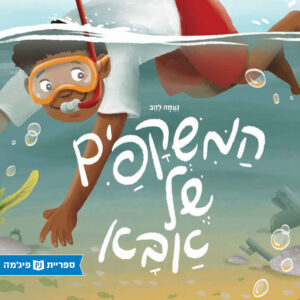 Aba’s Glasses
Aba’s Glasses 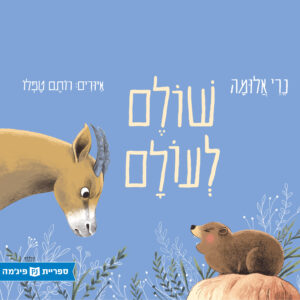 Peace to the World
Peace to the World 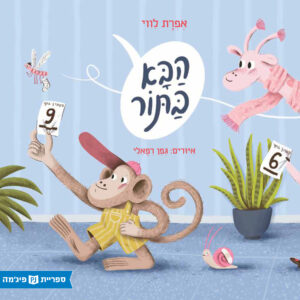 Next in Line
Next in Line 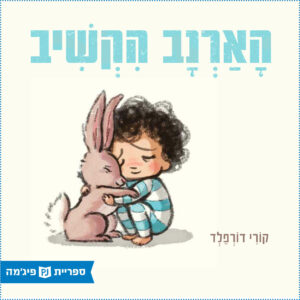 The Rabbit Listened
The Rabbit Listened 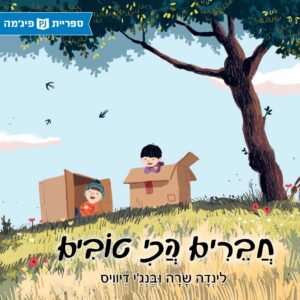 Best Friends
Best Friends 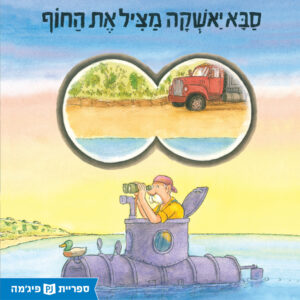 Saba Yashka Saves the Beach
Saba Yashka Saves the Beach 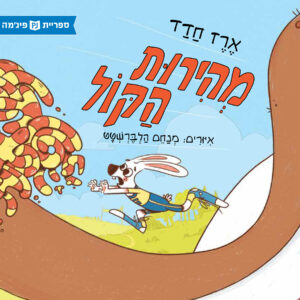 The Speed of Sound
The Speed of Sound 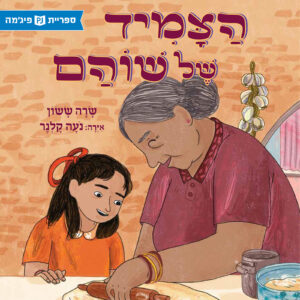 Shoham’s Bangle
Shoham’s Bangle 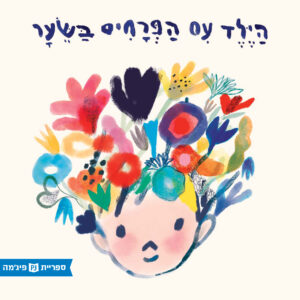 The Boy with Flowers in His Hair
The Boy with Flowers in His Hair 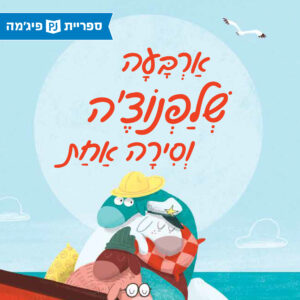 Four Shlofnoche in a Boat
Four Shlofnoche in a Boat 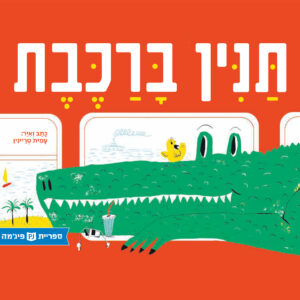 A Crocodile Gets on a Train
A Crocodile Gets on a Train 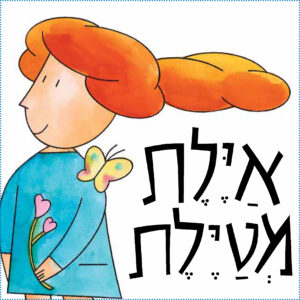 Ayelet Takes a Walk
Ayelet Takes a Walk 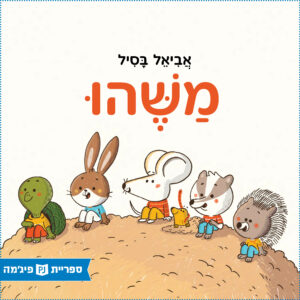 Something
Something 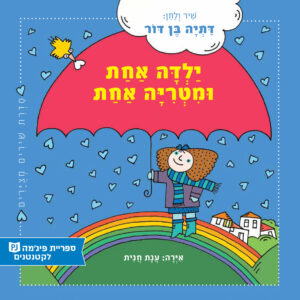 A Girl with an Umbrella
A Girl with an Umbrella 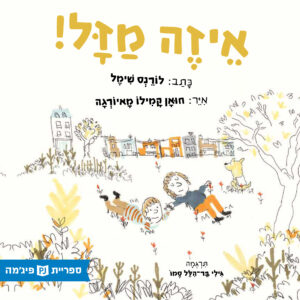 How Lucky I Am
How Lucky I Am 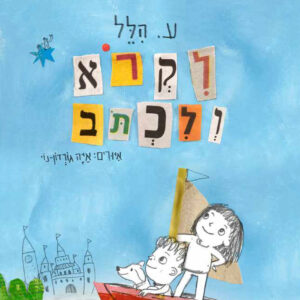 Reading and Writing
Reading and Writing 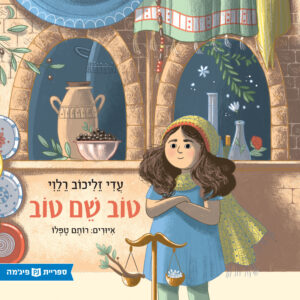 A Good Name
A Good Name 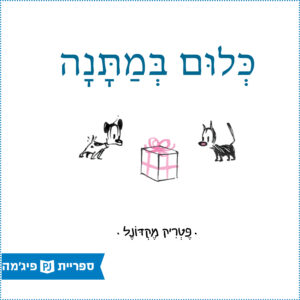 The Gift of Nothing
The Gift of Nothing 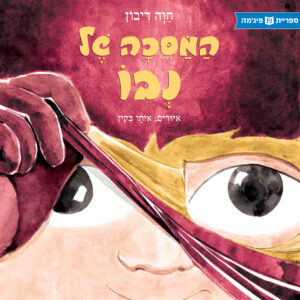 Nevo’s Mask
Nevo’s Mask 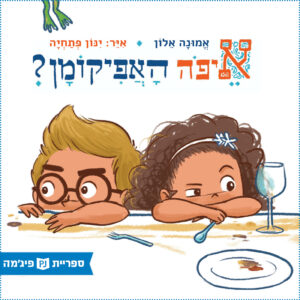 Where is the Afikomen?
Where is the Afikomen? 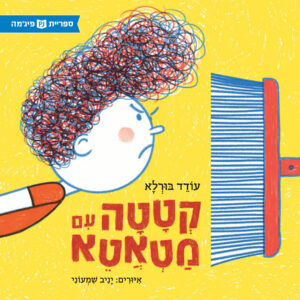 A Fight with A Broom
A Fight with A Broom 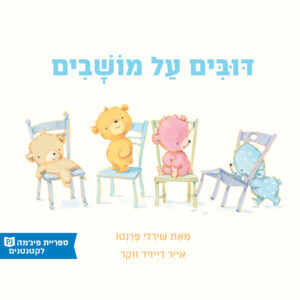 Bears on Chairs
Bears on Chairs 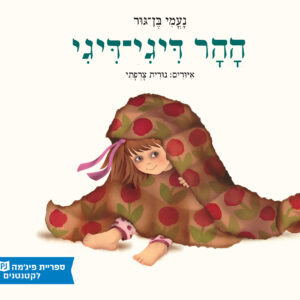 The Hill Tickle-Tickle
The Hill Tickle-Tickle 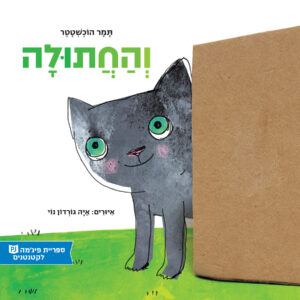 And the Cat
And the Cat 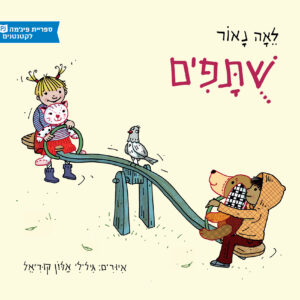 Partners
Partners 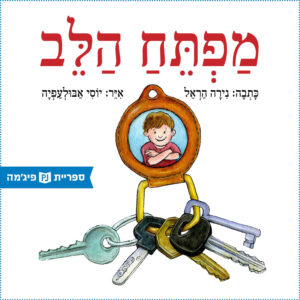 The Key to My Heart
The Key to My Heart 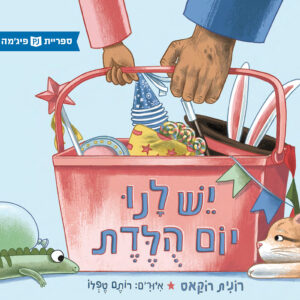 It’s Our Birthday
It’s Our Birthday 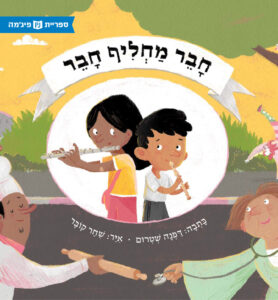 One Friend Takes Over for Another
One Friend Takes Over for Another 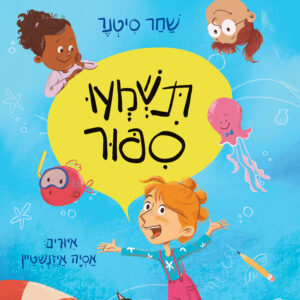 Let Me Tell You a Story
Let Me Tell You a Story 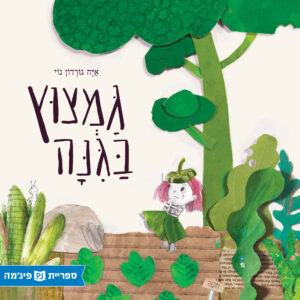 Morchella in the Garden
Morchella in the Garden 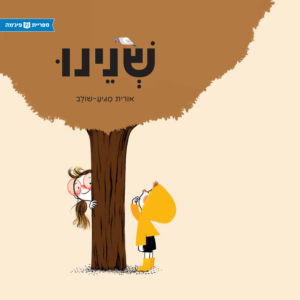 The Two of Us
The Two of Us 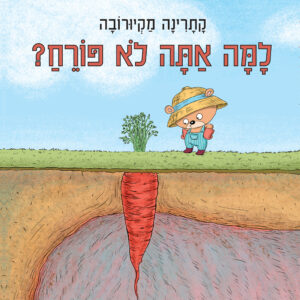 Why Don’t You Flower?
Why Don’t You Flower? 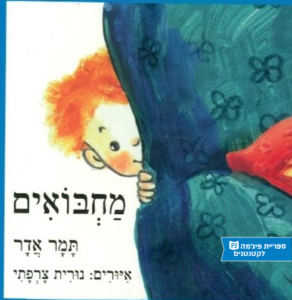 Hide & Seek
Hide & Seek 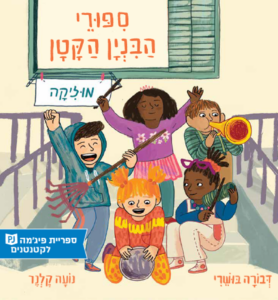 Music
Music 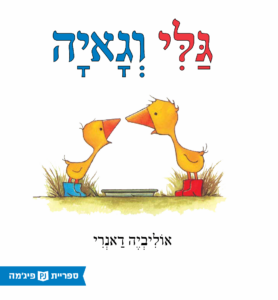 Gali & Gaya (Originally: Gossie & Gertie)
Gali & Gaya (Originally: Gossie & Gertie) 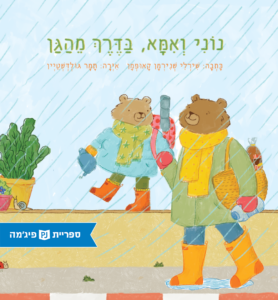 Noni and his Mom Walk Home from Kindergarten
Noni and his Mom Walk Home from Kindergarten 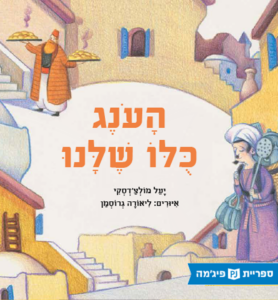 The Peddler and the Baker (Literally in Hebrew: Pleasure’s All Ours)
The Peddler and the Baker (Literally in Hebrew: Pleasure’s All Ours) 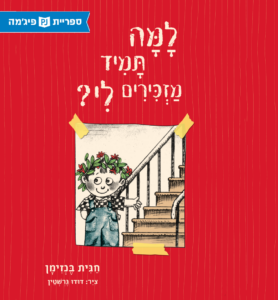 Why Do They Always Remind Me?
Why Do They Always Remind Me? 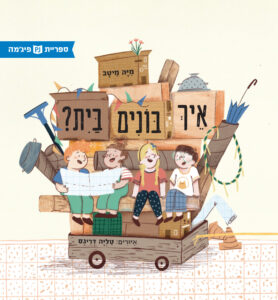 How to Build a House
How to Build a House 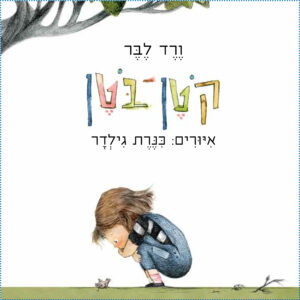 Little Peanut
Little Peanut 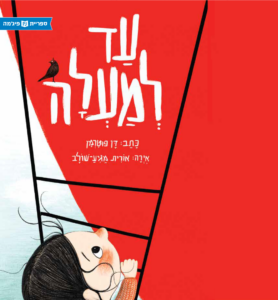 Up and Over
Up and Over 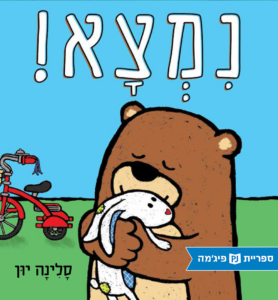 Found
Found 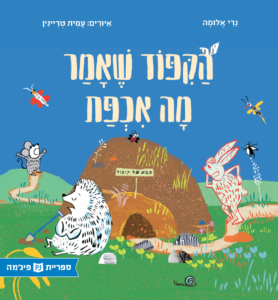 The Hedgehog Who Said: Who Cares?
The Hedgehog Who Said: Who Cares? 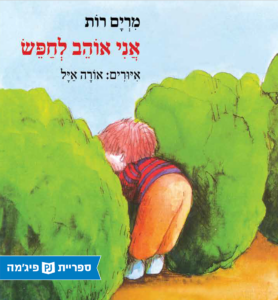 I Like to Look For…
I Like to Look For… 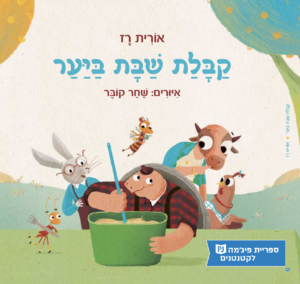 Shabbat in the Forest
Shabbat in the Forest 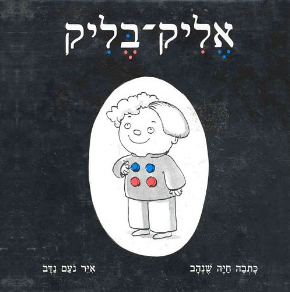 Elik Belik
Elik Belik 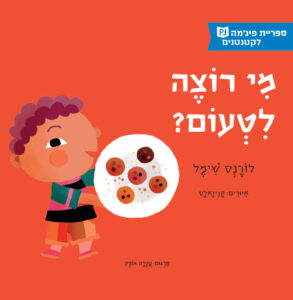 Who wants to taste?
Who wants to taste? 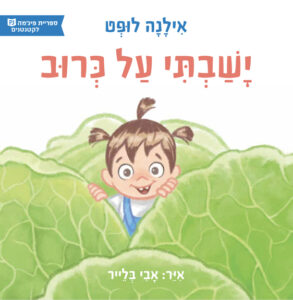 I Sat On a Cabbage
I Sat On a Cabbage 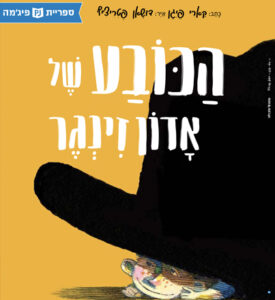 Mr. Zinger’s Hat
Mr. Zinger’s Hat 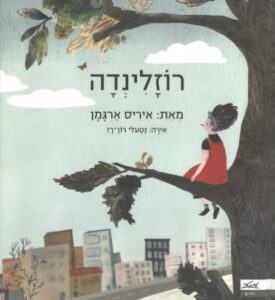 Rosalinda
Rosalinda 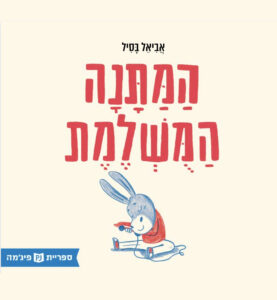 The Perfect Gift
The Perfect Gift 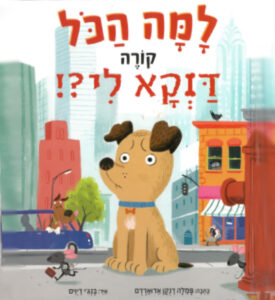 Winston was Worried
Winston was Worried 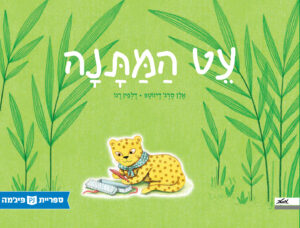 Le Cadeau (The Gift)
Le Cadeau (The Gift) 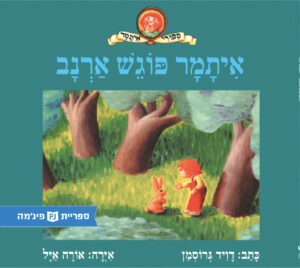 Itamar Meets a Rabbit
Itamar Meets a Rabbit 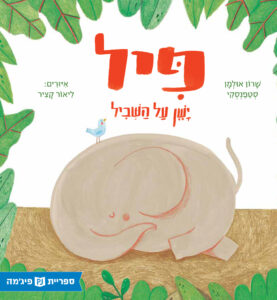 Elephant on the Path
Elephant on the Path 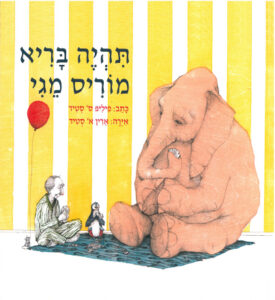 A Sick Day for Amos McGee
A Sick Day for Amos McGee 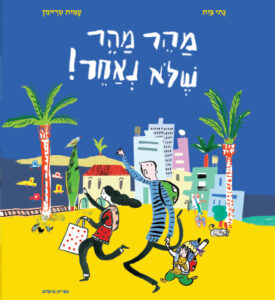 Hurry Up!
Hurry Up! 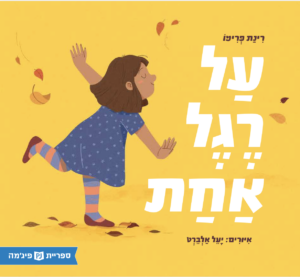 On One Foot
On One Foot 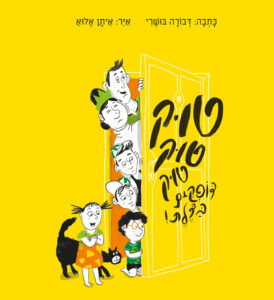 Knock Knock Knock – Knocking on the Door!
Knock Knock Knock – Knocking on the Door! 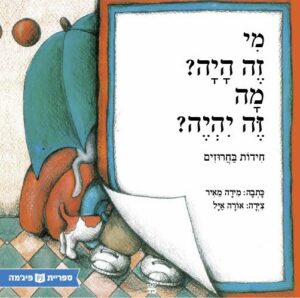 What’s That? What Could it be?
What’s That? What Could it be? 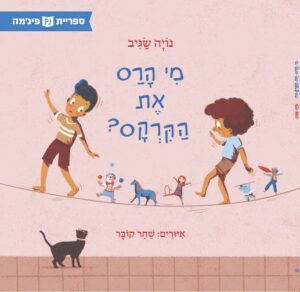 Who Destroyed the Circus?
Who Destroyed the Circus? 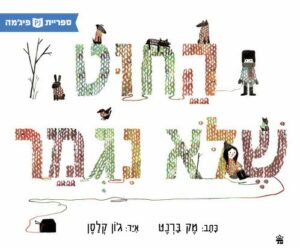 Extra Yarn
Extra Yarn 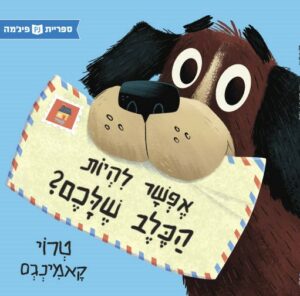 Can I Be your Dog?
Can I Be your Dog? 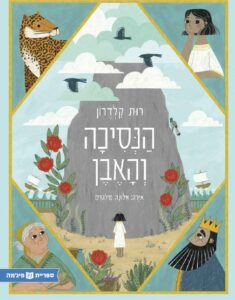 The Princess and the Rock
The Princess and the Rock 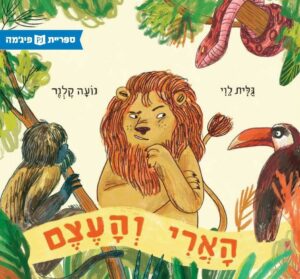 The Lion and the Bone
The Lion and the Bone 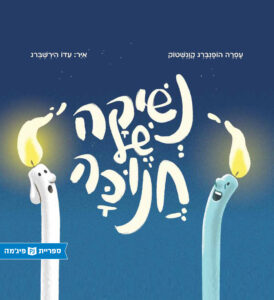 A Hanukkah Kiss
A Hanukkah Kiss 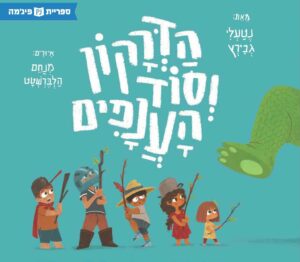 Dragonsticks
Dragonsticks 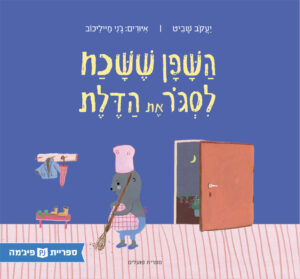 The Bunny who Forgot to Close the Door
The Bunny who Forgot to Close the Door 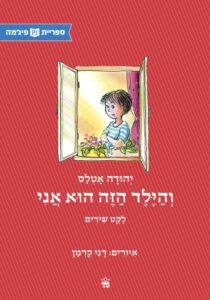 It’s Me
It’s Me 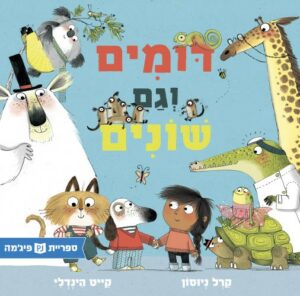 The Same but Different
The Same but Different 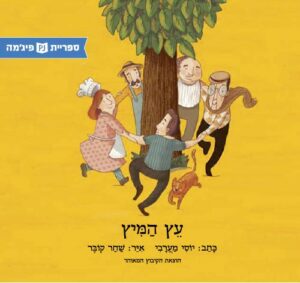 The Juice Tree
The Juice Tree 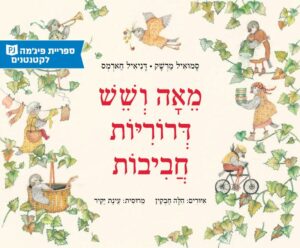 One Hundred and Six Sweet Sparrows
One Hundred and Six Sweet Sparrows 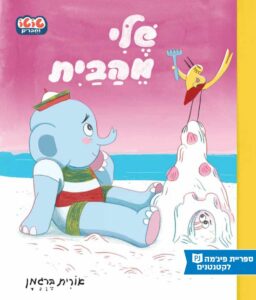 Toto & Friends: Mine!
Toto & Friends: Mine! 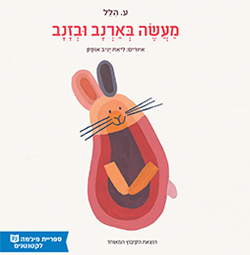 A Tale of a Rabbit and a Tail
A Tale of a Rabbit and a Tail 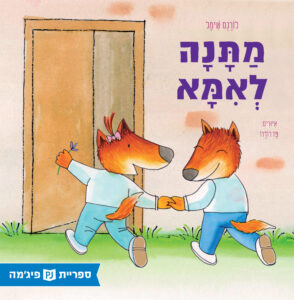 A Gift for Mama
A Gift for Mama 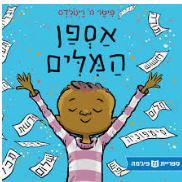 The Word Collector
The Word Collector 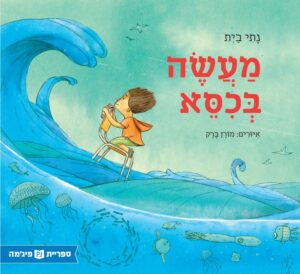 About a Chair
About a Chair 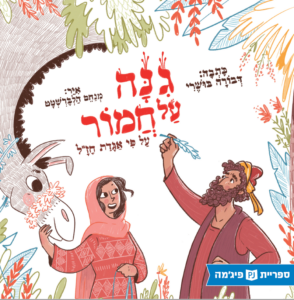 A Garden on a Donkey
A Garden on a Donkey 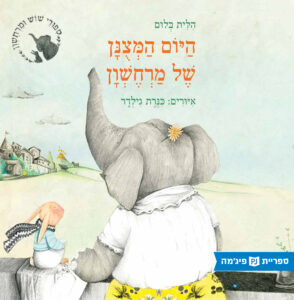 Jo and Pepper and the Big Sleep
Jo and Pepper and the Big Sleep 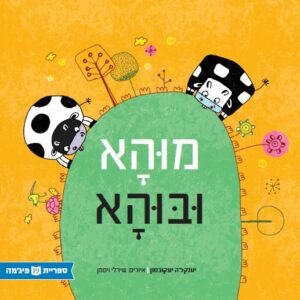 Mooha and Booha
Mooha and Booha 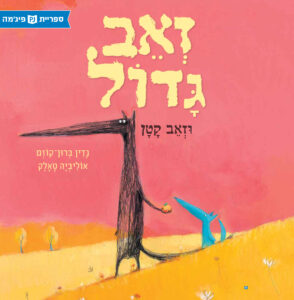 Big Wolf and Little Wolf
Big Wolf and Little Wolf 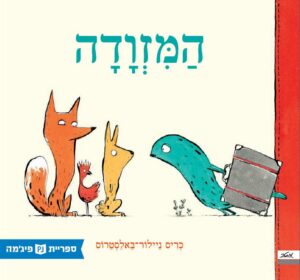 The Suitcase
The Suitcase 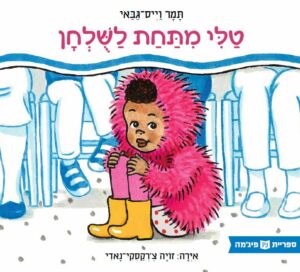 Tali is under the Table
Tali is under the Table 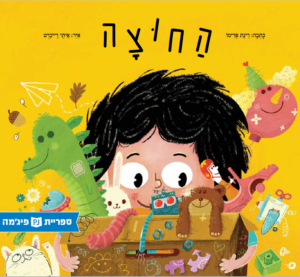 Out
Out 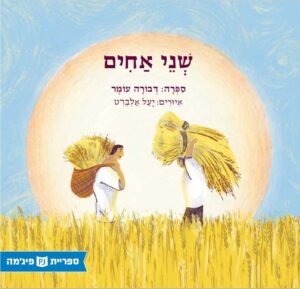 Two Brothers and the Temple Site
Two Brothers and the Temple Site 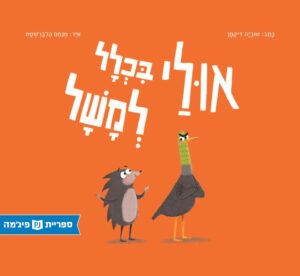 Maybe, Possibly, Perhaps
Maybe, Possibly, Perhaps 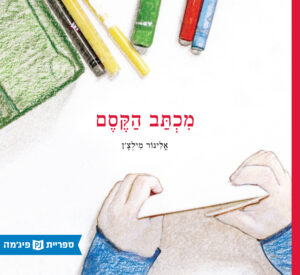 The Magical Letter
The Magical Letter 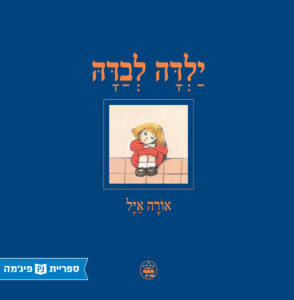 A Girl all by Herself
A Girl all by Herself 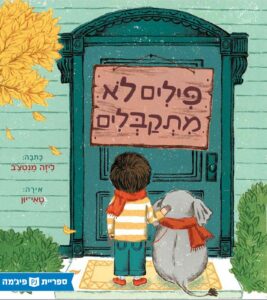 Strictly No Elephants
Strictly No Elephants 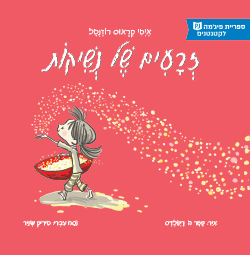 Plant a Kiss
Plant a Kiss 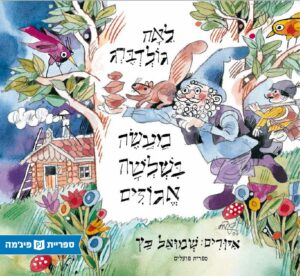 A Tale of Three Nuts
A Tale of Three Nuts 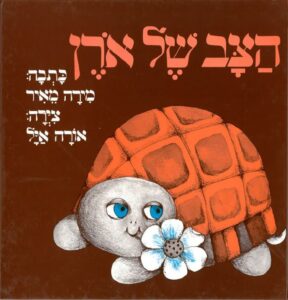 Oren’s Turtle
Oren’s Turtle 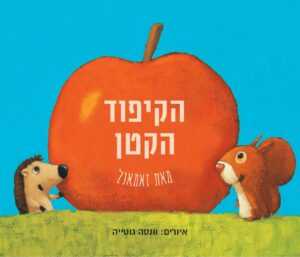 Little Hedgehog
Little Hedgehog  A Rabbit and a Cat are going on a Trip
A Rabbit and a Cat are going on a Trip 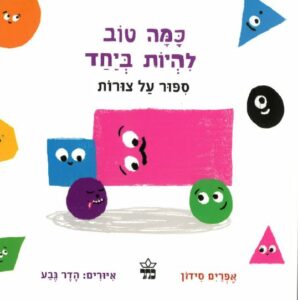 Friendly Shapes
Friendly Shapes 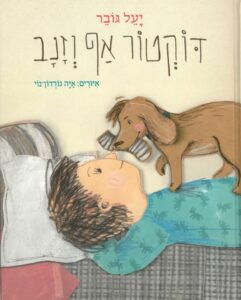 Doctor Yoyo
Doctor Yoyo 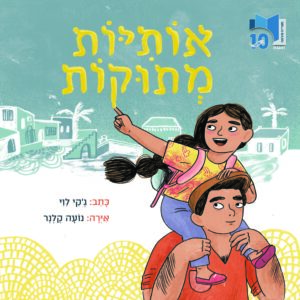 Sweet Aleph-Bet
Sweet Aleph-Bet 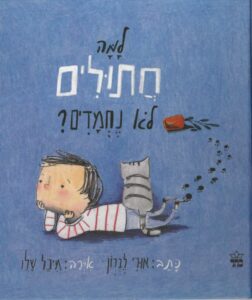 Why aren’t Cats Nice?
Why aren’t Cats Nice? 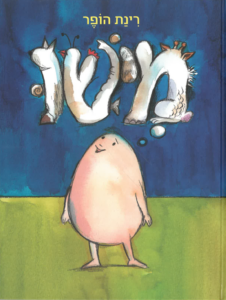 Somebody
Somebody 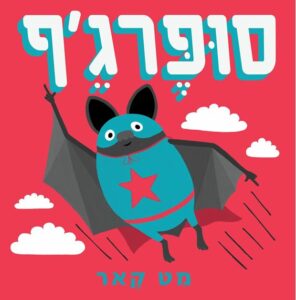 Superbat
Superbat 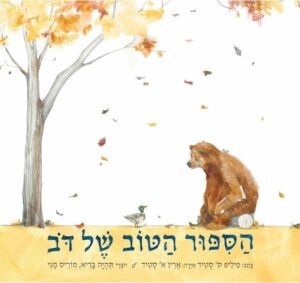 Bear has a Story to Tell
Bear has a Story to Tell 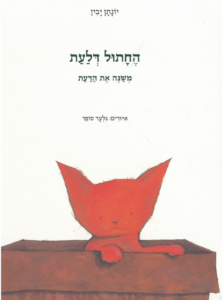 Pumpkin the Kitten
Pumpkin the Kitten 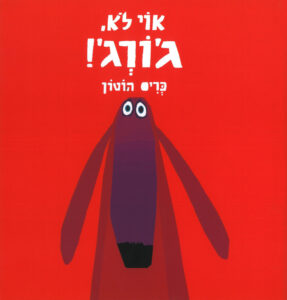 Oh No, George!
Oh No, George! 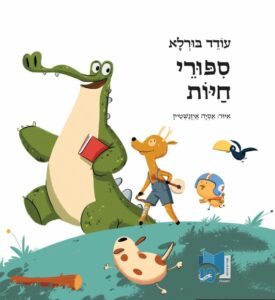 Animal Stories
Animal Stories 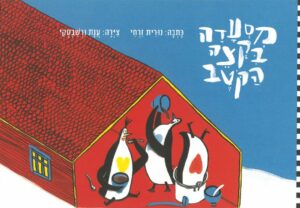 The Cooking Penguins
The Cooking Penguins 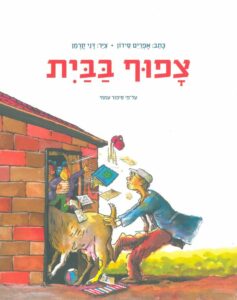 It’s Crowded at Home
It’s Crowded at Home 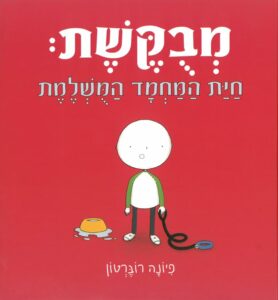 Wanted: The Perfect Pet
Wanted: The Perfect Pet 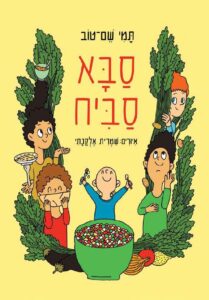 Sabba Sabich
Sabba Sabich 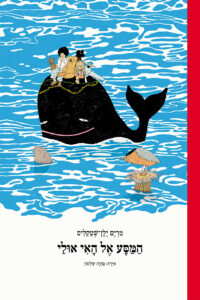 The Journey to the Island of Maybe
The Journey to the Island of Maybe 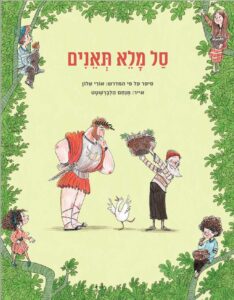 A Basket Full of Figs
A Basket Full of Figs 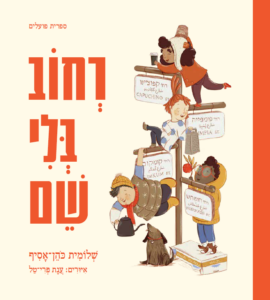 A Street with no Name
A Street with no Name 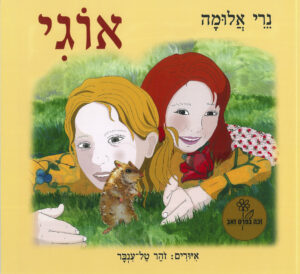 Ogi
Ogi 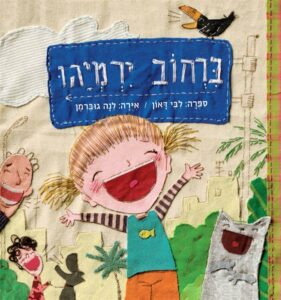 Yirmiyahu Street
Yirmiyahu Street 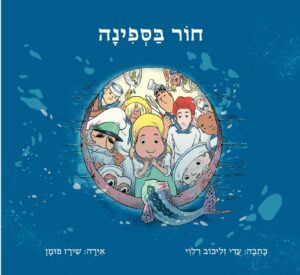 A Hole in the Ship
A Hole in the Ship 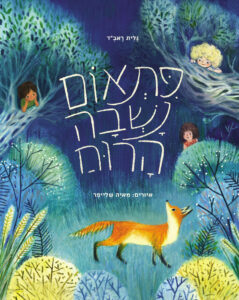 At the Heart of the Orchard
At the Heart of the Orchard 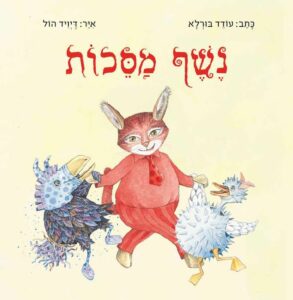 Masquerade
Masquerade 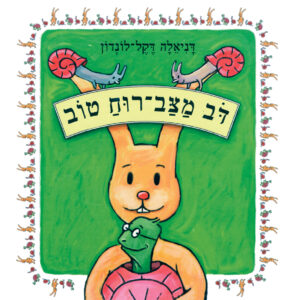 Good Mood Bear
Good Mood Bear 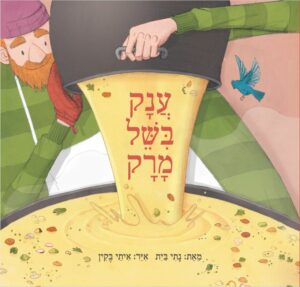 The Giant is Cooking Soup
The Giant is Cooking Soup 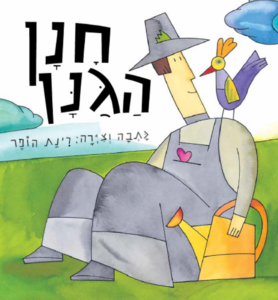 Hannan the Gardener
Hannan the Gardener 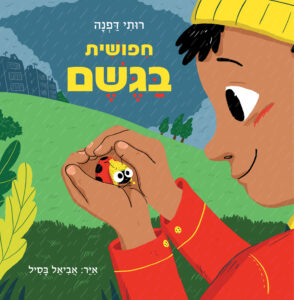 The Ladybird in the Rain
The Ladybird in the Rain 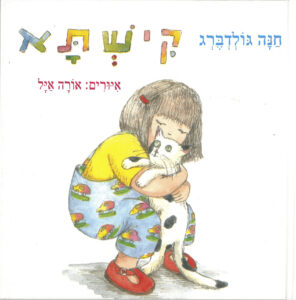 Kishta
Kishta 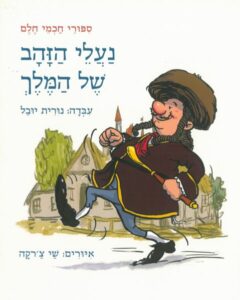 The King’s Golden Shoes
The King’s Golden Shoes 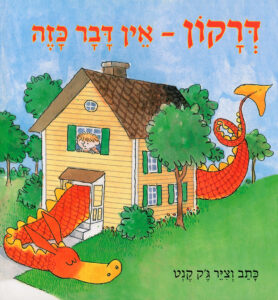 There’s No Such Thing as a Dragon
There’s No Such Thing as a Dragon 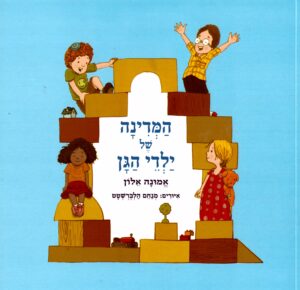 Land of Preschool Children
Land of Preschool Children 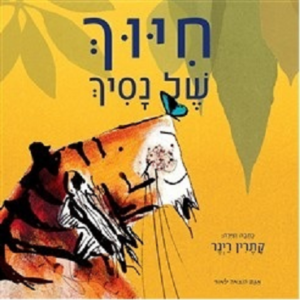 Augustus and his Smile (Hebrew title: Prince’s Smile)
Augustus and his Smile (Hebrew title: Prince’s Smile) 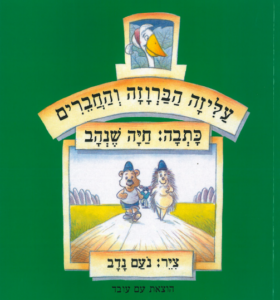 Aliza the Duck and Friends
Aliza the Duck and Friends 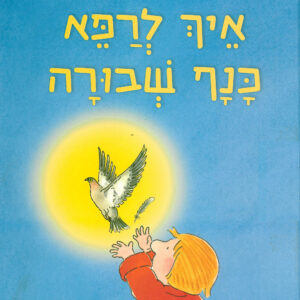 How to Heal a Broken Wing
How to Heal a Broken Wing 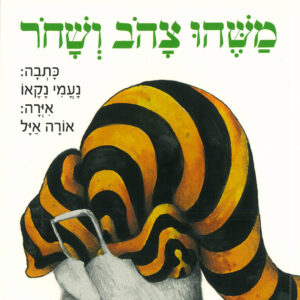 Something Yellow and Black
Something Yellow and Black 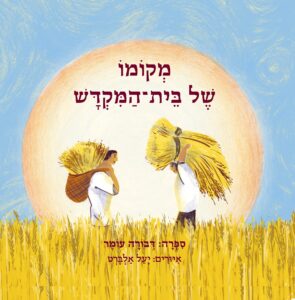 The Site of the Temple
The Site of the Temple 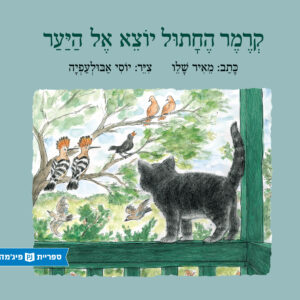 Kramer the Cat Goes into the Forest
Kramer the Cat Goes into the Forest 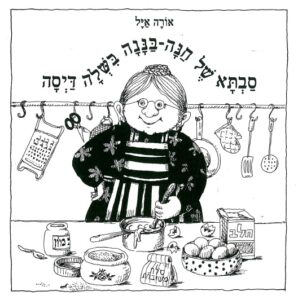 Hannah Banana’s Granny Cooked Porridge
Hannah Banana’s Granny Cooked Porridge 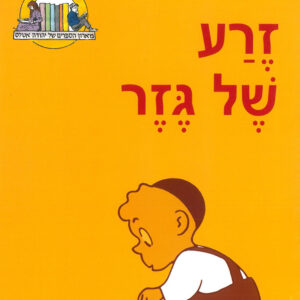 The Carrot Seed
The Carrot Seed 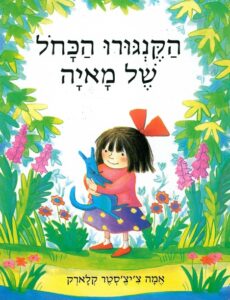 Maya’s Blue Kangaroo
Maya’s Blue Kangaroo 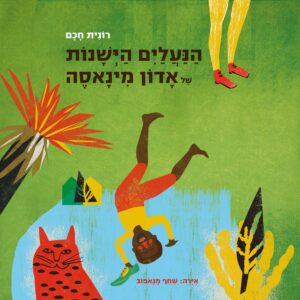 An Old Pair of Shoes
An Old Pair of Shoes 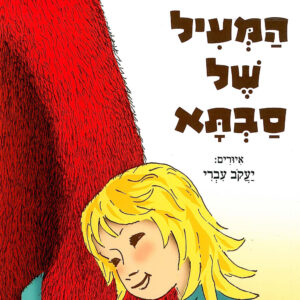 Grandmother’s Coat
Grandmother’s Coat 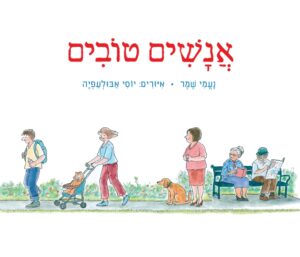 Good People
Good People 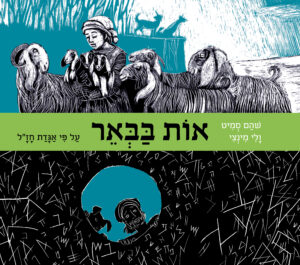 Signs in the Well – Based on a Talmudic tale
Signs in the Well – Based on a Talmudic tale 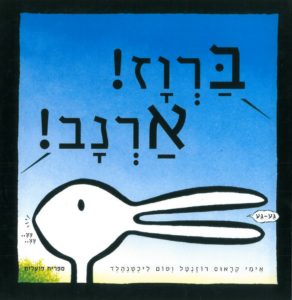 Duck! Rabbit!
Duck! Rabbit! 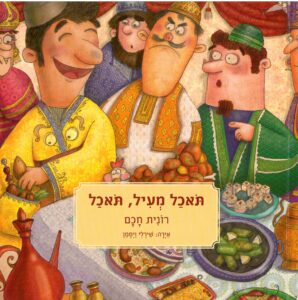 Eat, Coat, Eat!
Eat, Coat, Eat! 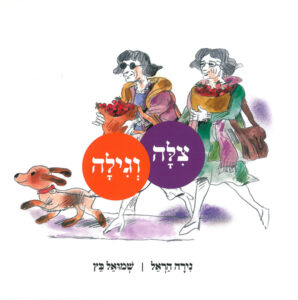 Tsila and Gila
Tsila and Gila 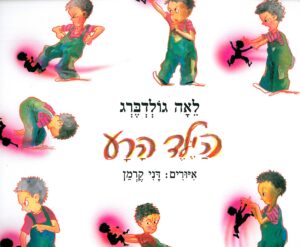 The Naughty Boy
The Naughty Boy 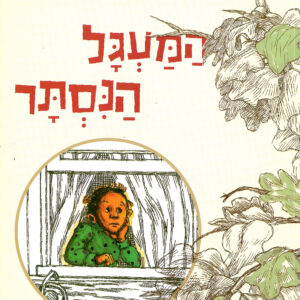 A Circle of Friends
A Circle of Friends 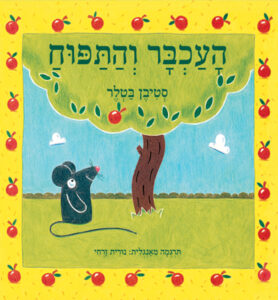 The Mouse and the Apple
The Mouse and the Apple 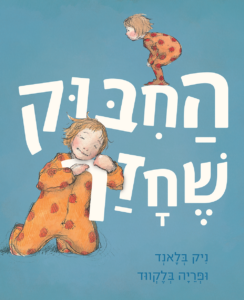 The Runaway Hug
The Runaway Hug 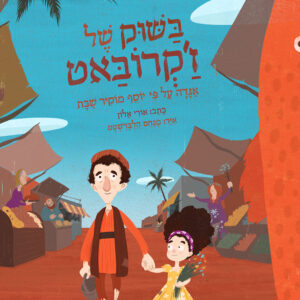 In the Market of Zhakrobat
In the Market of Zhakrobat 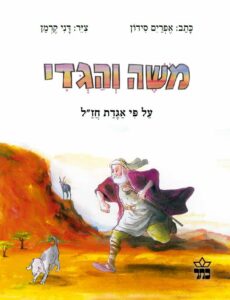 Moses and the Baby Goat
Moses and the Baby Goat 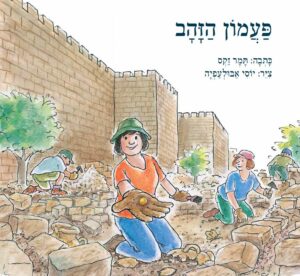 The Golden Bell
The Golden Bell 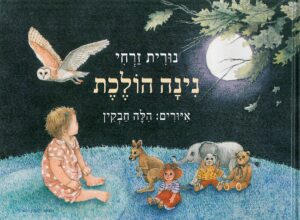 Nina Walks
Nina Walks 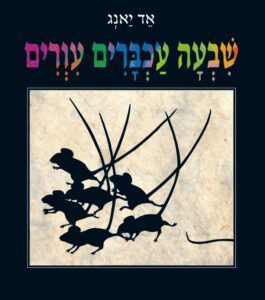 Seven Blind Mice
Seven Blind Mice 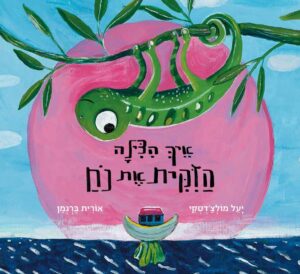 How the Chameleon Saved Noah
How the Chameleon Saved Noah 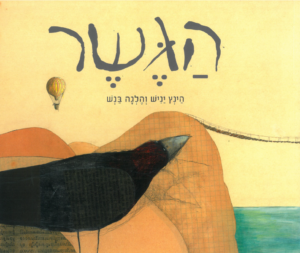 The Bridge
The Bridge 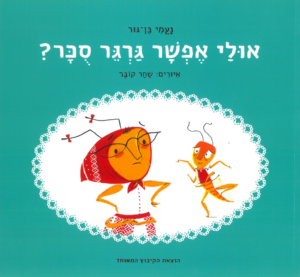 Can you Spare a Spot of Sugar
Can you Spare a Spot of Sugar 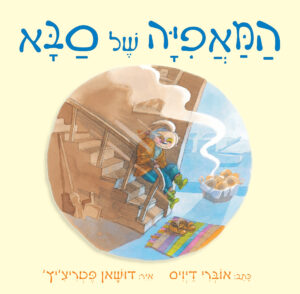 Bagels From Benny
Bagels From Benny 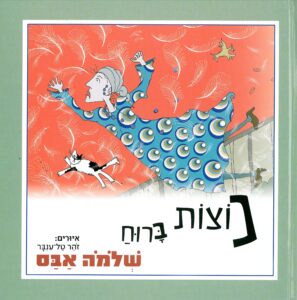 Feathers in the wind
Feathers in the wind 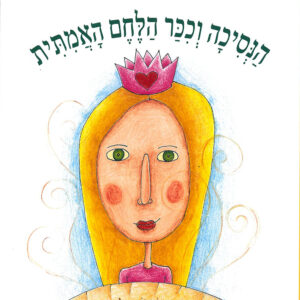 The Princess and the True Loaf of Bread
The Princess and the True Loaf of Bread 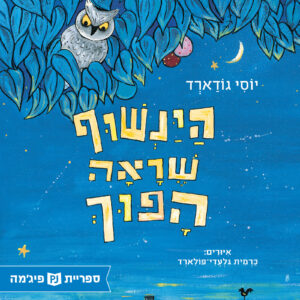 The Backward Owl
The Backward Owl 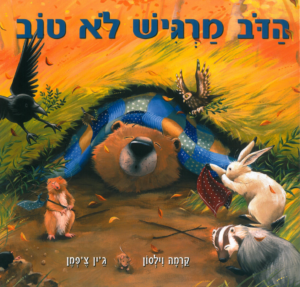 Bear Feels Sick
Bear Feels Sick 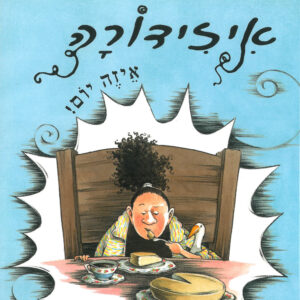 Mrs. Biddlebox In Hebrew, “Isadora, What a Day”
Mrs. Biddlebox In Hebrew, “Isadora, What a Day” 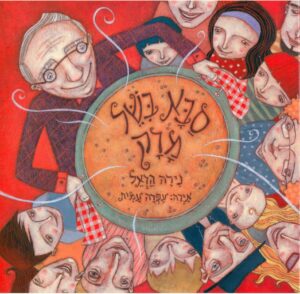 Grandpa Made Soup
Grandpa Made Soup 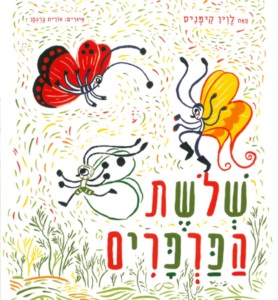 The Three Butterflies
The Three Butterflies 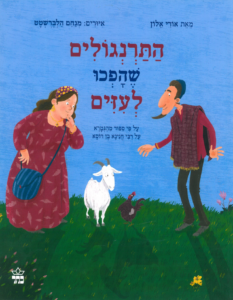 The Chickens Who Became Goats
The Chickens Who Became Goats 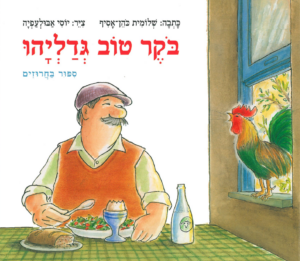 Good Morning, MrGedalyahu
Good Morning, MrGedalyahu 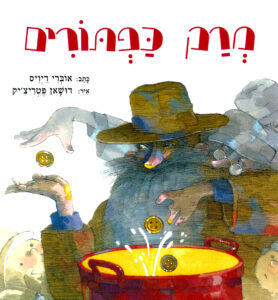 Bone Button Borscht
Bone Button Borscht 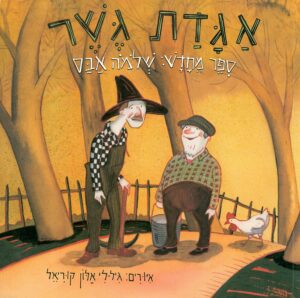 The Bridge Tale
The Bridge Tale 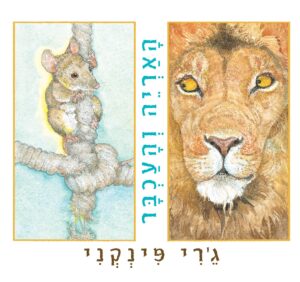 The Lion and the Mouse
The Lion and the Mouse 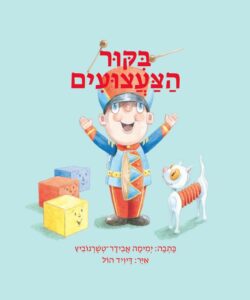 The Toys’ Visit
The Toys’ Visit 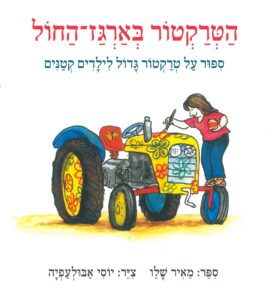 The Tractor in the Sandbox
The Tractor in the Sandbox 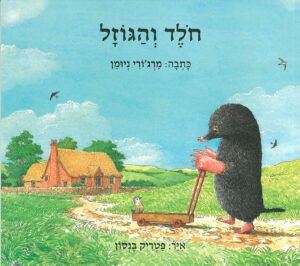 Mole and the Baby Bird
Mole and the Baby Bird 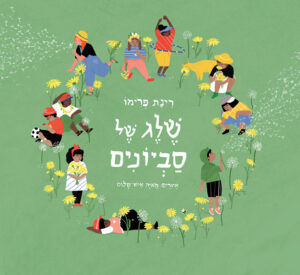 Snow of Dandelions
Snow of Dandelions 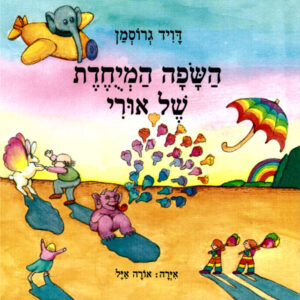 Ury’s Special Language
Ury’s Special Language 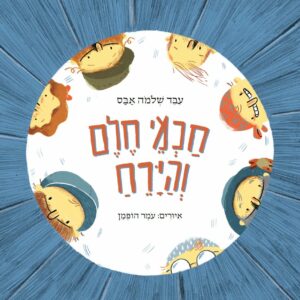 The People of Chełm and the Moon
The People of Chełm and the Moon 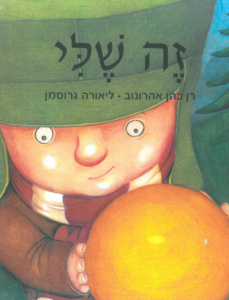 It’s Mine
It’s Mine 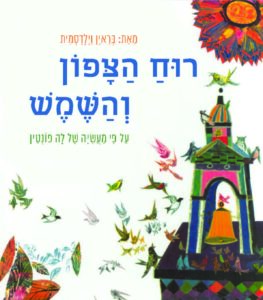 The North Wind and the Sun
The North Wind and the Sun 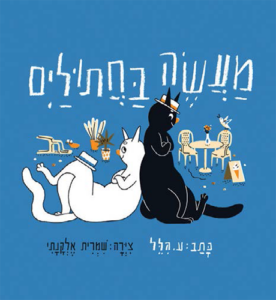 A Tale of Two Cats
A Tale of Two Cats 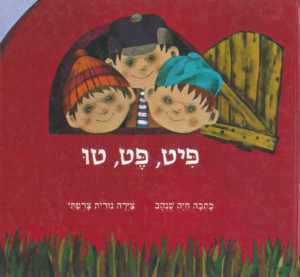 Pit, Pet, Tu (“Chit, Chat, Chatter”)
Pit, Pet, Tu (“Chit, Chat, Chatter”) 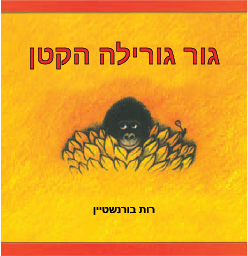 Little Gorilla
Little Gorilla 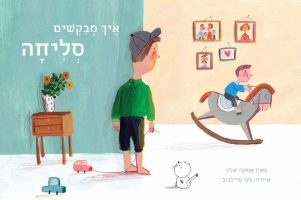 How do you say “I’m sorry”?
How do you say “I’m sorry”? 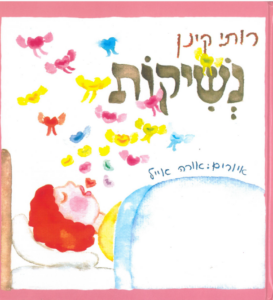 Kisses
Kisses 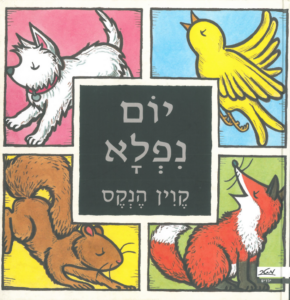 A Good Day
A Good Day 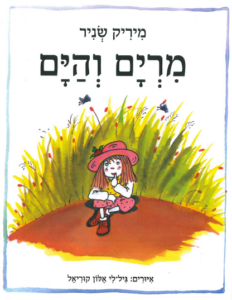 Miriam and the Sea
Miriam and the Sea 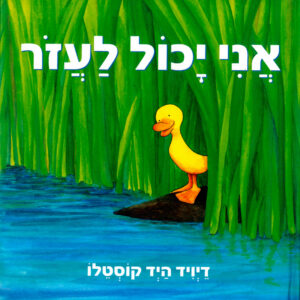 I Can Help
I Can Help 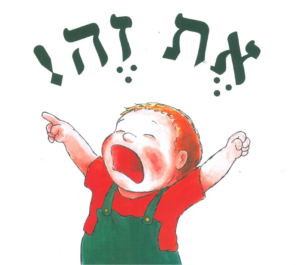 That One!
That One! 




















